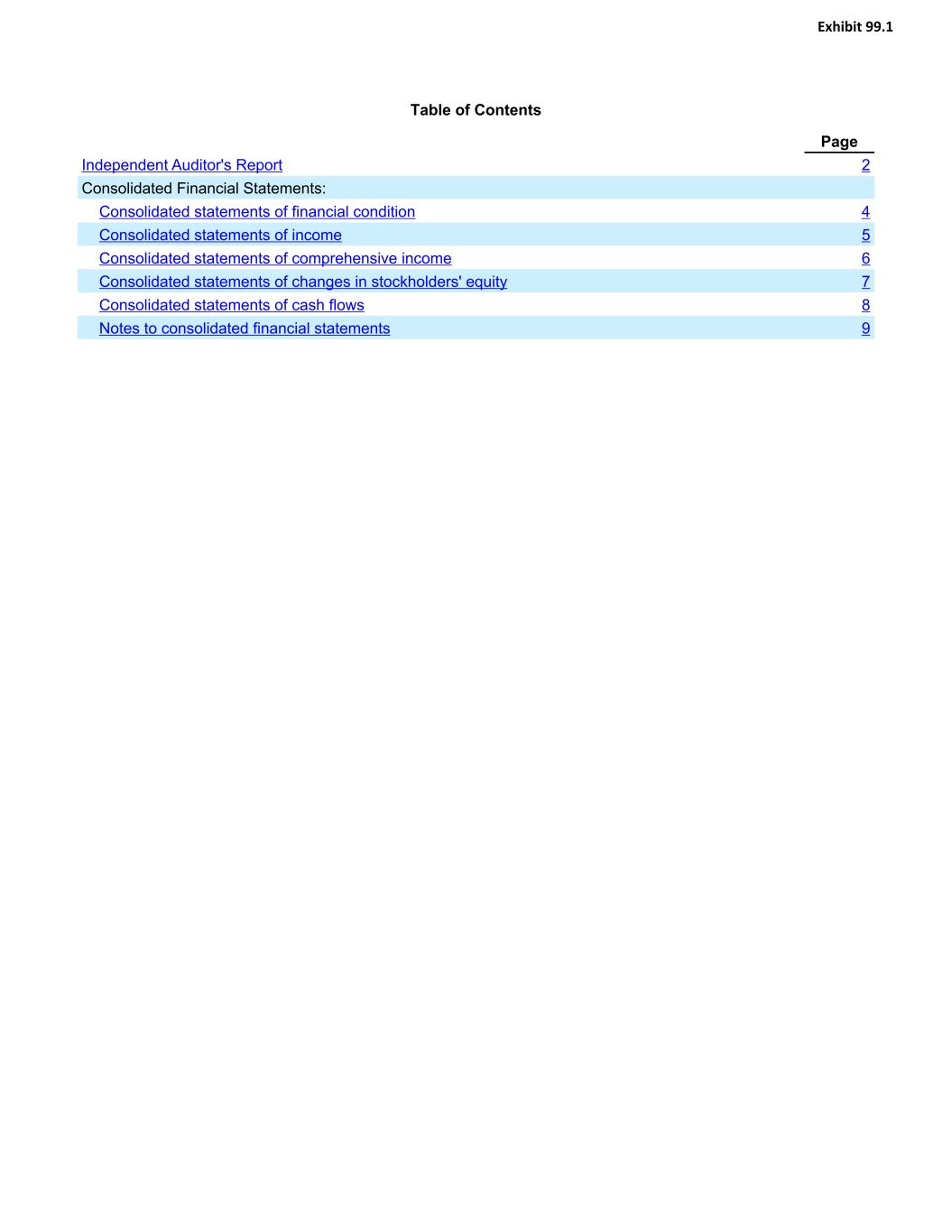
Table of Contents Page Independent Auditor's Report 2 Consolidated Financial Statements: Consolidated statements of financial condition 4 Consolidated statements of income 5 Consolidated statements of comprehensive income 6 Consolidated statements of changes in stockholders' equity 7 Consolidated statements of cash flows 8 Notes to consolidated financial statements 9 Exhibit 99.1
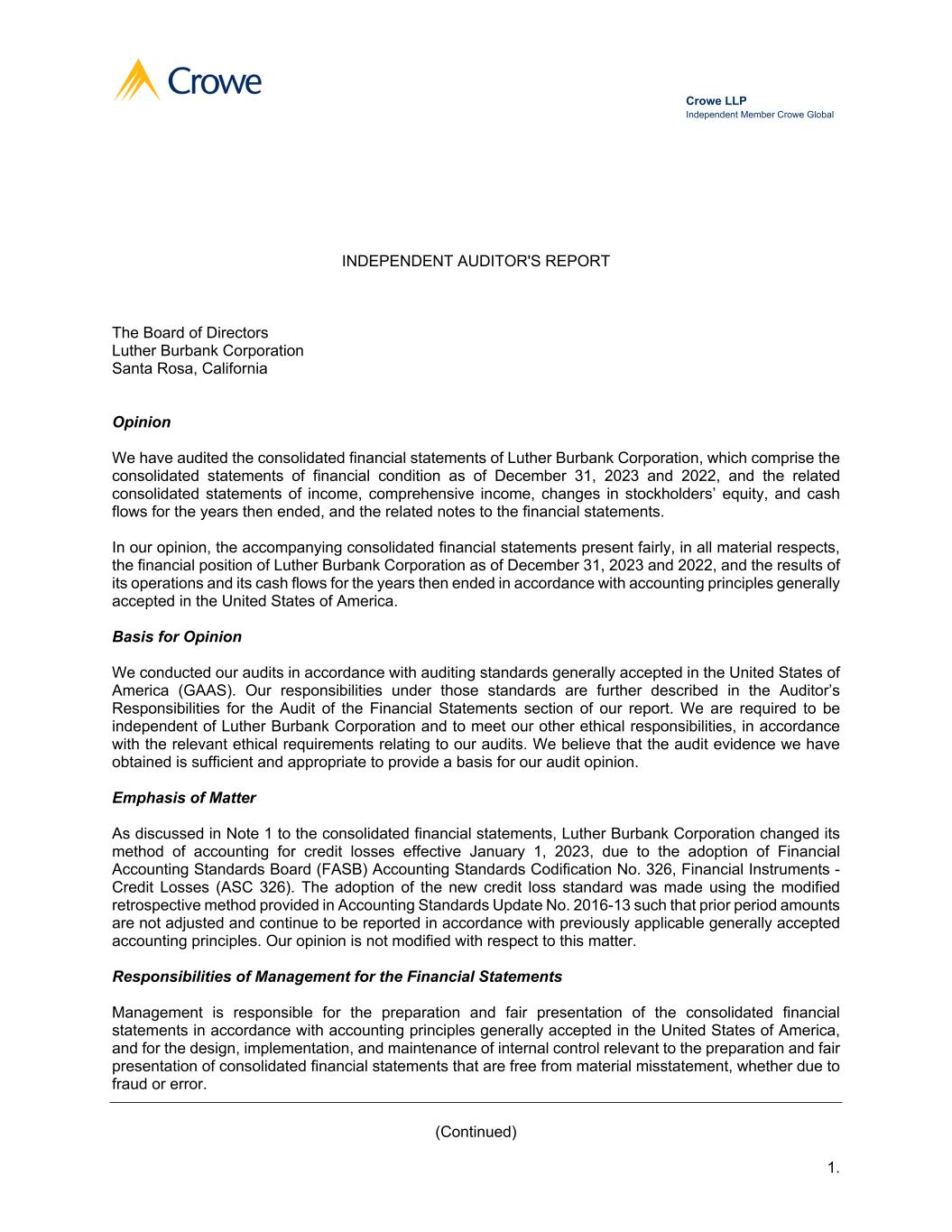
Crowe LLP Independent Member Crowe Global (Continued) 1. INDEPENDENT AUDITOR'S REPORT The Board of Directors Luther Burbank Corporation Santa Rosa, California Opinion We have audited the consolidated financial statements of Luther Burbank Corporation, which comprise the consolidated statements of financial condition as of December 31, 2023 and 2022, and the related consolidated statements of income, comprehensive income, changes in stockholders’ equity, and cash flows for the years then ended, and the related notes to the financial statements. In our opinion, the accompanying consolidated financial statements present fairly, in all material respects, the financial position of Luther Burbank Corporation as of December 31, 2023 and 2022, and the results of its operations and its cash flows for the years then ended in accordance with accounting principles generally accepted in the United States of America. Basis for Opinion We conducted our audits in accordance with auditing standards generally accepted in the United States of America (GAAS). Our responsibilities under those standards are further described in the Auditor’s Responsibilities for the Audit of the Financial Statements section of our report. We are required to be independent of Luther Burbank Corporation and to meet our other ethical responsibilities, in accordance with the relevant ethical requirements relating to our audits. We believe that the audit evidence we have obtained is sufficient and appropriate to provide a basis for our audit opinion. Emphasis of Matter As discussed in Note 1 to the consolidated financial statements, Luther Burbank Corporation changed its method of accounting for credit losses effective January 1, 2023, due to the adoption of Financial Accounting Standards Board (FASB) Accounting Standards Codification No. 326, Financial Instruments - Credit Losses (ASC 326). The adoption of the new credit loss standard was made using the modified retrospective method provided in Accounting Standards Update No. 2016-13 such that prior period amounts are not adjusted and continue to be reported in accordance with previously applicable generally accepted accounting principles. Our opinion is not modified with respect to this matter. Responsibilities of Management for the Financial Statements Management is responsible for the preparation and fair presentation of the consolidated financial statements in accordance with accounting principles generally accepted in the United States of America, and for the design, implementation, and maintenance of internal control relevant to the preparation and fair presentation of consolidated financial statements that are free from material misstatement, whether due to fraud or error.
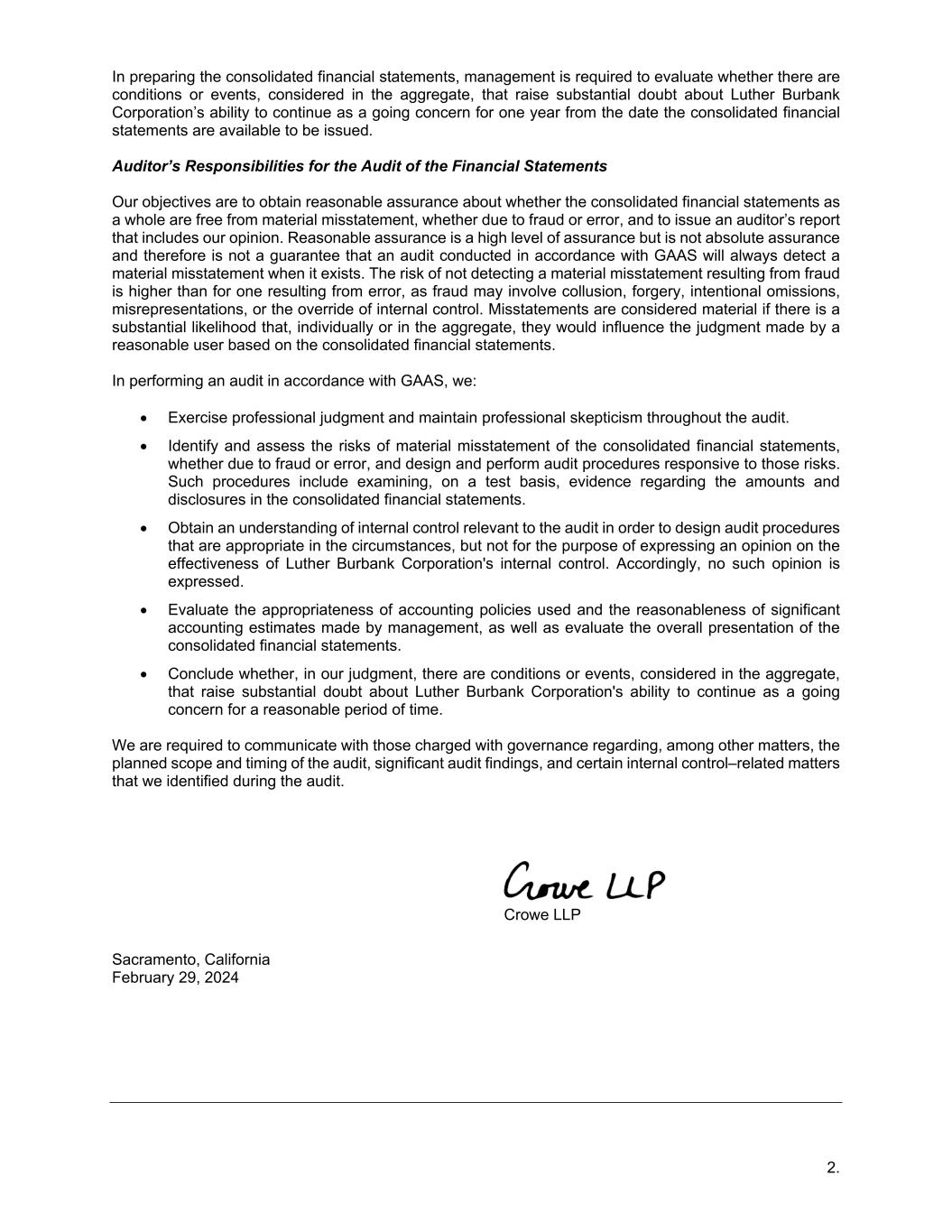
2. In preparing the consolidated financial statements, management is required to evaluate whether there are conditions or events, considered in the aggregate, that raise substantial doubt about Luther Burbank Corporation’s ability to continue as a going concern for one year from the date the consolidated financial statements are available to be issued. Auditor’s Responsibilities for the Audit of the Financial Statements Our objectives are to obtain reasonable assurance about whether the consolidated financial statements as a whole are free from material misstatement, whether due to fraud or error, and to issue an auditor’s report that includes our opinion. Reasonable assurance is a high level of assurance but is not absolute assurance and therefore is not a guarantee that an audit conducted in accordance with GAAS will always detect a material misstatement when it exists. The risk of not detecting a material misstatement resulting from fraud is higher than for one resulting from error, as fraud may involve collusion, forgery, intentional omissions, misrepresentations, or the override of internal control. Misstatements are considered material if there is a substantial likelihood that, individually or in the aggregate, they would influence the judgment made by a reasonable user based on the consolidated financial statements. In performing an audit in accordance with GAAS, we: Exercise professional judgment and maintain professional skepticism throughout the audit. Identify and assess the risks of material misstatement of the consolidated financial statements, whether due to fraud or error, and design and perform audit procedures responsive to those risks. Such procedures include examining, on a test basis, evidence regarding the amounts and disclosures in the consolidated financial statements. Obtain an understanding of internal control relevant to the audit in order to design audit procedures that are appropriate in the circumstances, but not for the purpose of expressing an opinion on the effectiveness of Luther Burbank Corporation's internal control. Accordingly, no such opinion is expressed. Evaluate the appropriateness of accounting policies used and the reasonableness of significant accounting estimates made by management, as well as evaluate the overall presentation of the consolidated financial statements. Conclude whether, in our judgment, there are conditions or events, considered in the aggregate, that raise substantial doubt about Luther Burbank Corporation's ability to continue as a going concern for a reasonable period of time. We are required to communicate with those charged with governance regarding, among other matters, the planned scope and timing of the audit, significant audit findings, and certain internal control–related matters that we identified during the audit. Crowe LLP Sacramento, California February 29, 2024
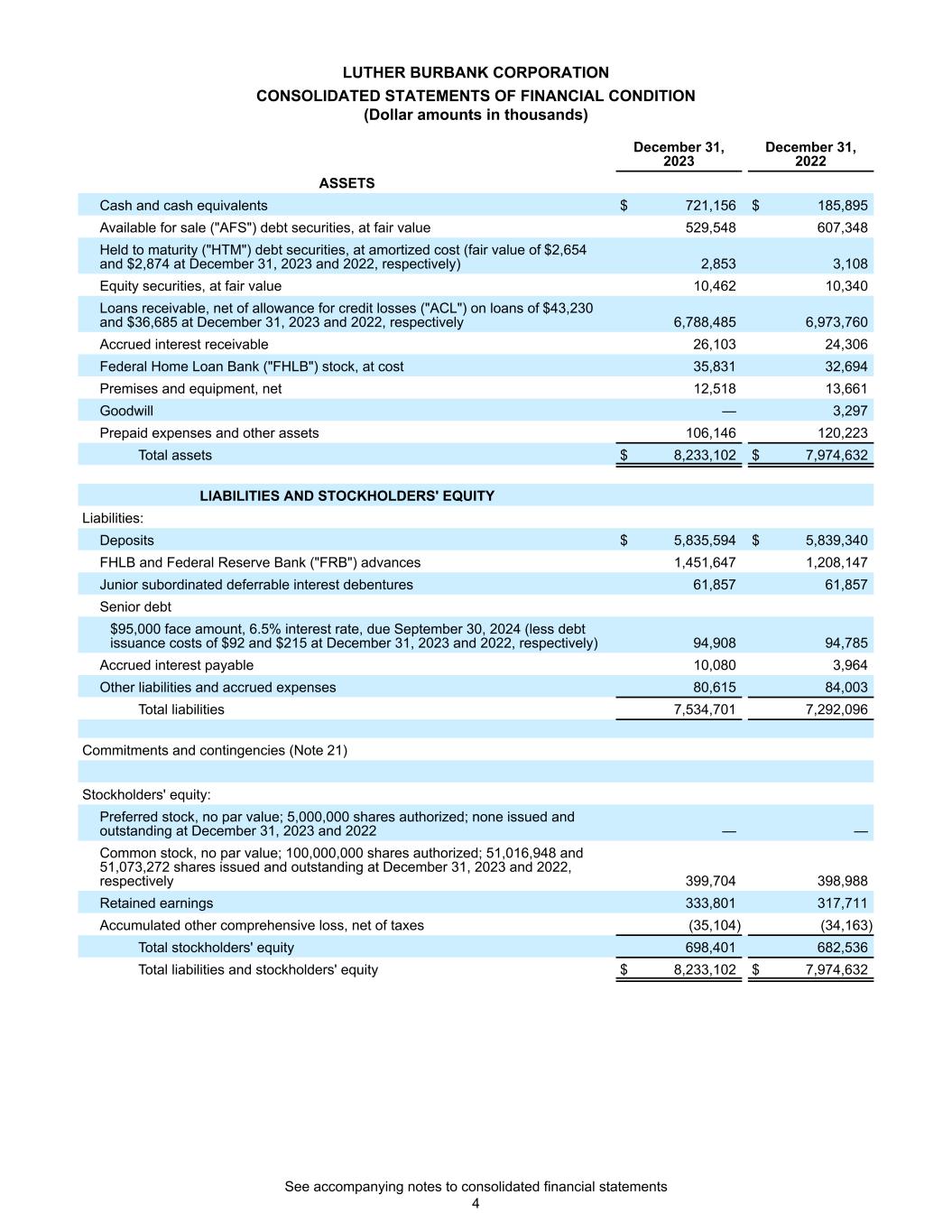
LUTHER BURBANK CORPORATION CONSOLIDATED STATEMENTS OF FINANCIAL CONDITION (Dollar amounts in thousands) December 31, 2023 December 31, 2022 ASSETS Cash and cash equivalents $ 721,156 $ 185,895 Available for sale ("AFS") debt securities, at fair value 529,548 607,348 Held to maturity ("HTM") debt securities, at amortized cost (fair value of $2,654 and $2,874 at December 31, 2023 and 2022, respectively) 2,853 3,108 Equity securities, at fair value 10,462 10,340 Loans receivable, net of allowance for credit losses ("ACL") on loans of $43,230 and $36,685 at December 31, 2023 and 2022, respectively 6,788,485 6,973,760 Accrued interest receivable 26,103 24,306 Federal Home Loan Bank ("FHLB") stock, at cost 35,831 32,694 Premises and equipment, net 12,518 13,661 Goodwill — 3,297 Prepaid expenses and other assets 106,146 120,223 Total assets $ 8,233,102 $ 7,974,632 LIABILITIES AND STOCKHOLDERS' EQUITY Liabilities: Deposits $ 5,835,594 $ 5,839,340 FHLB and Federal Reserve Bank ("FRB") advances 1,451,647 1,208,147 Junior subordinated deferrable interest debentures 61,857 61,857 Senior debt $95,000 face amount, 6.5% interest rate, due September 30, 2024 (less debt issuance costs of $92 and $215 at December 31, 2023 and 2022, respectively) 94,908 94,785 Accrued interest payable 10,080 3,964 Other liabilities and accrued expenses 80,615 84,003 Total liabilities 7,534,701 7,292,096 Commitments and contingencies (Note 21) Stockholders' equity: Preferred stock, no par value; 5,000,000 shares authorized; none issued and outstanding at December 31, 2023 and 2022 — — Common stock, no par value; 100,000,000 shares authorized; 51,016,948 and 51,073,272 shares issued and outstanding at December 31, 2023 and 2022, respectively 399,704 398,988 Retained earnings 333,801 317,711 Accumulated other comprehensive loss, net of taxes (35,104) (34,163) Total stockholders' equity 698,401 682,536 Total liabilities and stockholders' equity $ 8,233,102 $ 7,974,632 See accompanying notes to consolidated financial statements 4
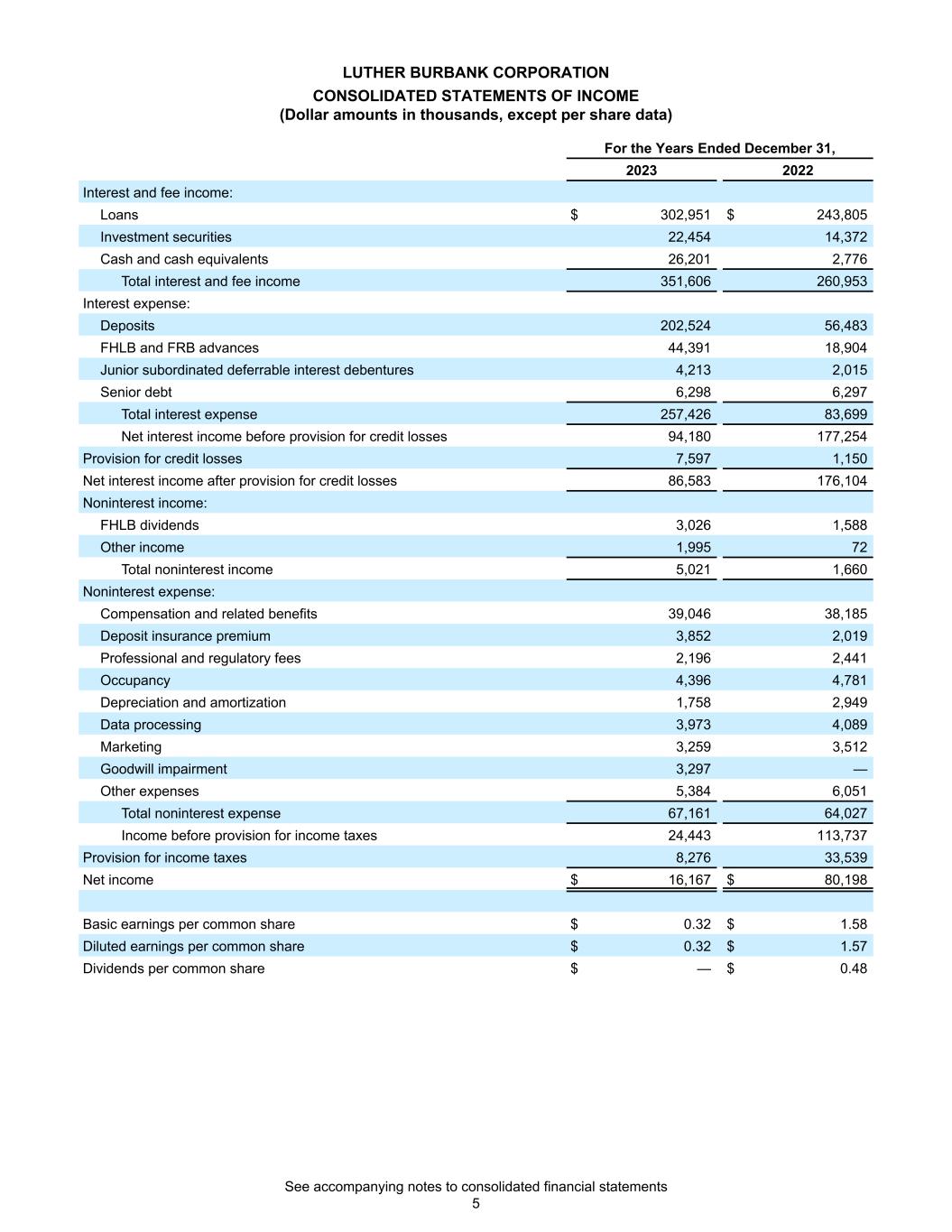
LUTHER BURBANK CORPORATION CONSOLIDATED STATEMENTS OF INCOME (Dollar amounts in thousands, except per share data) For the Years Ended December 31, 2023 2022 Interest and fee income: Loans $ 302,951 $ 243,805 Investment securities 22,454 14,372 Cash and cash equivalents 26,201 2,776 Total interest and fee income 351,606 260,953 Interest expense: Deposits 202,524 56,483 FHLB and FRB advances 44,391 18,904 Junior subordinated deferrable interest debentures 4,213 2,015 Senior debt 6,298 6,297 Total interest expense 257,426 83,699 Net interest income before provision for credit losses 94,180 177,254 Provision for credit losses 7,597 1,150 Net interest income after provision for credit losses 86,583 176,104 Noninterest income: FHLB dividends 3,026 1,588 Other income 1,995 72 Total noninterest income 5,021 1,660 Noninterest expense: Compensation and related benefits 39,046 38,185 Deposit insurance premium 3,852 2,019 Professional and regulatory fees 2,196 2,441 Occupancy 4,396 4,781 Depreciation and amortization 1,758 2,949 Data processing 3,973 4,089 Marketing 3,259 3,512 Goodwill impairment 3,297 — Other expenses 5,384 6,051 Total noninterest expense 67,161 64,027 Income before provision for income taxes 24,443 113,737 Provision for income taxes 8,276 33,539 Net income $ 16,167 $ 80,198 Basic earnings per common share $ 0.32 $ 1.58 Diluted earnings per common share $ 0.32 $ 1.57 Dividends per common share $ — $ 0.48 See accompanying notes to consolidated financial statements 5
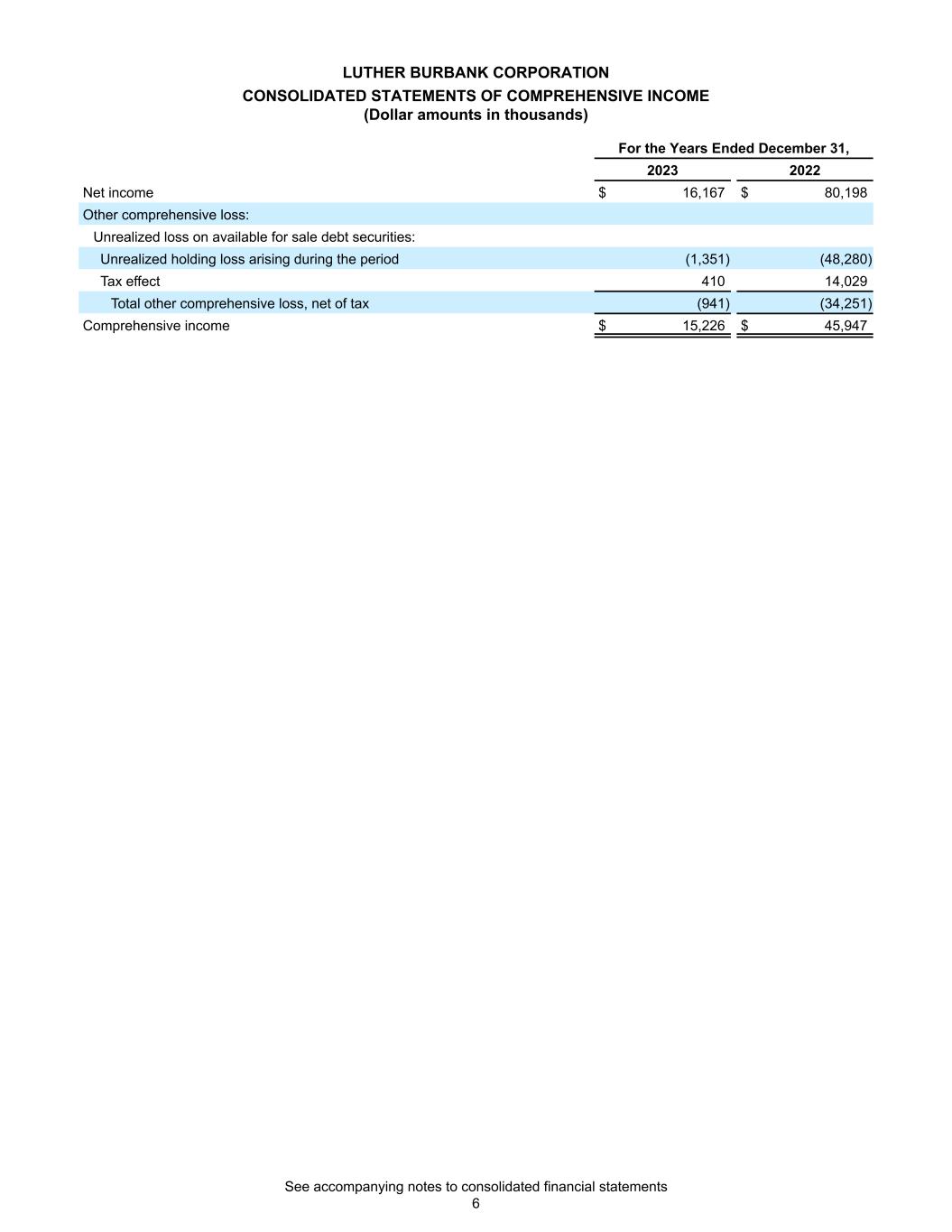
LUTHER BURBANK CORPORATION CONSOLIDATED STATEMENTS OF COMPREHENSIVE INCOME (Dollar amounts in thousands) For the Years Ended December 31, 2023 2022 Net income $ 16,167 $ 80,198 Other comprehensive loss: Unrealized loss on available for sale debt securities: Unrealized holding loss arising during the period (1,351) (48,280) Tax effect 410 14,029 Total other comprehensive loss, net of tax (941) (34,251) Comprehensive income $ 15,226 $ 45,947 See accompanying notes to consolidated financial statements 6
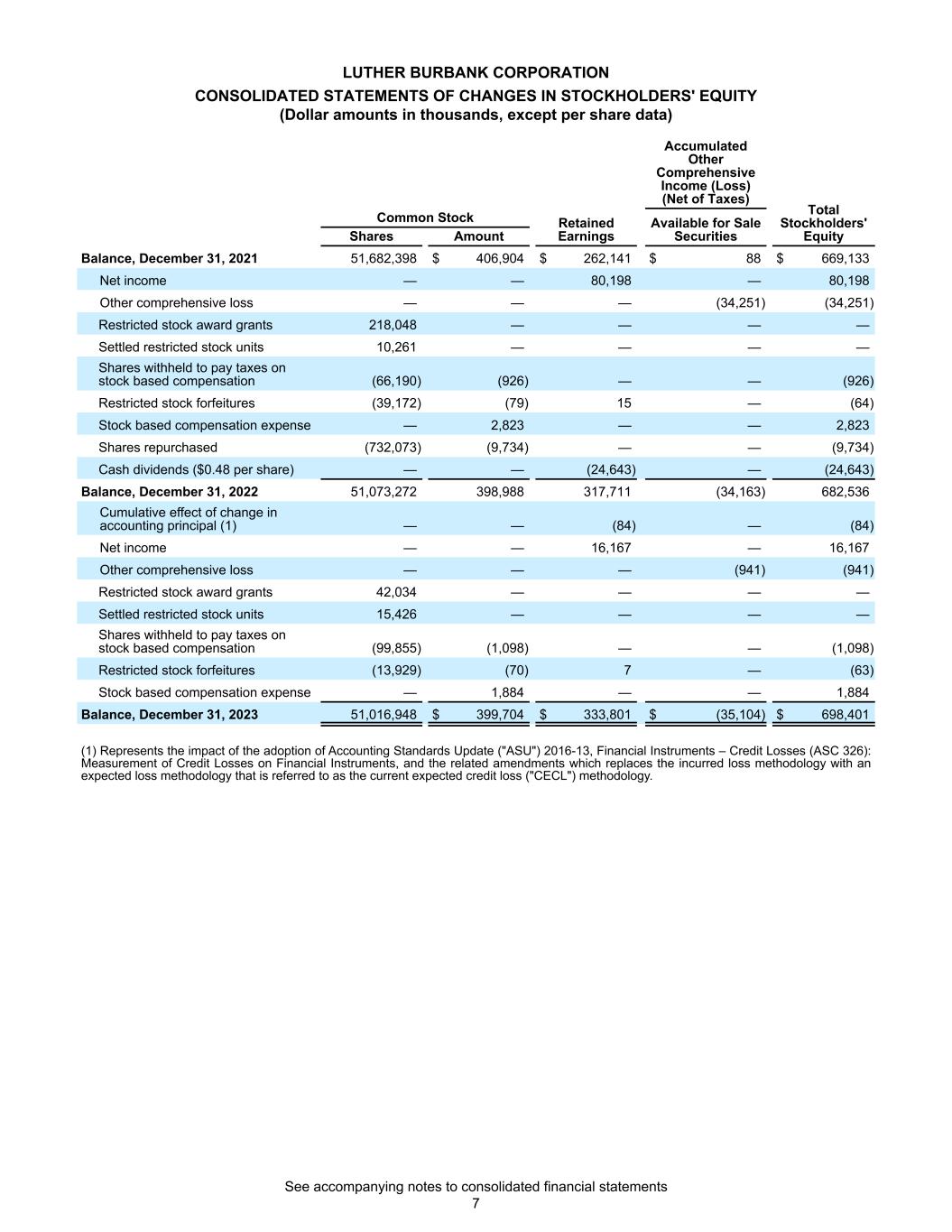
LUTHER BURBANK CORPORATION CONSOLIDATED STATEMENTS OF CHANGES IN STOCKHOLDERS' EQUITY (Dollar amounts in thousands, except per share data) Accumulated Other Comprehensive Income (Loss) (Net of Taxes) Total Stockholders' Equity Common Stock Retained Earnings Available for Sale SecuritiesShares Amount Balance, December 31, 2021 51,682,398 $ 406,904 $ 262,141 $ 88 $ 669,133 Net income — — 80,198 — 80,198 Other comprehensive loss — — — (34,251) (34,251) Restricted stock award grants 218,048 — — — — Settled restricted stock units 10,261 — — — — Shares withheld to pay taxes on stock based compensation (66,190) (926) — — (926) Restricted stock forfeitures (39,172) (79) 15 — (64) Stock based compensation expense — 2,823 — — 2,823 Shares repurchased (732,073) (9,734) — — (9,734) Cash dividends ($0.48 per share) — — (24,643) — (24,643) Balance, December 31, 2022 51,073,272 398,988 317,711 (34,163) 682,536 Cumulative effect of change in accounting principal (1) — — (84) — (84) Net income — — 16,167 — 16,167 Other comprehensive loss — — — (941) (941) Restricted stock award grants 42,034 — — — — Settled restricted stock units 15,426 — — — — Shares withheld to pay taxes on stock based compensation (99,855) (1,098) — — (1,098) Restricted stock forfeitures (13,929) (70) 7 — (63) Stock based compensation expense — 1,884 — — 1,884 Balance, December 31, 2023 51,016,948 $ 399,704 $ 333,801 $ (35,104) $ 698,401 (1) Represents the impact of the adoption of Accounting Standards Update ("ASU") 2016-13, Financial Instruments – Credit Losses (ASC 326): Measurement of Credit Losses on Financial Instruments, and the related amendments which replaces the incurred loss methodology with an expected loss methodology that is referred to as the current expected credit loss ("CECL") methodology. See accompanying notes to consolidated financial statements 7
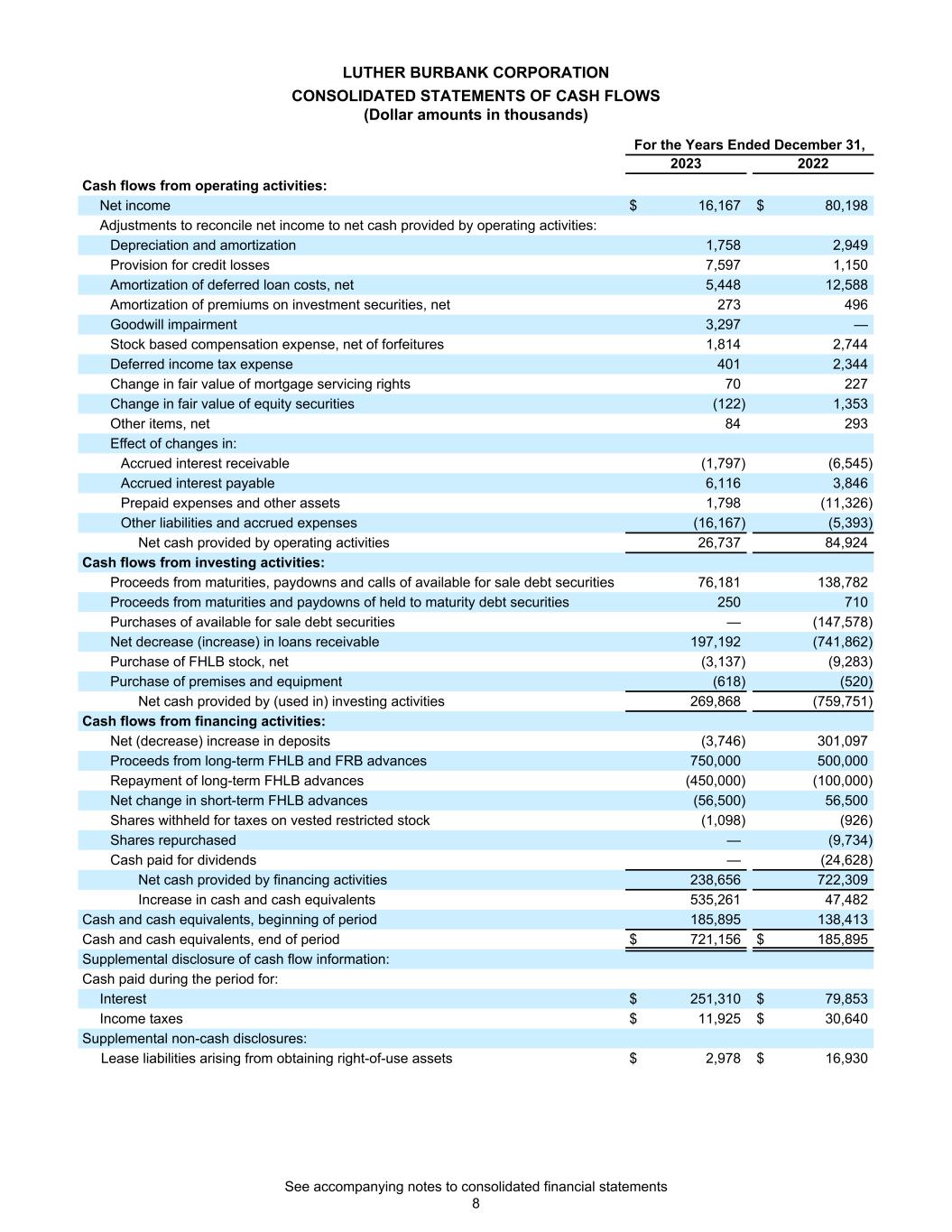
LUTHER BURBANK CORPORATION CONSOLIDATED STATEMENTS OF CASH FLOWS (Dollar amounts in thousands) For the Years Ended December 31, 2023 2022 Cash flows from operating activities: Net income $ 16,167 $ 80,198 Adjustments to reconcile net income to net cash provided by operating activities: Depreciation and amortization 1,758 2,949 Provision for credit losses 7,597 1,150 Amortization of deferred loan costs, net 5,448 12,588 Amortization of premiums on investment securities, net 273 496 Goodwill impairment 3,297 — Stock based compensation expense, net of forfeitures 1,814 2,744 Deferred income tax expense 401 2,344 Change in fair value of mortgage servicing rights 70 227 Change in fair value of equity securities (122) 1,353 Other items, net 84 293 Effect of changes in: Accrued interest receivable (1,797) (6,545) Accrued interest payable 6,116 3,846 Prepaid expenses and other assets 1,798 (11,326) Other liabilities and accrued expenses (16,167) (5,393) Net cash provided by operating activities 26,737 84,924 Cash flows from investing activities: Proceeds from maturities, paydowns and calls of available for sale debt securities 76,181 138,782 Proceeds from maturities and paydowns of held to maturity debt securities 250 710 Purchases of available for sale debt securities — (147,578) Net decrease (increase) in loans receivable 197,192 (741,862) Purchase of FHLB stock, net (3,137) (9,283) Purchase of premises and equipment (618) (520) Net cash provided by (used in) investing activities 269,868 (759,751) Cash flows from financing activities: Net (decrease) increase in deposits (3,746) 301,097 Proceeds from long-term FHLB and FRB advances 750,000 500,000 Repayment of long-term FHLB advances (450,000) (100,000) Net change in short-term FHLB advances (56,500) 56,500 Shares withheld for taxes on vested restricted stock (1,098) (926) Shares repurchased — (9,734) Cash paid for dividends — (24,628) Net cash provided by financing activities 238,656 722,309 Increase in cash and cash equivalents 535,261 47,482 Cash and cash equivalents, beginning of period 185,895 138,413 Cash and cash equivalents, end of period $ 721,156 $ 185,895 Supplemental disclosure of cash flow information: Cash paid during the period for: Interest $ 251,310 $ 79,853 Income taxes $ 11,925 $ 30,640 Supplemental non-cash disclosures: Lease liabilities arising from obtaining right-of-use assets $ 2,978 $ 16,930 See accompanying notes to consolidated financial statements 8
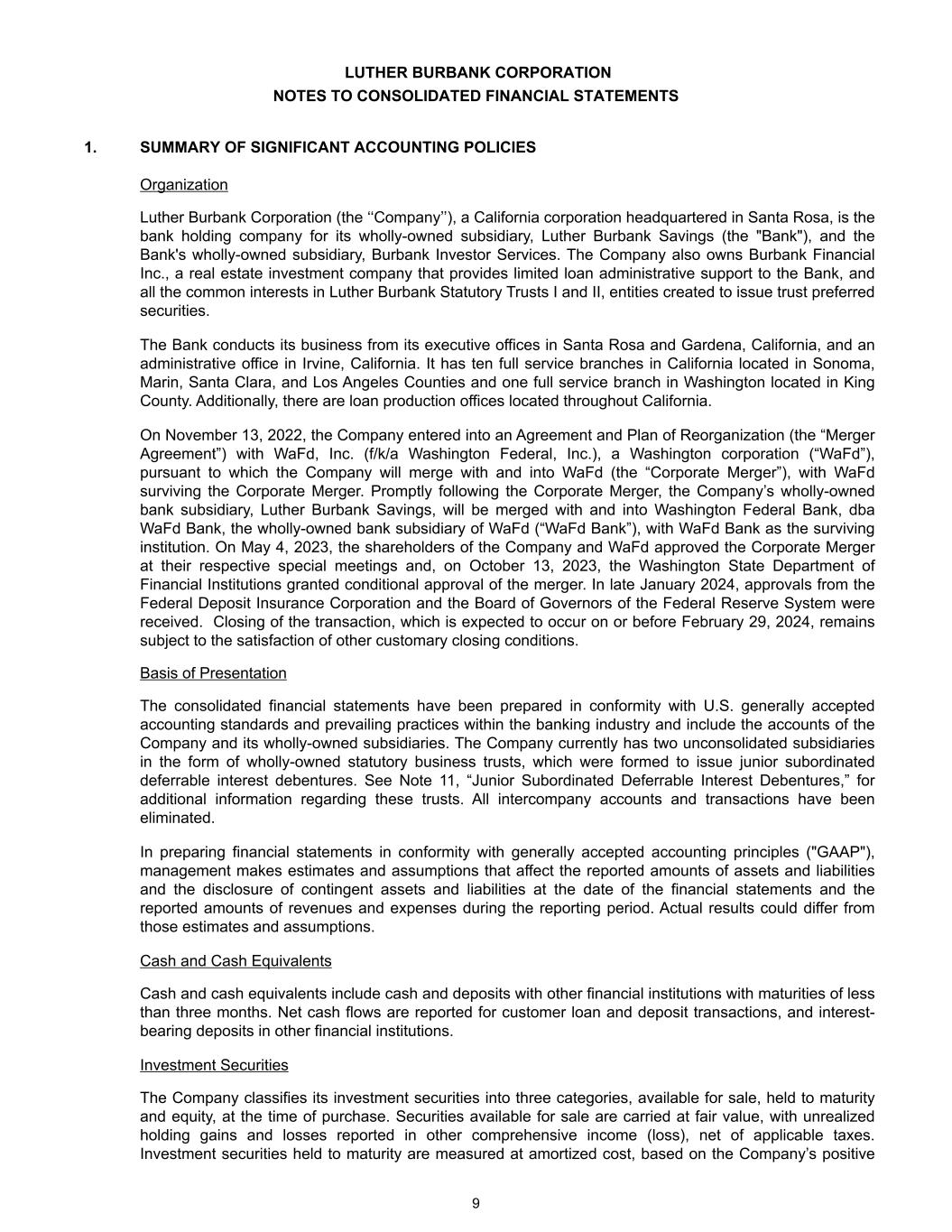
LUTHER BURBANK CORPORATION NOTES TO CONSOLIDATED FINANCIAL STATEMENTS 1. SUMMARY OF SIGNIFICANT ACCOUNTING POLICIES Organization Luther Burbank Corporation (the ‘‘Company’’), a California corporation headquartered in Santa Rosa, is the bank holding company for its wholly-owned subsidiary, Luther Burbank Savings (the "Bank"), and the Bank's wholly-owned subsidiary, Burbank Investor Services. The Company also owns Burbank Financial Inc., a real estate investment company that provides limited loan administrative support to the Bank, and all the common interests in Luther Burbank Statutory Trusts I and II, entities created to issue trust preferred securities. The Bank conducts its business from its executive offices in Santa Rosa and Gardena, California, and an administrative office in Irvine, California. It has ten full service branches in California located in Sonoma, Marin, Santa Clara, and Los Angeles Counties and one full service branch in Washington located in King County. Additionally, there are loan production offices located throughout California. On November 13, 2022, the Company entered into an Agreement and Plan of Reorganization (the “Merger Agreement”) with WaFd, Inc. (f/k/a Washington Federal, Inc.), a Washington corporation (“WaFd”), pursuant to which the Company will merge with and into WaFd (the “Corporate Merger”), with WaFd surviving the Corporate Merger. Promptly following the Corporate Merger, the Company’s wholly-owned bank subsidiary, Luther Burbank Savings, will be merged with and into Washington Federal Bank, dba WaFd Bank, the wholly-owned bank subsidiary of WaFd (“WaFd Bank”), with WaFd Bank as the surviving institution. On May 4, 2023, the shareholders of the Company and WaFd approved the Corporate Merger at their respective special meetings and, on October 13, 2023, the Washington State Department of Financial Institutions granted conditional approval of the merger. In late January 2024, approvals from the Federal Deposit Insurance Corporation and the Board of Governors of the Federal Reserve System were received. Closing of the transaction, which is expected to occur on or before February 29, 2024, remains subject to the satisfaction of other customary closing conditions. Basis of Presentation The consolidated financial statements have been prepared in conformity with U.S. generally accepted accounting standards and prevailing practices within the banking industry and include the accounts of the Company and its wholly-owned subsidiaries. The Company currently has two unconsolidated subsidiaries in the form of wholly-owned statutory business trusts, which were formed to issue junior subordinated deferrable interest debentures. See Note 11, “Junior Subordinated Deferrable Interest Debentures,” for additional information regarding these trusts. All intercompany accounts and transactions have been eliminated. In preparing financial statements in conformity with generally accepted accounting principles ("GAAP"), management makes estimates and assumptions that affect the reported amounts of assets and liabilities and the disclosure of contingent assets and liabilities at the date of the financial statements and the reported amounts of revenues and expenses during the reporting period. Actual results could differ from those estimates and assumptions. Cash and Cash Equivalents Cash and cash equivalents include cash and deposits with other financial institutions with maturities of less than three months. Net cash flows are reported for customer loan and deposit transactions, and interest- bearing deposits in other financial institutions. Investment Securities The Company classifies its investment securities into three categories, available for sale, held to maturity and equity, at the time of purchase. Securities available for sale are carried at fair value, with unrealized holding gains and losses reported in other comprehensive income (loss), net of applicable taxes. Investment securities held to maturity are measured at amortized cost, based on the Company’s positive 9
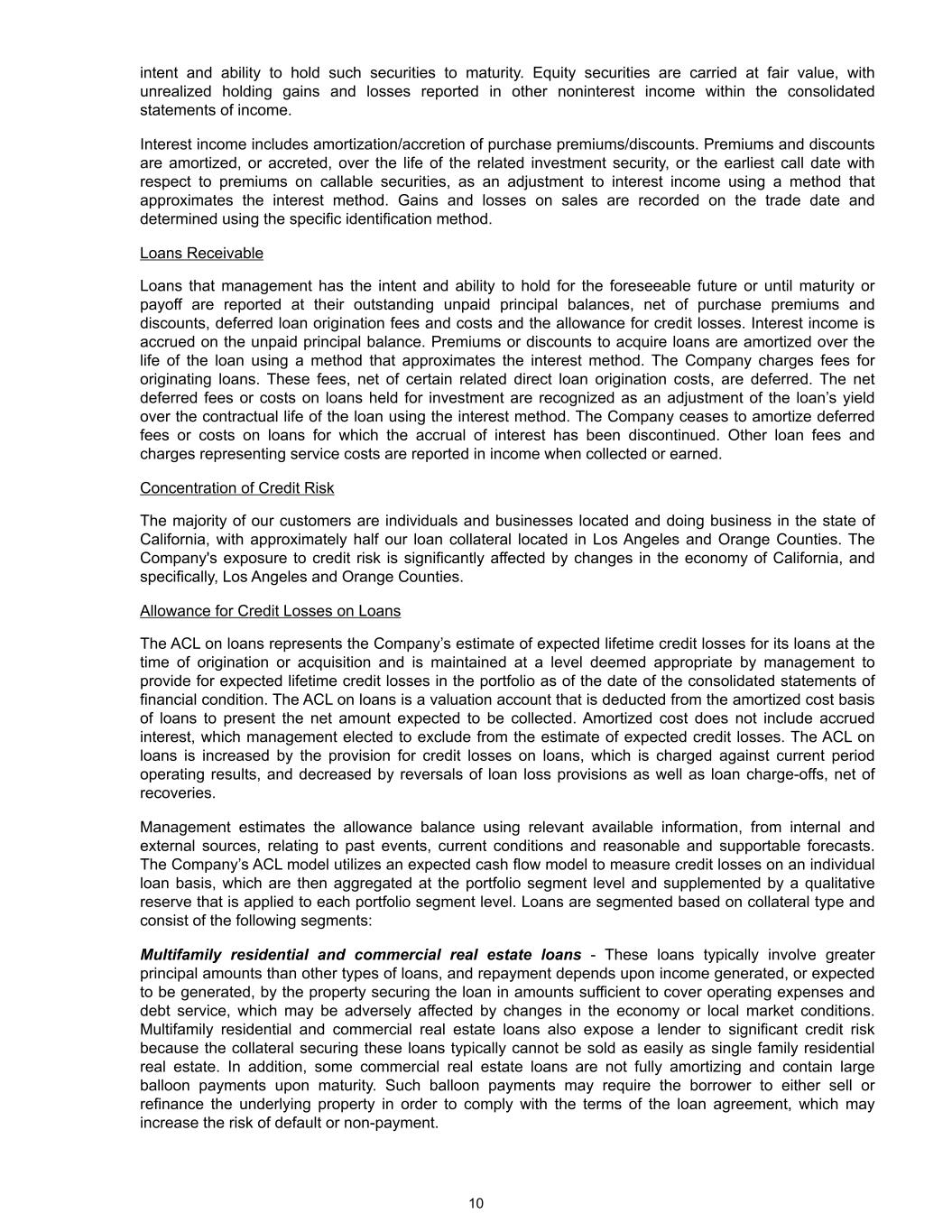
intent and ability to hold such securities to maturity. Equity securities are carried at fair value, with unrealized holding gains and losses reported in other noninterest income within the consolidated statements of income. Interest income includes amortization/accretion of purchase premiums/discounts. Premiums and discounts are amortized, or accreted, over the life of the related investment security, or the earliest call date with respect to premiums on callable securities, as an adjustment to interest income using a method that approximates the interest method. Gains and losses on sales are recorded on the trade date and determined using the specific identification method. Loans Receivable Loans that management has the intent and ability to hold for the foreseeable future or until maturity or payoff are reported at their outstanding unpaid principal balances, net of purchase premiums and discounts, deferred loan origination fees and costs and the allowance for credit losses. Interest income is accrued on the unpaid principal balance. Premiums or discounts to acquire loans are amortized over the life of the loan using a method that approximates the interest method. The Company charges fees for originating loans. These fees, net of certain related direct loan origination costs, are deferred. The net deferred fees or costs on loans held for investment are recognized as an adjustment of the loan’s yield over the contractual life of the loan using the interest method. The Company ceases to amortize deferred fees or costs on loans for which the accrual of interest has been discontinued. Other loan fees and charges representing service costs are reported in income when collected or earned. Concentration of Credit Risk The majority of our customers are individuals and businesses located and doing business in the state of California, with approximately half our loan collateral located in Los Angeles and Orange Counties. The Company's exposure to credit risk is significantly affected by changes in the economy of California, and specifically, Los Angeles and Orange Counties. Allowance for Credit Losses on Loans The ACL on loans represents the Company’s estimate of expected lifetime credit losses for its loans at the time of origination or acquisition and is maintained at a level deemed appropriate by management to provide for expected lifetime credit losses in the portfolio as of the date of the consolidated statements of financial condition. The ACL on loans is a valuation account that is deducted from the amortized cost basis of loans to present the net amount expected to be collected. Amortized cost does not include accrued interest, which management elected to exclude from the estimate of expected credit losses. The ACL on loans is increased by the provision for credit losses on loans, which is charged against current period operating results, and decreased by reversals of loan loss provisions as well as loan charge-offs, net of recoveries. Management estimates the allowance balance using relevant available information, from internal and external sources, relating to past events, current conditions and reasonable and supportable forecasts. The Company’s ACL model utilizes an expected cash flow model to measure credit losses on an individual loan basis, which are then aggregated at the portfolio segment level and supplemented by a qualitative reserve that is applied to each portfolio segment level. Loans are segmented based on collateral type and consist of the following segments: Multifamily residential and commercial real estate loans - These loans typically involve greater principal amounts than other types of loans, and repayment depends upon income generated, or expected to be generated, by the property securing the loan in amounts sufficient to cover operating expenses and debt service, which may be adversely affected by changes in the economy or local market conditions. Multifamily residential and commercial real estate loans also expose a lender to significant credit risk because the collateral securing these loans typically cannot be sold as easily as single family residential real estate. In addition, some commercial real estate loans are not fully amortizing and contain large balloon payments upon maturity. Such balloon payments may require the borrower to either sell or refinance the underlying property in order to comply with the terms of the loan agreement, which may increase the risk of default or non-payment. 10
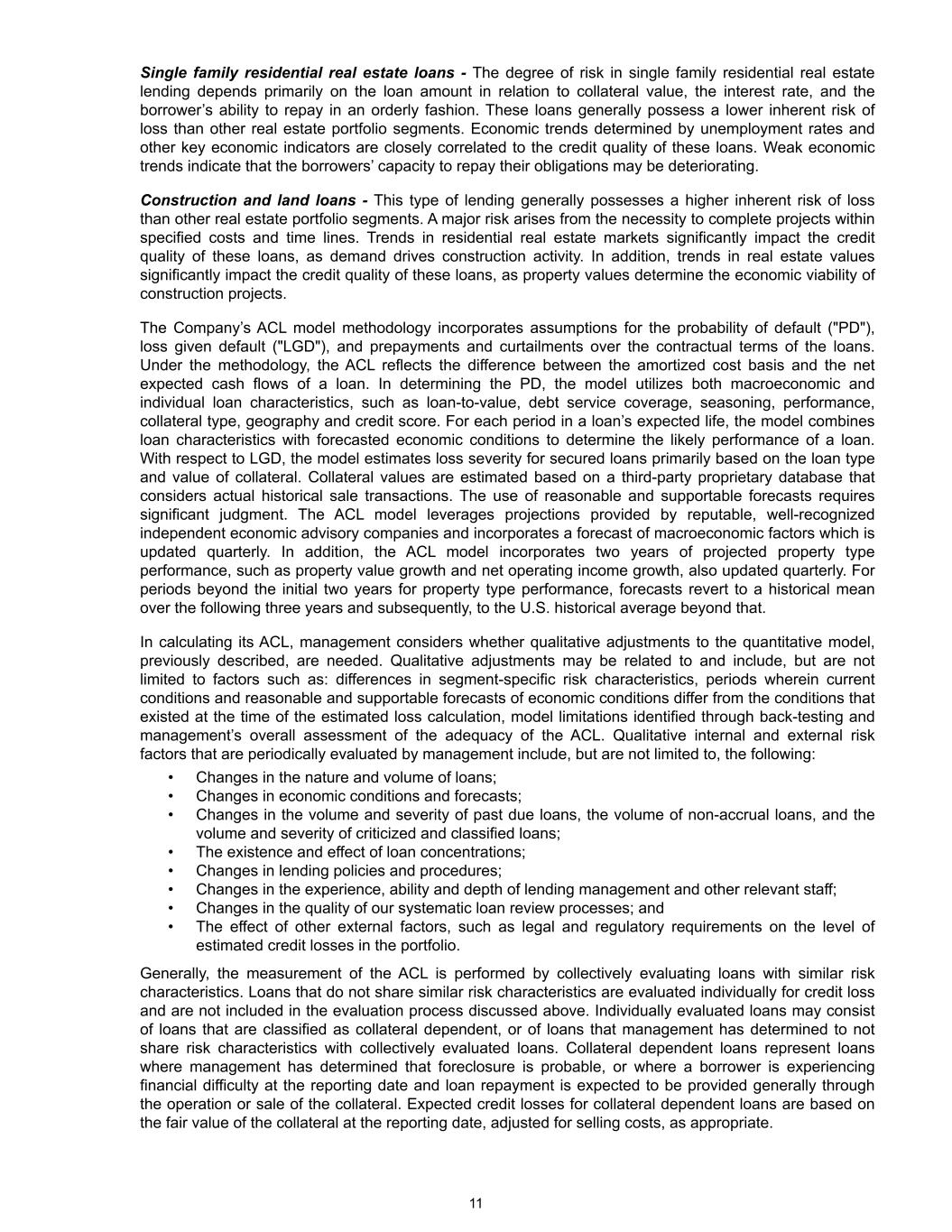
Single family residential real estate loans - The degree of risk in single family residential real estate lending depends primarily on the loan amount in relation to collateral value, the interest rate, and the borrower’s ability to repay in an orderly fashion. These loans generally possess a lower inherent risk of loss than other real estate portfolio segments. Economic trends determined by unemployment rates and other key economic indicators are closely correlated to the credit quality of these loans. Weak economic trends indicate that the borrowers’ capacity to repay their obligations may be deteriorating. Construction and land loans - This type of lending generally possesses a higher inherent risk of loss than other real estate portfolio segments. A major risk arises from the necessity to complete projects within specified costs and time lines. Trends in residential real estate markets significantly impact the credit quality of these loans, as demand drives construction activity. In addition, trends in real estate values significantly impact the credit quality of these loans, as property values determine the economic viability of construction projects. The Company’s ACL model methodology incorporates assumptions for the probability of default ("PD"), loss given default ("LGD"), and prepayments and curtailments over the contractual terms of the loans. Under the methodology, the ACL reflects the difference between the amortized cost basis and the net expected cash flows of a loan. In determining the PD, the model utilizes both macroeconomic and individual loan characteristics, such as loan-to-value, debt service coverage, seasoning, performance, collateral type, geography and credit score. For each period in a loan’s expected life, the model combines loan characteristics with forecasted economic conditions to determine the likely performance of a loan. With respect to LGD, the model estimates loss severity for secured loans primarily based on the loan type and value of collateral. Collateral values are estimated based on a third-party proprietary database that considers actual historical sale transactions. The use of reasonable and supportable forecasts requires significant judgment. The ACL model leverages projections provided by reputable, well-recognized independent economic advisory companies and incorporates a forecast of macroeconomic factors which is updated quarterly. In addition, the ACL model incorporates two years of projected property type performance, such as property value growth and net operating income growth, also updated quarterly. For periods beyond the initial two years for property type performance, forecasts revert to a historical mean over the following three years and subsequently, to the U.S. historical average beyond that. In calculating its ACL, management considers whether qualitative adjustments to the quantitative model, previously described, are needed. Qualitative adjustments may be related to and include, but are not limited to factors such as: differences in segment-specific risk characteristics, periods wherein current conditions and reasonable and supportable forecasts of economic conditions differ from the conditions that existed at the time of the estimated loss calculation, model limitations identified through back-testing and management’s overall assessment of the adequacy of the ACL. Qualitative internal and external risk factors that are periodically evaluated by management include, but are not limited to, the following: • Changes in the nature and volume of loans; • Changes in economic conditions and forecasts; • Changes in the volume and severity of past due loans, the volume of non-accrual loans, and the volume and severity of criticized and classified loans; • The existence and effect of loan concentrations; • Changes in lending policies and procedures; • Changes in the experience, ability and depth of lending management and other relevant staff; • Changes in the quality of our systematic loan review processes; and • The effect of other external factors, such as legal and regulatory requirements on the level of estimated credit losses in the portfolio. Generally, the measurement of the ACL is performed by collectively evaluating loans with similar risk characteristics. Loans that do not share similar risk characteristics are evaluated individually for credit loss and are not included in the evaluation process discussed above. Individually evaluated loans may consist of loans that are classified as collateral dependent, or of loans that management has determined to not share risk characteristics with collectively evaluated loans. Collateral dependent loans represent loans where management has determined that foreclosure is probable, or where a borrower is experiencing financial difficulty at the reporting date and loan repayment is expected to be provided generally through the operation or sale of the collateral. Expected credit losses for collateral dependent loans are based on the fair value of the collateral at the reporting date, adjusted for selling costs, as appropriate. 11
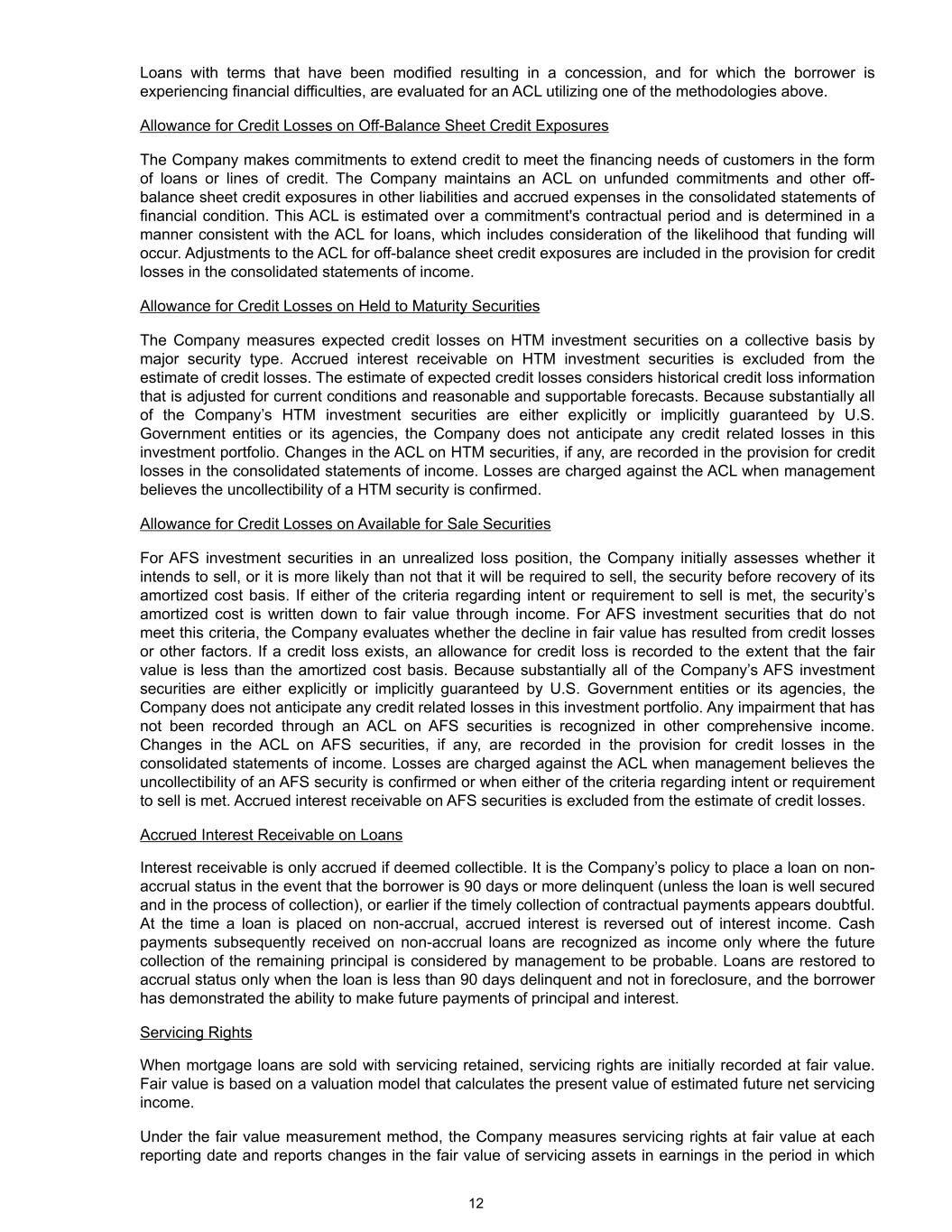
Loans with terms that have been modified resulting in a concession, and for which the borrower is experiencing financial difficulties, are evaluated for an ACL utilizing one of the methodologies above. Allowance for Credit Losses on Off-Balance Sheet Credit Exposures The Company makes commitments to extend credit to meet the financing needs of customers in the form of loans or lines of credit. The Company maintains an ACL on unfunded commitments and other off- balance sheet credit exposures in other liabilities and accrued expenses in the consolidated statements of financial condition. This ACL is estimated over a commitment's contractual period and is determined in a manner consistent with the ACL for loans, which includes consideration of the likelihood that funding will occur. Adjustments to the ACL for off-balance sheet credit exposures are included in the provision for credit losses in the consolidated statements of income. Allowance for Credit Losses on Held to Maturity Securities The Company measures expected credit losses on HTM investment securities on a collective basis by major security type. Accrued interest receivable on HTM investment securities is excluded from the estimate of credit losses. The estimate of expected credit losses considers historical credit loss information that is adjusted for current conditions and reasonable and supportable forecasts. Because substantially all of the Company’s HTM investment securities are either explicitly or implicitly guaranteed by U.S. Government entities or its agencies, the Company does not anticipate any credit related losses in this investment portfolio. Changes in the ACL on HTM securities, if any, are recorded in the provision for credit losses in the consolidated statements of income. Losses are charged against the ACL when management believes the uncollectibility of a HTM security is confirmed. Allowance for Credit Losses on Available for Sale Securities For AFS investment securities in an unrealized loss position, the Company initially assesses whether it intends to sell, or it is more likely than not that it will be required to sell, the security before recovery of its amortized cost basis. If either of the criteria regarding intent or requirement to sell is met, the security’s amortized cost is written down to fair value through income. For AFS investment securities that do not meet this criteria, the Company evaluates whether the decline in fair value has resulted from credit losses or other factors. If a credit loss exists, an allowance for credit loss is recorded to the extent that the fair value is less than the amortized cost basis. Because substantially all of the Company’s AFS investment securities are either explicitly or implicitly guaranteed by U.S. Government entities or its agencies, the Company does not anticipate any credit related losses in this investment portfolio. Any impairment that has not been recorded through an ACL on AFS securities is recognized in other comprehensive income. Changes in the ACL on AFS securities, if any, are recorded in the provision for credit losses in the consolidated statements of income. Losses are charged against the ACL when management believes the uncollectibility of an AFS security is confirmed or when either of the criteria regarding intent or requirement to sell is met. Accrued interest receivable on AFS securities is excluded from the estimate of credit losses. Accrued Interest Receivable on Loans Interest receivable is only accrued if deemed collectible. It is the Company’s policy to place a loan on non- accrual status in the event that the borrower is 90 days or more delinquent (unless the loan is well secured and in the process of collection), or earlier if the timely collection of contractual payments appears doubtful. At the time a loan is placed on non-accrual, accrued interest is reversed out of interest income. Cash payments subsequently received on non-accrual loans are recognized as income only where the future collection of the remaining principal is considered by management to be probable. Loans are restored to accrual status only when the loan is less than 90 days delinquent and not in foreclosure, and the borrower has demonstrated the ability to make future payments of principal and interest. Servicing Rights When mortgage loans are sold with servicing retained, servicing rights are initially recorded at fair value. Fair value is based on a valuation model that calculates the present value of estimated future net servicing income. Under the fair value measurement method, the Company measures servicing rights at fair value at each reporting date and reports changes in the fair value of servicing assets in earnings in the period in which 12
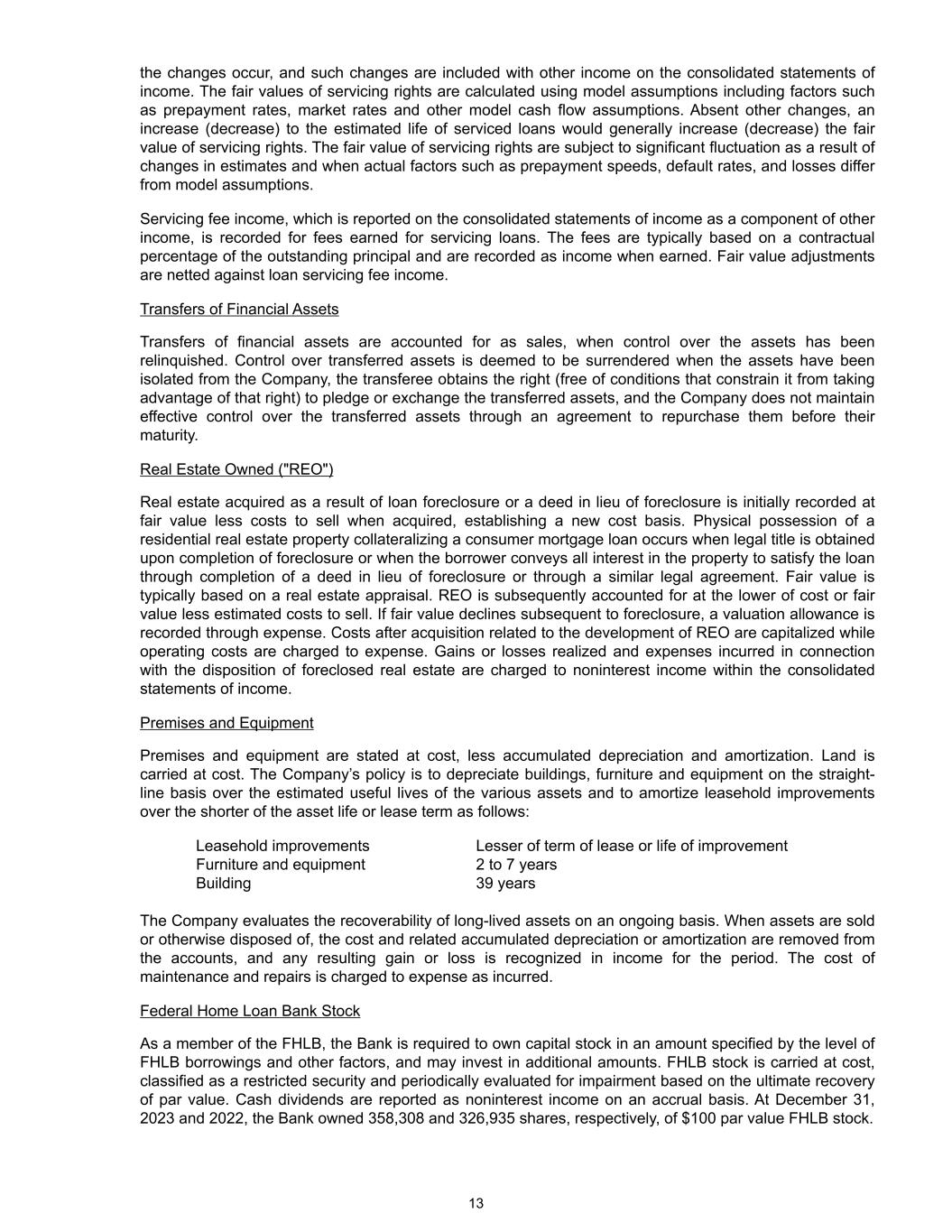
the changes occur, and such changes are included with other income on the consolidated statements of income. The fair values of servicing rights are calculated using model assumptions including factors such as prepayment rates, market rates and other model cash flow assumptions. Absent other changes, an increase (decrease) to the estimated life of serviced loans would generally increase (decrease) the fair value of servicing rights. The fair value of servicing rights are subject to significant fluctuation as a result of changes in estimates and when actual factors such as prepayment speeds, default rates, and losses differ from model assumptions. Servicing fee income, which is reported on the consolidated statements of income as a component of other income, is recorded for fees earned for servicing loans. The fees are typically based on a contractual percentage of the outstanding principal and are recorded as income when earned. Fair value adjustments are netted against loan servicing fee income. Transfers of Financial Assets Transfers of financial assets are accounted for as sales, when control over the assets has been relinquished. Control over transferred assets is deemed to be surrendered when the assets have been isolated from the Company, the transferee obtains the right (free of conditions that constrain it from taking advantage of that right) to pledge or exchange the transferred assets, and the Company does not maintain effective control over the transferred assets through an agreement to repurchase them before their maturity. Real Estate Owned ("REO") Real estate acquired as a result of loan foreclosure or a deed in lieu of foreclosure is initially recorded at fair value less costs to sell when acquired, establishing a new cost basis. Physical possession of a residential real estate property collateralizing a consumer mortgage loan occurs when legal title is obtained upon completion of foreclosure or when the borrower conveys all interest in the property to satisfy the loan through completion of a deed in lieu of foreclosure or through a similar legal agreement. Fair value is typically based on a real estate appraisal. REO is subsequently accounted for at the lower of cost or fair value less estimated costs to sell. If fair value declines subsequent to foreclosure, a valuation allowance is recorded through expense. Costs after acquisition related to the development of REO are capitalized while operating costs are charged to expense. Gains or losses realized and expenses incurred in connection with the disposition of foreclosed real estate are charged to noninterest income within the consolidated statements of income. Premises and Equipment Premises and equipment are stated at cost, less accumulated depreciation and amortization. Land is carried at cost. The Company’s policy is to depreciate buildings, furniture and equipment on the straight- line basis over the estimated useful lives of the various assets and to amortize leasehold improvements over the shorter of the asset life or lease term as follows: Leasehold improvements Lesser of term of lease or life of improvement Furniture and equipment 2 to 7 years Building 39 years The Company evaluates the recoverability of long-lived assets on an ongoing basis. When assets are sold or otherwise disposed of, the cost and related accumulated depreciation or amortization are removed from the accounts, and any resulting gain or loss is recognized in income for the period. The cost of maintenance and repairs is charged to expense as incurred. Federal Home Loan Bank Stock As a member of the FHLB, the Bank is required to own capital stock in an amount specified by the level of FHLB borrowings and other factors, and may invest in additional amounts. FHLB stock is carried at cost, classified as a restricted security and periodically evaluated for impairment based on the ultimate recovery of par value. Cash dividends are reported as noninterest income on an accrual basis. At December 31, 2023 and 2022, the Bank owned 358,308 and 326,935 shares, respectively, of $100 par value FHLB stock. 13
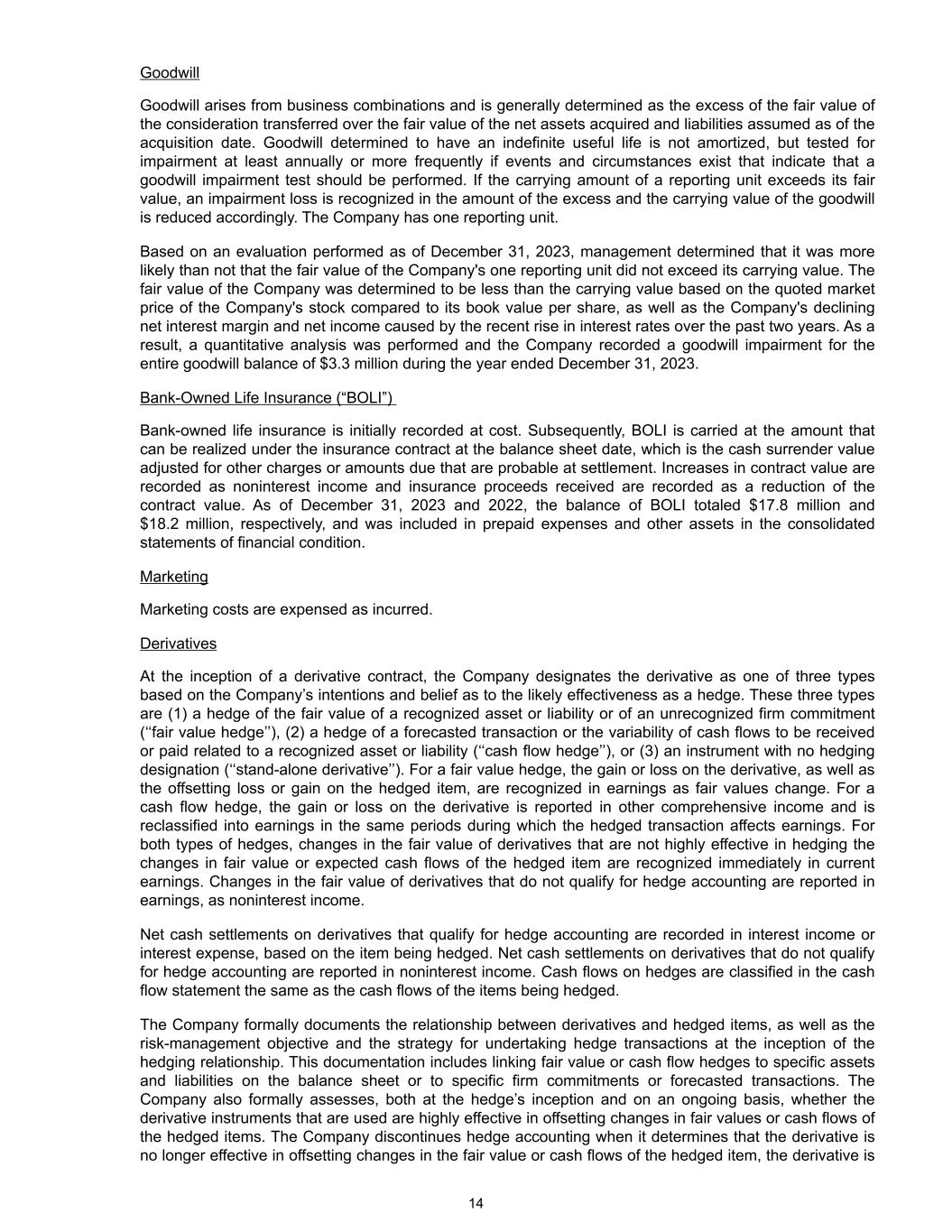
Goodwill Goodwill arises from business combinations and is generally determined as the excess of the fair value of the consideration transferred over the fair value of the net assets acquired and liabilities assumed as of the acquisition date. Goodwill determined to have an indefinite useful life is not amortized, but tested for impairment at least annually or more frequently if events and circumstances exist that indicate that a goodwill impairment test should be performed. If the carrying amount of a reporting unit exceeds its fair value, an impairment loss is recognized in the amount of the excess and the carrying value of the goodwill is reduced accordingly. The Company has one reporting unit. Based on an evaluation performed as of December 31, 2023, management determined that it was more likely than not that the fair value of the Company's one reporting unit did not exceed its carrying value. The fair value of the Company was determined to be less than the carrying value based on the quoted market price of the Company's stock compared to its book value per share, as well as the Company's declining net interest margin and net income caused by the recent rise in interest rates over the past two years. As a result, a quantitative analysis was performed and the Company recorded a goodwill impairment for the entire goodwill balance of $3.3 million during the year ended December 31, 2023. Bank-Owned Life Insurance (“BOLI”) Bank-owned life insurance is initially recorded at cost. Subsequently, BOLI is carried at the amount that can be realized under the insurance contract at the balance sheet date, which is the cash surrender value adjusted for other charges or amounts due that are probable at settlement. Increases in contract value are recorded as noninterest income and insurance proceeds received are recorded as a reduction of the contract value. As of December 31, 2023 and 2022, the balance of BOLI totaled $17.8 million and $18.2 million, respectively, and was included in prepaid expenses and other assets in the consolidated statements of financial condition. Marketing Marketing costs are expensed as incurred. Derivatives At the inception of a derivative contract, the Company designates the derivative as one of three types based on the Company’s intentions and belief as to the likely effectiveness as a hedge. These three types are (1) a hedge of the fair value of a recognized asset or liability or of an unrecognized firm commitment (‘‘fair value hedge’’), (2) a hedge of a forecasted transaction or the variability of cash flows to be received or paid related to a recognized asset or liability (‘‘cash flow hedge’’), or (3) an instrument with no hedging designation (‘‘stand-alone derivative’’). For a fair value hedge, the gain or loss on the derivative, as well as the offsetting loss or gain on the hedged item, are recognized in earnings as fair values change. For a cash flow hedge, the gain or loss on the derivative is reported in other comprehensive income and is reclassified into earnings in the same periods during which the hedged transaction affects earnings. For both types of hedges, changes in the fair value of derivatives that are not highly effective in hedging the changes in fair value or expected cash flows of the hedged item are recognized immediately in current earnings. Changes in the fair value of derivatives that do not qualify for hedge accounting are reported in earnings, as noninterest income. Net cash settlements on derivatives that qualify for hedge accounting are recorded in interest income or interest expense, based on the item being hedged. Net cash settlements on derivatives that do not qualify for hedge accounting are reported in noninterest income. Cash flows on hedges are classified in the cash flow statement the same as the cash flows of the items being hedged. The Company formally documents the relationship between derivatives and hedged items, as well as the risk-management objective and the strategy for undertaking hedge transactions at the inception of the hedging relationship. This documentation includes linking fair value or cash flow hedges to specific assets and liabilities on the balance sheet or to specific firm commitments or forecasted transactions. The Company also formally assesses, both at the hedge’s inception and on an ongoing basis, whether the derivative instruments that are used are highly effective in offsetting changes in fair values or cash flows of the hedged items. The Company discontinues hedge accounting when it determines that the derivative is no longer effective in offsetting changes in the fair value or cash flows of the hedged item, the derivative is 14
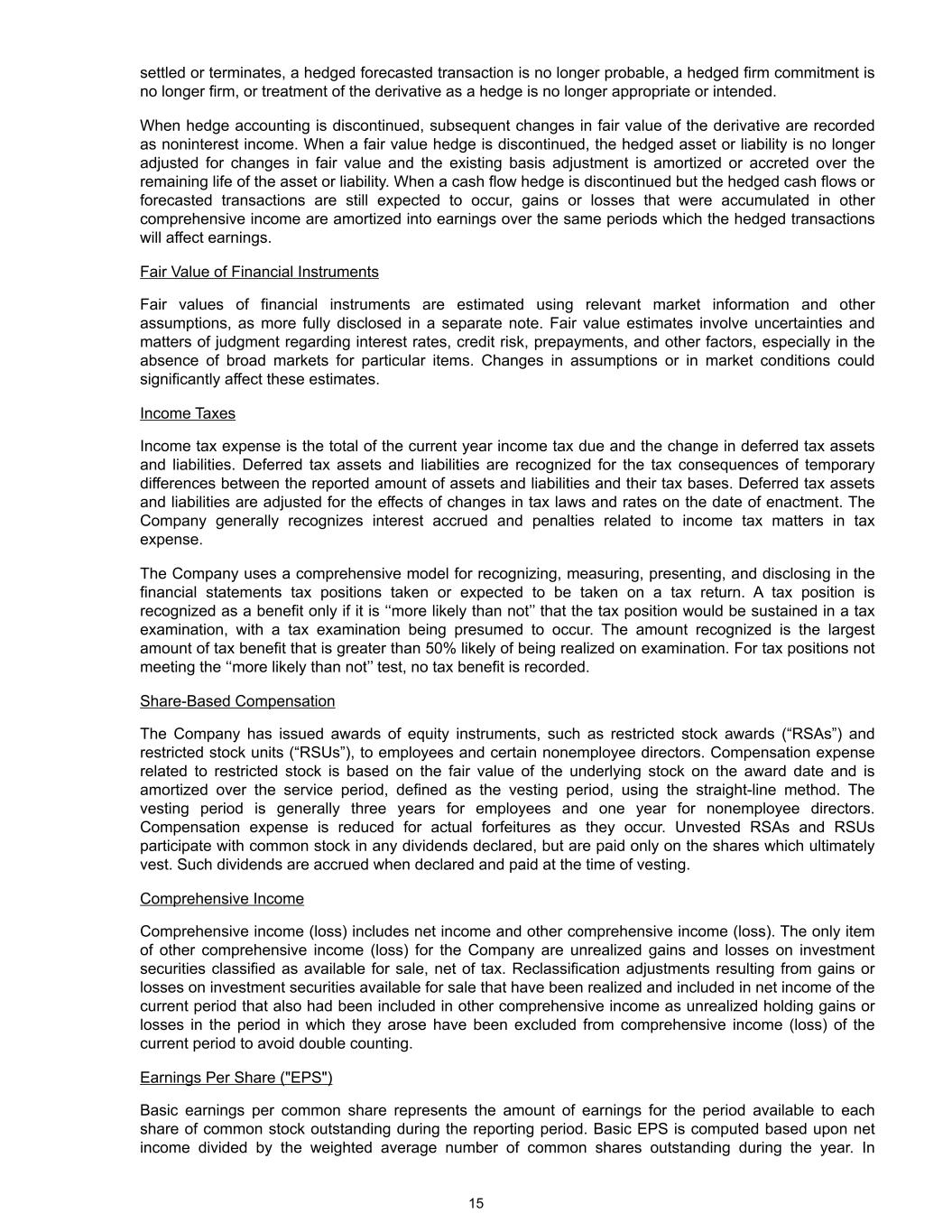
settled or terminates, a hedged forecasted transaction is no longer probable, a hedged firm commitment is no longer firm, or treatment of the derivative as a hedge is no longer appropriate or intended. When hedge accounting is discontinued, subsequent changes in fair value of the derivative are recorded as noninterest income. When a fair value hedge is discontinued, the hedged asset or liability is no longer adjusted for changes in fair value and the existing basis adjustment is amortized or accreted over the remaining life of the asset or liability. When a cash flow hedge is discontinued but the hedged cash flows or forecasted transactions are still expected to occur, gains or losses that were accumulated in other comprehensive income are amortized into earnings over the same periods which the hedged transactions will affect earnings. Fair Value of Financial Instruments Fair values of financial instruments are estimated using relevant market information and other assumptions, as more fully disclosed in a separate note. Fair value estimates involve uncertainties and matters of judgment regarding interest rates, credit risk, prepayments, and other factors, especially in the absence of broad markets for particular items. Changes in assumptions or in market conditions could significantly affect these estimates. Income Taxes Income tax expense is the total of the current year income tax due and the change in deferred tax assets and liabilities. Deferred tax assets and liabilities are recognized for the tax consequences of temporary differences between the reported amount of assets and liabilities and their tax bases. Deferred tax assets and liabilities are adjusted for the effects of changes in tax laws and rates on the date of enactment. The Company generally recognizes interest accrued and penalties related to income tax matters in tax expense. The Company uses a comprehensive model for recognizing, measuring, presenting, and disclosing in the financial statements tax positions taken or expected to be taken on a tax return. A tax position is recognized as a benefit only if it is ‘‘more likely than not’’ that the tax position would be sustained in a tax examination, with a tax examination being presumed to occur. The amount recognized is the largest amount of tax benefit that is greater than 50% likely of being realized on examination. For tax positions not meeting the ‘‘more likely than not’’ test, no tax benefit is recorded. Share-Based Compensation The Company has issued awards of equity instruments, such as restricted stock awards (“RSAs”) and restricted stock units (“RSUs”), to employees and certain nonemployee directors. Compensation expense related to restricted stock is based on the fair value of the underlying stock on the award date and is amortized over the service period, defined as the vesting period, using the straight-line method. The vesting period is generally three years for employees and one year for nonemployee directors. Compensation expense is reduced for actual forfeitures as they occur. Unvested RSAs and RSUs participate with common stock in any dividends declared, but are paid only on the shares which ultimately vest. Such dividends are accrued when declared and paid at the time of vesting. Comprehensive Income Comprehensive income (loss) includes net income and other comprehensive income (loss). The only item of other comprehensive income (loss) for the Company are unrealized gains and losses on investment securities classified as available for sale, net of tax. Reclassification adjustments resulting from gains or losses on investment securities available for sale that have been realized and included in net income of the current period that also had been included in other comprehensive income as unrealized holding gains or losses in the period in which they arose have been excluded from comprehensive income (loss) of the current period to avoid double counting. Earnings Per Share ("EPS") Basic earnings per common share represents the amount of earnings for the period available to each share of common stock outstanding during the reporting period. Basic EPS is computed based upon net income divided by the weighted average number of common shares outstanding during the year. In 15
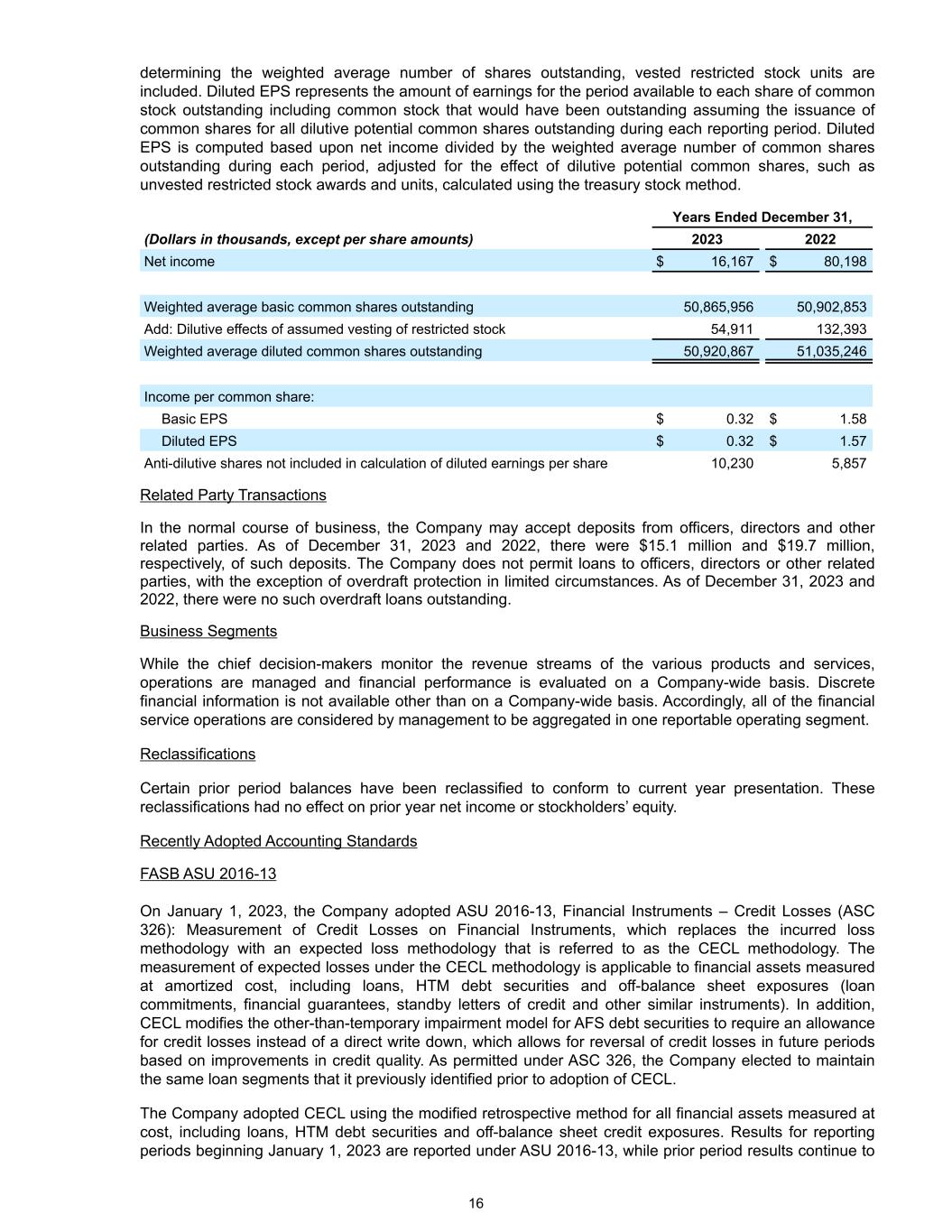
determining the weighted average number of shares outstanding, vested restricted stock units are included. Diluted EPS represents the amount of earnings for the period available to each share of common stock outstanding including common stock that would have been outstanding assuming the issuance of common shares for all dilutive potential common shares outstanding during each reporting period. Diluted EPS is computed based upon net income divided by the weighted average number of common shares outstanding during each period, adjusted for the effect of dilutive potential common shares, such as unvested restricted stock awards and units, calculated using the treasury stock method. (Dollars in thousands, except per share amounts) Years Ended December 31, 2023 2022 Net income $ 16,167 $ 80,198 Weighted average basic common shares outstanding 50,865,956 50,902,853 Add: Dilutive effects of assumed vesting of restricted stock 54,911 132,393 Weighted average diluted common shares outstanding 50,920,867 51,035,246 Income per common share: Basic EPS $ 0.32 $ 1.58 Diluted EPS $ 0.32 $ 1.57 Anti-dilutive shares not included in calculation of diluted earnings per share 10,230 5,857 Related Party Transactions In the normal course of business, the Company may accept deposits from officers, directors and other related parties. As of December 31, 2023 and 2022, there were $15.1 million and $19.7 million, respectively, of such deposits. The Company does not permit loans to officers, directors or other related parties, with the exception of overdraft protection in limited circumstances. As of December 31, 2023 and 2022, there were no such overdraft loans outstanding. Business Segments While the chief decision-makers monitor the revenue streams of the various products and services, operations are managed and financial performance is evaluated on a Company-wide basis. Discrete financial information is not available other than on a Company-wide basis. Accordingly, all of the financial service operations are considered by management to be aggregated in one reportable operating segment. Reclassifications Certain prior period balances have been reclassified to conform to current year presentation. These reclassifications had no effect on prior year net income or stockholders’ equity. Recently Adopted Accounting Standards FASB ASU 2016-13 On January 1, 2023, the Company adopted ASU 2016-13, Financial Instruments – Credit Losses (ASC 326): Measurement of Credit Losses on Financial Instruments, which replaces the incurred loss methodology with an expected loss methodology that is referred to as the CECL methodology. The measurement of expected losses under the CECL methodology is applicable to financial assets measured at amortized cost, including loans, HTM debt securities and off-balance sheet exposures (loan commitments, financial guarantees, standby letters of credit and other similar instruments). In addition, CECL modifies the other-than-temporary impairment model for AFS debt securities to require an allowance for credit losses instead of a direct write down, which allows for reversal of credit losses in future periods based on improvements in credit quality. As permitted under ASC 326, the Company elected to maintain the same loan segments that it previously identified prior to adoption of CECL. The Company adopted CECL using the modified retrospective method for all financial assets measured at cost, including loans, HTM debt securities and off-balance sheet credit exposures. Results for reporting periods beginning January 1, 2023 are reported under ASU 2016-13, while prior period results continue to 16
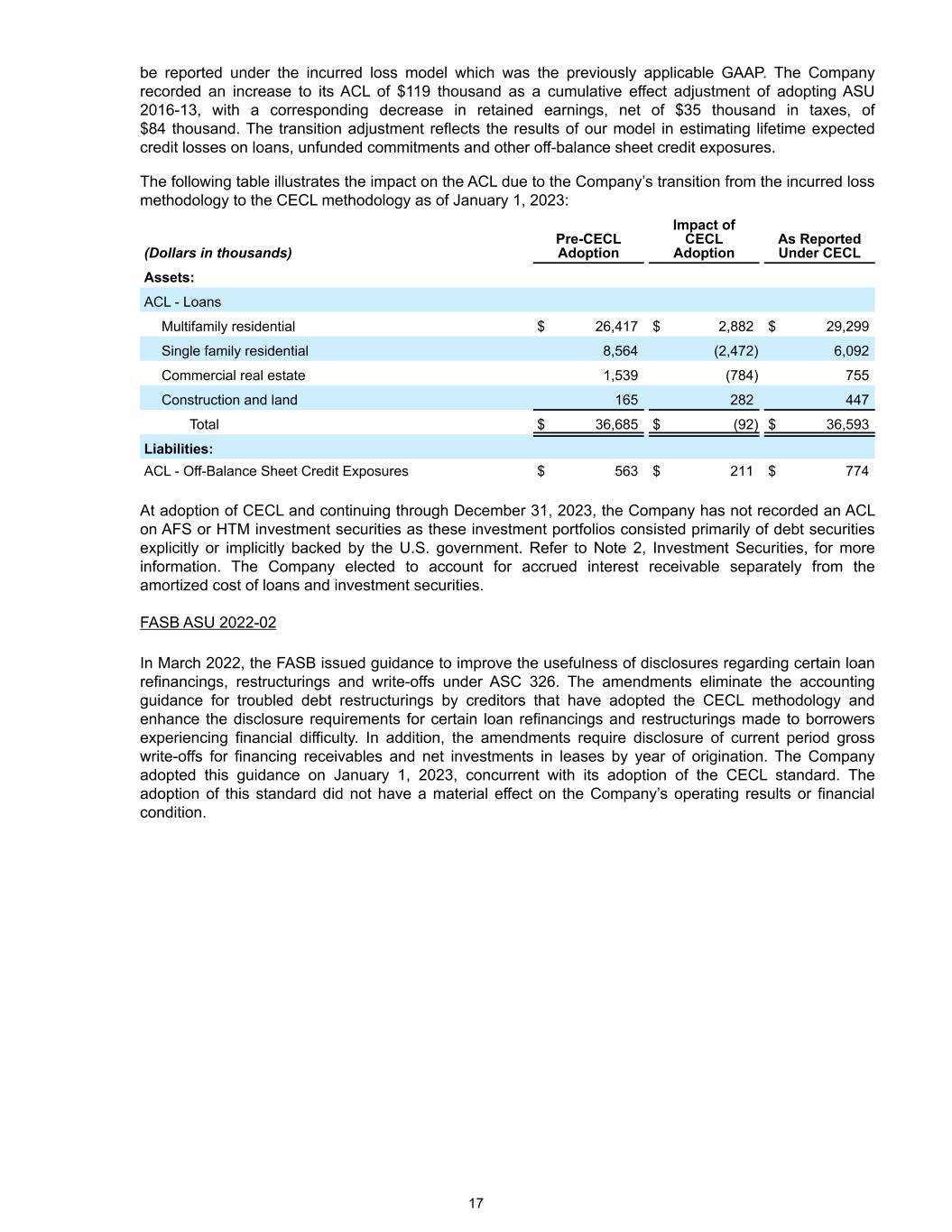
be reported under the incurred loss model which was the previously applicable GAAP. The Company recorded an increase to its ACL of $119 thousand as a cumulative effect adjustment of adopting ASU 2016-13, with a corresponding decrease in retained earnings, net of $35 thousand in taxes, of $84 thousand. The transition adjustment reflects the results of our model in estimating lifetime expected credit losses on loans, unfunded commitments and other off-balance sheet credit exposures. The following table illustrates the impact on the ACL due to the Company’s transition from the incurred loss methodology to the CECL methodology as of January 1, 2023: (Dollars in thousands) Pre-CECL Adoption Impact of CECL Adoption As Reported Under CECL Assets: ACL - Loans Multifamily residential $ 26,417 $ 2,882 $ 29,299 Single family residential 8,564 (2,472) 6,092 Commercial real estate 1,539 (784) 755 Construction and land 165 282 447 Total $ 36,685 $ (92) $ 36,593 Liabilities: ACL - Off-Balance Sheet Credit Exposures $ 563 $ 211 $ 774 At adoption of CECL and continuing through December 31, 2023, the Company has not recorded an ACL on AFS or HTM investment securities as these investment portfolios consisted primarily of debt securities explicitly or implicitly backed by the U.S. government. Refer to Note 2, Investment Securities, for more information. The Company elected to account for accrued interest receivable separately from the amortized cost of loans and investment securities. FASB ASU 2022-02 In March 2022, the FASB issued guidance to improve the usefulness of disclosures regarding certain loan refinancings, restructurings and write-offs under ASC 326. The amendments eliminate the accounting guidance for troubled debt restructurings by creditors that have adopted the CECL methodology and enhance the disclosure requirements for certain loan refinancings and restructurings made to borrowers experiencing financial difficulty. In addition, the amendments require disclosure of current period gross write-offs for financing receivables and net investments in leases by year of origination. The Company adopted this guidance on January 1, 2023, concurrent with its adoption of the CECL standard. The adoption of this standard did not have a material effect on the Company’s operating results or financial condition. 17
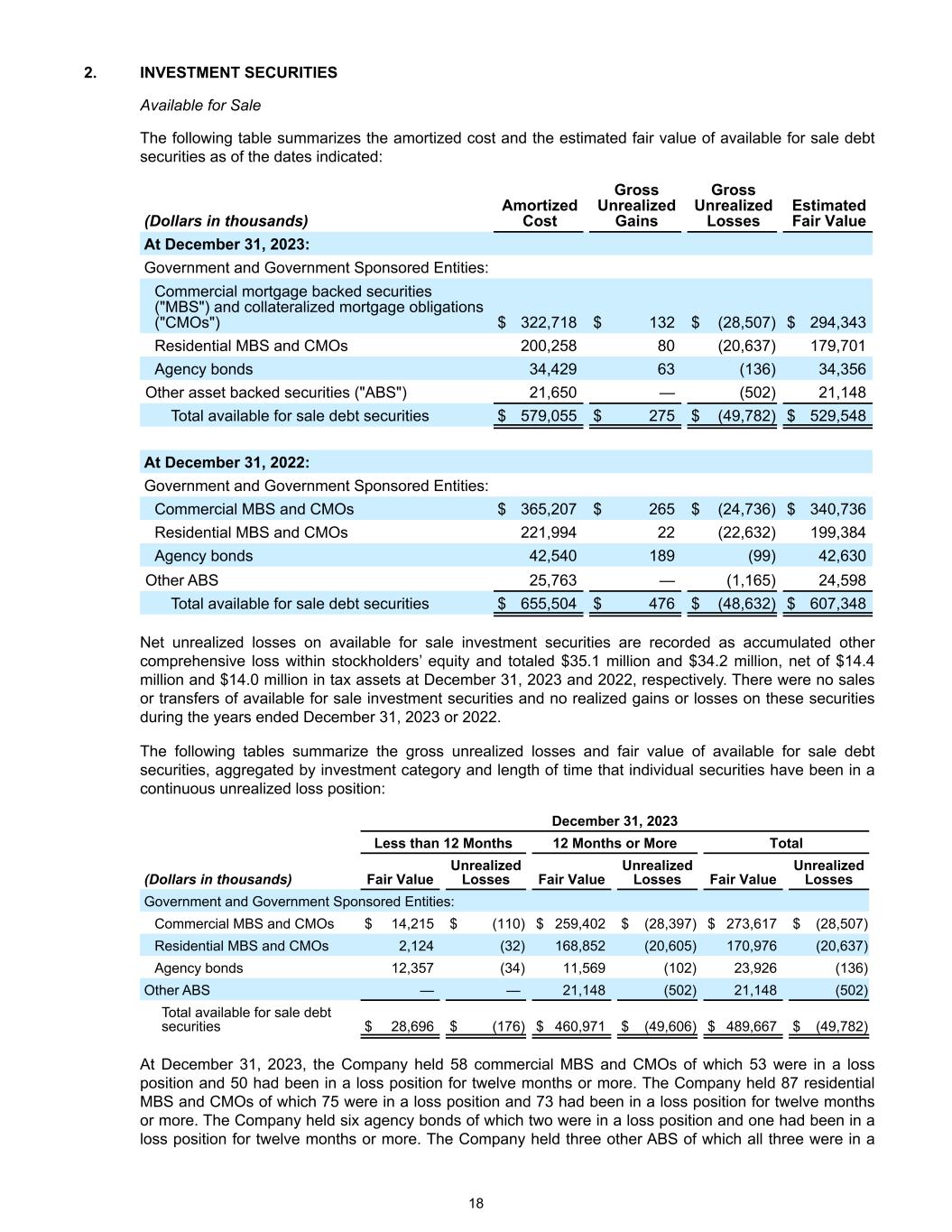
2. INVESTMENT SECURITIES Available for Sale The following table summarizes the amortized cost and the estimated fair value of available for sale debt securities as of the dates indicated: (Dollars in thousands) Amortized Cost Gross Unrealized Gains Gross Unrealized Losses Estimated Fair Value At December 31, 2023: Government and Government Sponsored Entities: Commercial mortgage backed securities ("MBS") and collateralized mortgage obligations ("CMOs") $ 322,718 $ 132 $ (28,507) $ 294,343 Residential MBS and CMOs 200,258 80 (20,637) 179,701 Agency bonds 34,429 63 (136) 34,356 Other asset backed securities ("ABS") 21,650 — (502) 21,148 Total available for sale debt securities $ 579,055 $ 275 $ (49,782) $ 529,548 At December 31, 2022: Government and Government Sponsored Entities: Commercial MBS and CMOs $ 365,207 $ 265 $ (24,736) $ 340,736 Residential MBS and CMOs 221,994 22 (22,632) 199,384 Agency bonds 42,540 189 (99) 42,630 Other ABS 25,763 — (1,165) 24,598 Total available for sale debt securities $ 655,504 $ 476 $ (48,632) $ 607,348 Net unrealized losses on available for sale investment securities are recorded as accumulated other comprehensive loss within stockholders’ equity and totaled $35.1 million and $34.2 million, net of $14.4 million and $14.0 million in tax assets at December 31, 2023 and 2022, respectively. There were no sales or transfers of available for sale investment securities and no realized gains or losses on these securities during the years ended December 31, 2023 or 2022. The following tables summarize the gross unrealized losses and fair value of available for sale debt securities, aggregated by investment category and length of time that individual securities have been in a continuous unrealized loss position: December 31, 2023 Less than 12 Months 12 Months or More Total (Dollars in thousands) Fair Value Unrealized Losses Fair Value Unrealized Losses Fair Value Unrealized Losses Government and Government Sponsored Entities: Commercial MBS and CMOs $ 14,215 $ (110) $ 259,402 $ (28,397) $ 273,617 $ (28,507) Residential MBS and CMOs 2,124 (32) 168,852 (20,605) 170,976 (20,637) Agency bonds 12,357 (34) 11,569 (102) 23,926 (136) Other ABS — — 21,148 (502) 21,148 (502) Total available for sale debt securities $ 28,696 $ (176) $ 460,971 $ (49,606) $ 489,667 $ (49,782) At December 31, 2023, the Company held 58 commercial MBS and CMOs of which 53 were in a loss position and 50 had been in a loss position for twelve months or more. The Company held 87 residential MBS and CMOs of which 75 were in a loss position and 73 had been in a loss position for twelve months or more. The Company held six agency bonds of which two were in a loss position and one had been in a loss position for twelve months or more. The Company held three other ABS of which all three were in a 18
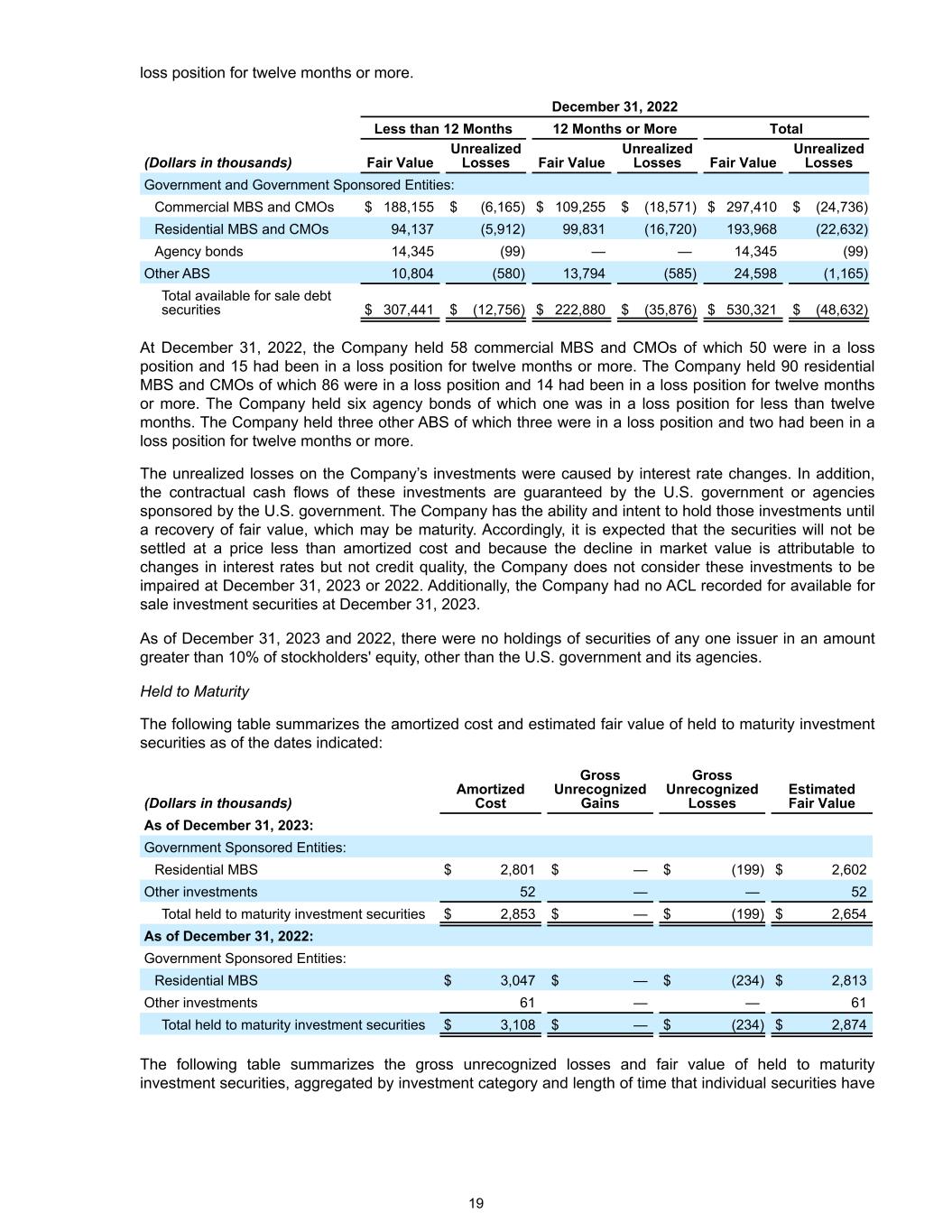
loss position for twelve months or more. December 31, 2022 Less than 12 Months 12 Months or More Total (Dollars in thousands) Fair Value Unrealized Losses Fair Value Unrealized Losses Fair Value Unrealized Losses Government and Government Sponsored Entities: Commercial MBS and CMOs $ 188,155 $ (6,165) $ 109,255 $ (18,571) $ 297,410 $ (24,736) Residential MBS and CMOs 94,137 (5,912) 99,831 (16,720) 193,968 (22,632) Agency bonds 14,345 (99) — — 14,345 (99) Other ABS 10,804 (580) 13,794 (585) 24,598 (1,165) Total available for sale debt securities $ 307,441 $ (12,756) $ 222,880 $ (35,876) $ 530,321 $ (48,632) At December 31, 2022, the Company held 58 commercial MBS and CMOs of which 50 were in a loss position and 15 had been in a loss position for twelve months or more. The Company held 90 residential MBS and CMOs of which 86 were in a loss position and 14 had been in a loss position for twelve months or more. The Company held six agency bonds of which one was in a loss position for less than twelve months. The Company held three other ABS of which three were in a loss position and two had been in a loss position for twelve months or more. The unrealized losses on the Company’s investments were caused by interest rate changes. In addition, the contractual cash flows of these investments are guaranteed by the U.S. government or agencies sponsored by the U.S. government. The Company has the ability and intent to hold those investments until a recovery of fair value, which may be maturity. Accordingly, it is expected that the securities will not be settled at a price less than amortized cost and because the decline in market value is attributable to changes in interest rates but not credit quality, the Company does not consider these investments to be impaired at December 31, 2023 or 2022. Additionally, the Company had no ACL recorded for available for sale investment securities at December 31, 2023. As of December 31, 2023 and 2022, there were no holdings of securities of any one issuer in an amount greater than 10% of stockholders' equity, other than the U.S. government and its agencies. Held to Maturity The following table summarizes the amortized cost and estimated fair value of held to maturity investment securities as of the dates indicated: (Dollars in thousands) Amortized Cost Gross Unrecognized Gains Gross Unrecognized Losses Estimated Fair Value As of December 31, 2023: Government Sponsored Entities: Residential MBS $ 2,801 $ — $ (199) $ 2,602 Other investments 52 — — 52 Total held to maturity investment securities $ 2,853 $ — $ (199) $ 2,654 As of December 31, 2022: Government Sponsored Entities: Residential MBS $ 3,047 $ — $ (234) $ 2,813 Other investments 61 — — 61 Total held to maturity investment securities $ 3,108 $ — $ (234) $ 2,874 The following table summarizes the gross unrecognized losses and fair value of held to maturity investment securities, aggregated by investment category and length of time that individual securities have 19
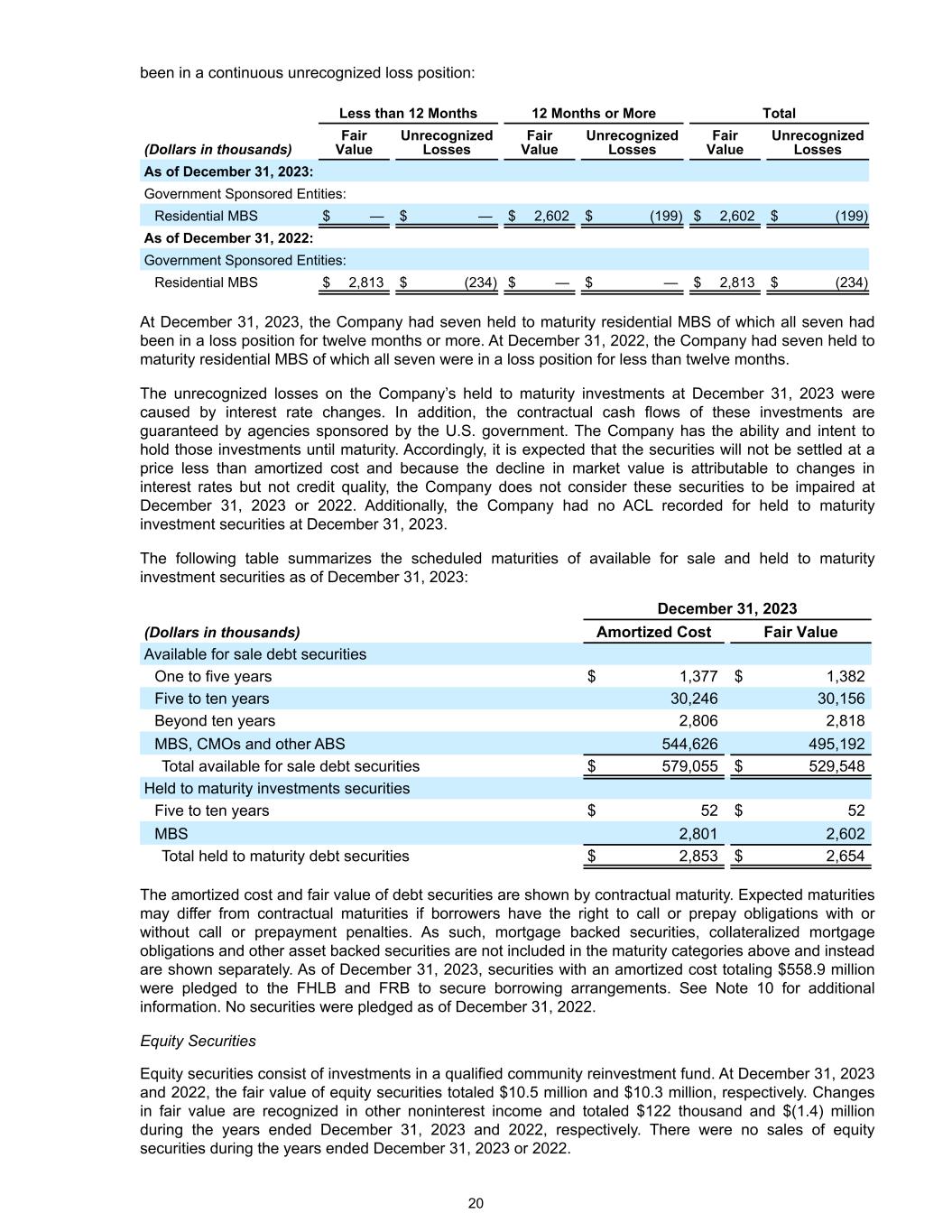
been in a continuous unrecognized loss position: Less than 12 Months 12 Months or More Total (Dollars in thousands) Fair Value Unrecognized Losses Fair Value Unrecognized Losses Fair Value Unrecognized Losses As of December 31, 2023: Government Sponsored Entities: Residential MBS $ — $ — $ 2,602 $ (199) $ 2,602 $ (199) As of December 31, 2022: Government Sponsored Entities: Residential MBS $ 2,813 $ (234) $ — $ — $ 2,813 $ (234) At December 31, 2023, the Company had seven held to maturity residential MBS of which all seven had been in a loss position for twelve months or more. At December 31, 2022, the Company had seven held to maturity residential MBS of which all seven were in a loss position for less than twelve months. The unrecognized losses on the Company’s held to maturity investments at December 31, 2023 were caused by interest rate changes. In addition, the contractual cash flows of these investments are guaranteed by agencies sponsored by the U.S. government. The Company has the ability and intent to hold those investments until maturity. Accordingly, it is expected that the securities will not be settled at a price less than amortized cost and because the decline in market value is attributable to changes in interest rates but not credit quality, the Company does not consider these securities to be impaired at December 31, 2023 or 2022. Additionally, the Company had no ACL recorded for held to maturity investment securities at December 31, 2023. The following table summarizes the scheduled maturities of available for sale and held to maturity investment securities as of December 31, 2023: December 31, 2023 (Dollars in thousands) Amortized Cost Fair Value Available for sale debt securities One to five years $ 1,377 $ 1,382 Five to ten years 30,246 30,156 Beyond ten years 2,806 2,818 MBS, CMOs and other ABS 544,626 495,192 Total available for sale debt securities $ 579,055 $ 529,548 Held to maturity investments securities Five to ten years $ 52 $ 52 MBS 2,801 2,602 Total held to maturity debt securities $ 2,853 $ 2,654 The amortized cost and fair value of debt securities are shown by contractual maturity. Expected maturities may differ from contractual maturities if borrowers have the right to call or prepay obligations with or without call or prepayment penalties. As such, mortgage backed securities, collateralized mortgage obligations and other asset backed securities are not included in the maturity categories above and instead are shown separately. As of December 31, 2023, securities with an amortized cost totaling $558.9 million were pledged to the FHLB and FRB to secure borrowing arrangements. See Note 10 for additional information. No securities were pledged as of December 31, 2022. Equity Securities Equity securities consist of investments in a qualified community reinvestment fund. At December 31, 2023 and 2022, the fair value of equity securities totaled $10.5 million and $10.3 million, respectively. Changes in fair value are recognized in other noninterest income and totaled $122 thousand and $(1.4) million during the years ended December 31, 2023 and 2022, respectively. There were no sales of equity securities during the years ended December 31, 2023 or 2022. 20
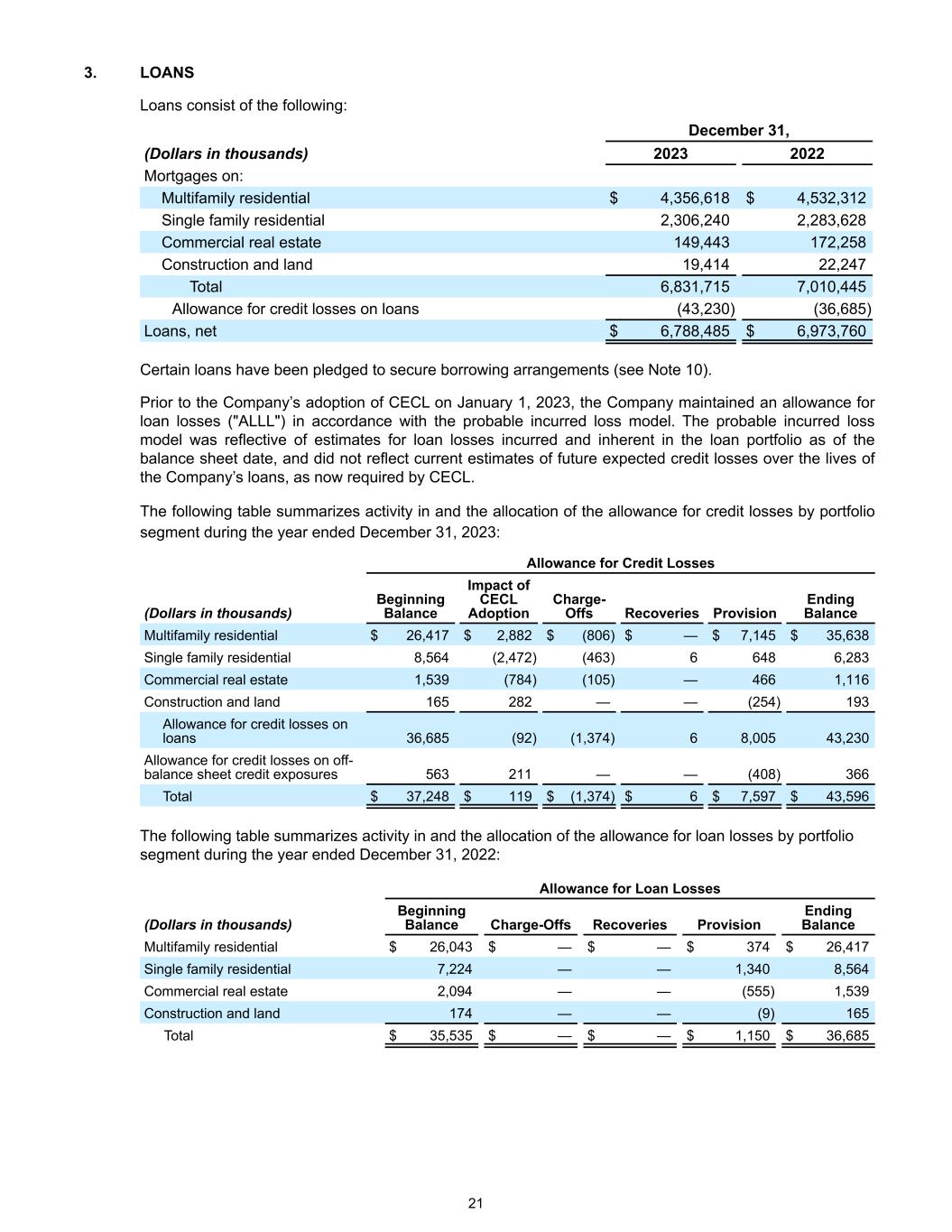
3. LOANS Loans consist of the following: December 31, (Dollars in thousands) 2023 2022 Mortgages on: Multifamily residential $ 4,356,618 $ 4,532,312 Single family residential 2,306,240 2,283,628 Commercial real estate 149,443 172,258 Construction and land 19,414 22,247 Total 6,831,715 7,010,445 Allowance for credit losses on loans (43,230) (36,685) Loans, net $ 6,788,485 $ 6,973,760 Certain loans have been pledged to secure borrowing arrangements (see Note 10). Prior to the Company’s adoption of CECL on January 1, 2023, the Company maintained an allowance for loan losses ("ALLL") in accordance with the probable incurred loss model. The probable incurred loss model was reflective of estimates for loan losses incurred and inherent in the loan portfolio as of the balance sheet date, and did not reflect current estimates of future expected credit losses over the lives of the Company’s loans, as now required by CECL. The following table summarizes activity in and the allocation of the allowance for credit losses by portfolio segment during the year ended December 31, 2023: Allowance for Credit Losses (Dollars in thousands) Beginning Balance Impact of CECL Adoption Charge- Offs Recoveries Provision Ending Balance Multifamily residential $ 26,417 $ 2,882 $ (806) $ — $ 7,145 $ 35,638 Single family residential 8,564 (2,472) (463) 6 648 6,283 Commercial real estate 1,539 (784) (105) — 466 1,116 Construction and land 165 282 — — (254) 193 Allowance for credit losses on loans 36,685 (92) (1,374) 6 8,005 43,230 Allowance for credit losses on off- balance sheet credit exposures 563 211 — — (408) 366 Total $ 37,248 $ 119 $ (1,374) $ 6 $ 7,597 $ 43,596 The following table summarizes activity in and the allocation of the allowance for loan losses by portfolio segment during the year ended December 31, 2022: Allowance for Loan Losses (Dollars in thousands) Beginning Balance Charge-Offs Recoveries Provision Ending Balance Multifamily residential $ 26,043 $ — $ — $ 374 $ 26,417 Single family residential 7,224 — — 1,340 8,564 Commercial real estate 2,094 — — (555) 1,539 Construction and land 174 — — (9) 165 Total $ 35,535 $ — $ — $ 1,150 $ 36,685 21
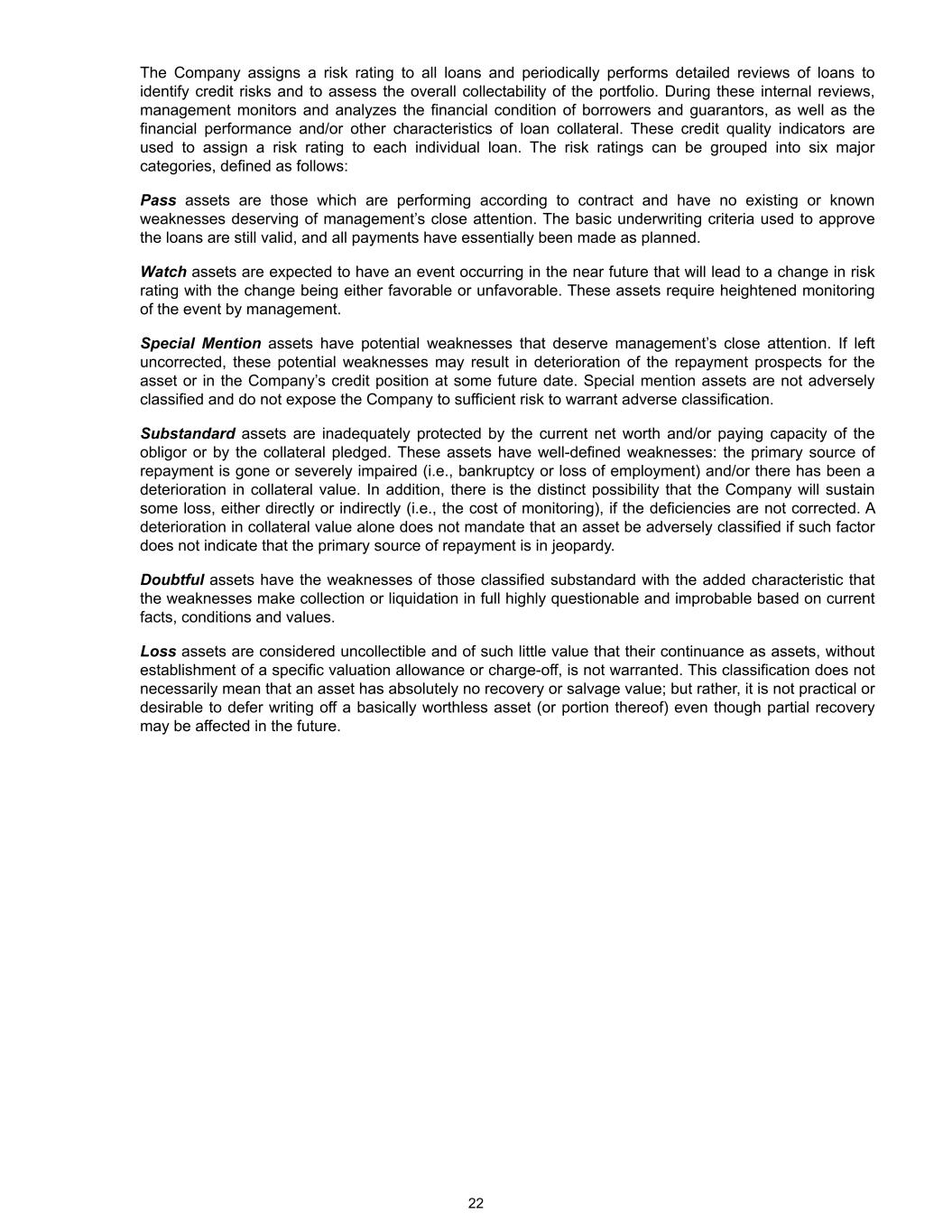
The Company assigns a risk rating to all loans and periodically performs detailed reviews of loans to identify credit risks and to assess the overall collectability of the portfolio. During these internal reviews, management monitors and analyzes the financial condition of borrowers and guarantors, as well as the financial performance and/or other characteristics of loan collateral. These credit quality indicators are used to assign a risk rating to each individual loan. The risk ratings can be grouped into six major categories, defined as follows: Pass assets are those which are performing according to contract and have no existing or known weaknesses deserving of management’s close attention. The basic underwriting criteria used to approve the loans are still valid, and all payments have essentially been made as planned. Watch assets are expected to have an event occurring in the near future that will lead to a change in risk rating with the change being either favorable or unfavorable. These assets require heightened monitoring of the event by management. Special Mention assets have potential weaknesses that deserve management’s close attention. If left uncorrected, these potential weaknesses may result in deterioration of the repayment prospects for the asset or in the Company’s credit position at some future date. Special mention assets are not adversely classified and do not expose the Company to sufficient risk to warrant adverse classification. Substandard assets are inadequately protected by the current net worth and/or paying capacity of the obligor or by the collateral pledged. These assets have well-defined weaknesses: the primary source of repayment is gone or severely impaired (i.e., bankruptcy or loss of employment) and/or there has been a deterioration in collateral value. In addition, there is the distinct possibility that the Company will sustain some loss, either directly or indirectly (i.e., the cost of monitoring), if the deficiencies are not corrected. A deterioration in collateral value alone does not mandate that an asset be adversely classified if such factor does not indicate that the primary source of repayment is in jeopardy. Doubtful assets have the weaknesses of those classified substandard with the added characteristic that the weaknesses make collection or liquidation in full highly questionable and improbable based on current facts, conditions and values. Loss assets are considered uncollectible and of such little value that their continuance as assets, without establishment of a specific valuation allowance or charge-off, is not warranted. This classification does not necessarily mean that an asset has absolutely no recovery or salvage value; but rather, it is not practical or desirable to defer writing off a basically worthless asset (or portion thereof) even though partial recovery may be affected in the future. 22
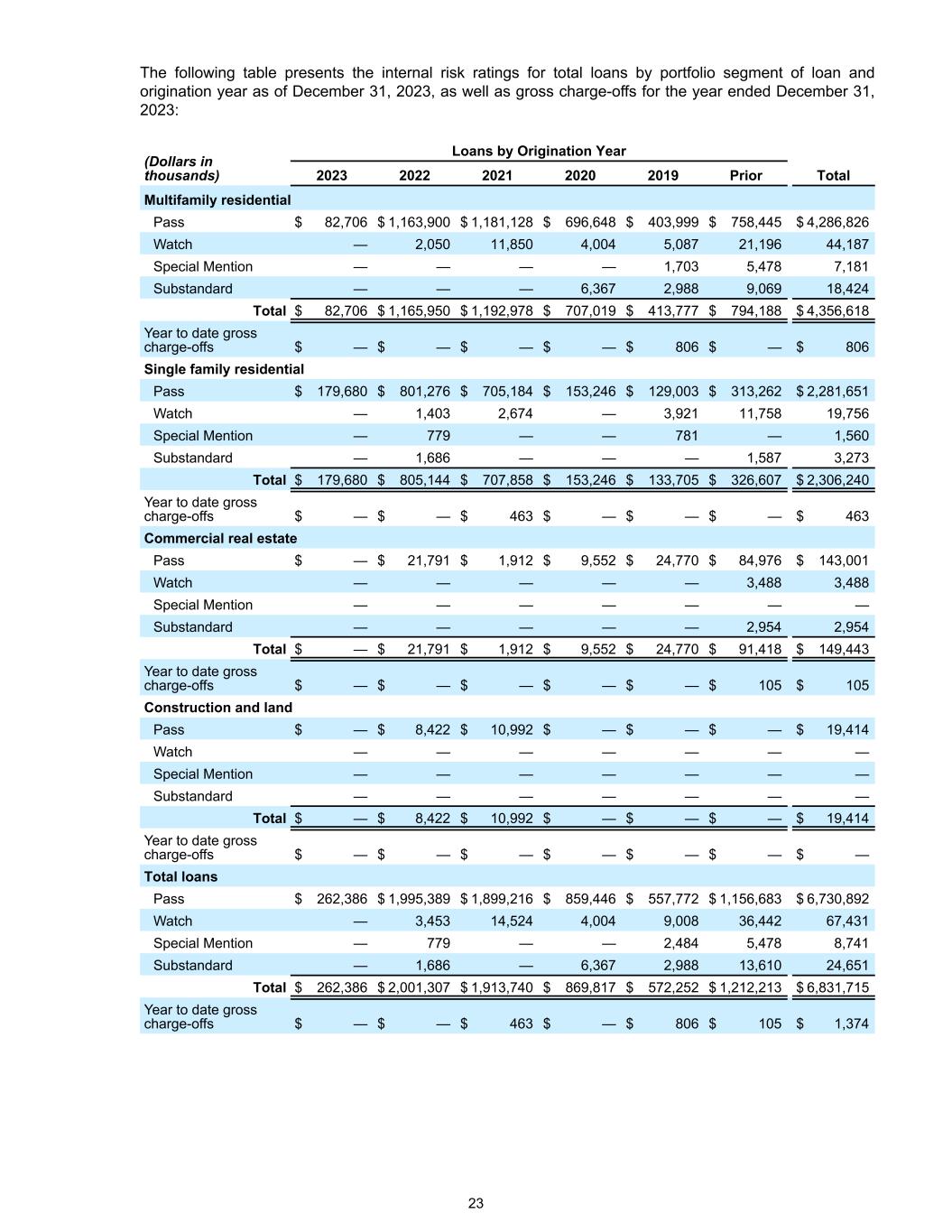
The following table presents the internal risk ratings for total loans by portfolio segment of loan and origination year as of December 31, 2023, as well as gross charge-offs for the year ended December 31, 2023: (Dollars in thousands) Loans by Origination Year 2023 2022 2021 2020 2019 Prior Total Multifamily residential Pass $ 82,706 $ 1,163,900 $ 1,181,128 $ 696,648 $ 403,999 $ 758,445 $ 4,286,826 Watch — 2,050 11,850 4,004 5,087 21,196 44,187 Special Mention — — — — 1,703 5,478 7,181 Substandard — — — 6,367 2,988 9,069 18,424 Total $ 82,706 $ 1,165,950 $ 1,192,978 $ 707,019 $ 413,777 $ 794,188 $ 4,356,618 Year to date gross charge-offs $ — $ — $ — $ — $ 806 $ — $ 806 Single family residential Pass $ 179,680 $ 801,276 $ 705,184 $ 153,246 $ 129,003 $ 313,262 $ 2,281,651 Watch — 1,403 2,674 — 3,921 11,758 19,756 Special Mention — 779 — — 781 — 1,560 Substandard — 1,686 — — — 1,587 3,273 Total $ 179,680 $ 805,144 $ 707,858 $ 153,246 $ 133,705 $ 326,607 $ 2,306,240 Year to date gross charge-offs $ — $ — $ 463 $ — $ — $ — $ 463 Commercial real estate Pass $ — $ 21,791 $ 1,912 $ 9,552 $ 24,770 $ 84,976 $ 143,001 Watch — — — — — 3,488 3,488 Special Mention — — — — — — — Substandard — — — — — 2,954 2,954 Total $ — $ 21,791 $ 1,912 $ 9,552 $ 24,770 $ 91,418 $ 149,443 Year to date gross charge-offs $ — $ — $ — $ — $ — $ 105 $ 105 Construction and land Pass $ — $ 8,422 $ 10,992 $ — $ — $ — $ 19,414 Watch — — — — — — — Special Mention — — — — — — — Substandard — — — — — — — Total $ — $ 8,422 $ 10,992 $ — $ — $ — $ 19,414 Year to date gross charge-offs $ — $ — $ — $ — $ — $ — $ — Total loans Pass $ 262,386 $ 1,995,389 $ 1,899,216 $ 859,446 $ 557,772 $ 1,156,683 $ 6,730,892 Watch — 3,453 14,524 4,004 9,008 36,442 67,431 Special Mention — 779 — — 2,484 5,478 8,741 Substandard — 1,686 — 6,367 2,988 13,610 24,651 Total $ 262,386 $ 2,001,307 $ 1,913,740 $ 869,817 $ 572,252 $ 1,212,213 $ 6,831,715 Year to date gross charge-offs $ — $ — $ 463 $ — $ 806 $ 105 $ 1,374 23

The following table summarizes the loan portfolio allocated by management’s internal risk ratings at December 31, 2022: (Dollars in thousands) Multifamily Residential Single Family Residential Commercial Real Estate Construction and Land Total Grade: Pass $ 4,469,443 $ 2,269,325 $ 169,711 $ 22,247 $ 6,930,726 Watch 44,436 11,341 1,594 — 57,371 Special mention 2,460 — 953 — 3,413 Substandard 15,973 2,962 — — 18,935 Total $ 4,532,312 $ 2,283,628 $ 172,258 $ 22,247 $ 7,010,445 The following table summarizes an aging analysis of the loan portfolio by the time past due as of the dates indicated below: (Dollars in thousands) 30 Days 60 Days 90+ Days Total Past Due Current Total As of December 31, 2023: Loans: Multifamily residential $ 10,168 $ — $ 3,023 $ 13,191 $ 4,343,427 $ 4,356,618 Single family residential 2,385 2,012 2,321 6,718 2,299,522 2,306,240 Commercial real estate 842 — — 842 148,601 149,443 Construction and land — — — — 19,414 19,414 Total $ 13,395 $ 2,012 $ 5,344 $ 20,751 $ 6,810,964 $ 6,831,715 As of December 31, 2022: Loans: Multifamily residential $ — $ — $ 3,023 $ 3,023 $ 4,529,289 $ 4,532,312 Single family residential — — 104 104 2,283,524 2,283,628 Commercial real estate — — — — 172,258 172,258 Construction and land — — — — 22,247 22,247 Total $ — $ — $ 3,127 $ 3,127 $ 7,007,318 $ 7,010,445 As of both December 31, 2023 and 2022, there were no loans that were past due over 89 days and still accruing interest. Loans that have been classified as collateral dependent are loans where substantially all repayment of the loan is expected to come from the operation of or eventual liquidation of the collateral. Collateral dependent loans are evaluated individually for purposes of measuring the ACL, which is determined based on the estimated fair value of the collateral. Estimates for costs to sell are included in the determination of the ACL when liquidation of the collateral is anticipated. In cases where the loan is well secured and the estimated value of the collateral exceeds the amortized cost of the loan, no ACL is recorded. The following table presents the amortized cost basis of collateral dependent loans by loan type at December 31, 2023. Amortized Cost by Collateral Type Allowance for Credit Losses(Dollars in thousands) Residential Office Industrial Total Multifamily residential $ 9,987 $ — $ — $ 9,987 $ — Single family residential 3,273 — — 3,273 — Commercial real estate — — 2,745 2,745 — Total $ 13,260 $ — $ 2,745 $ 16,005 $ — 24
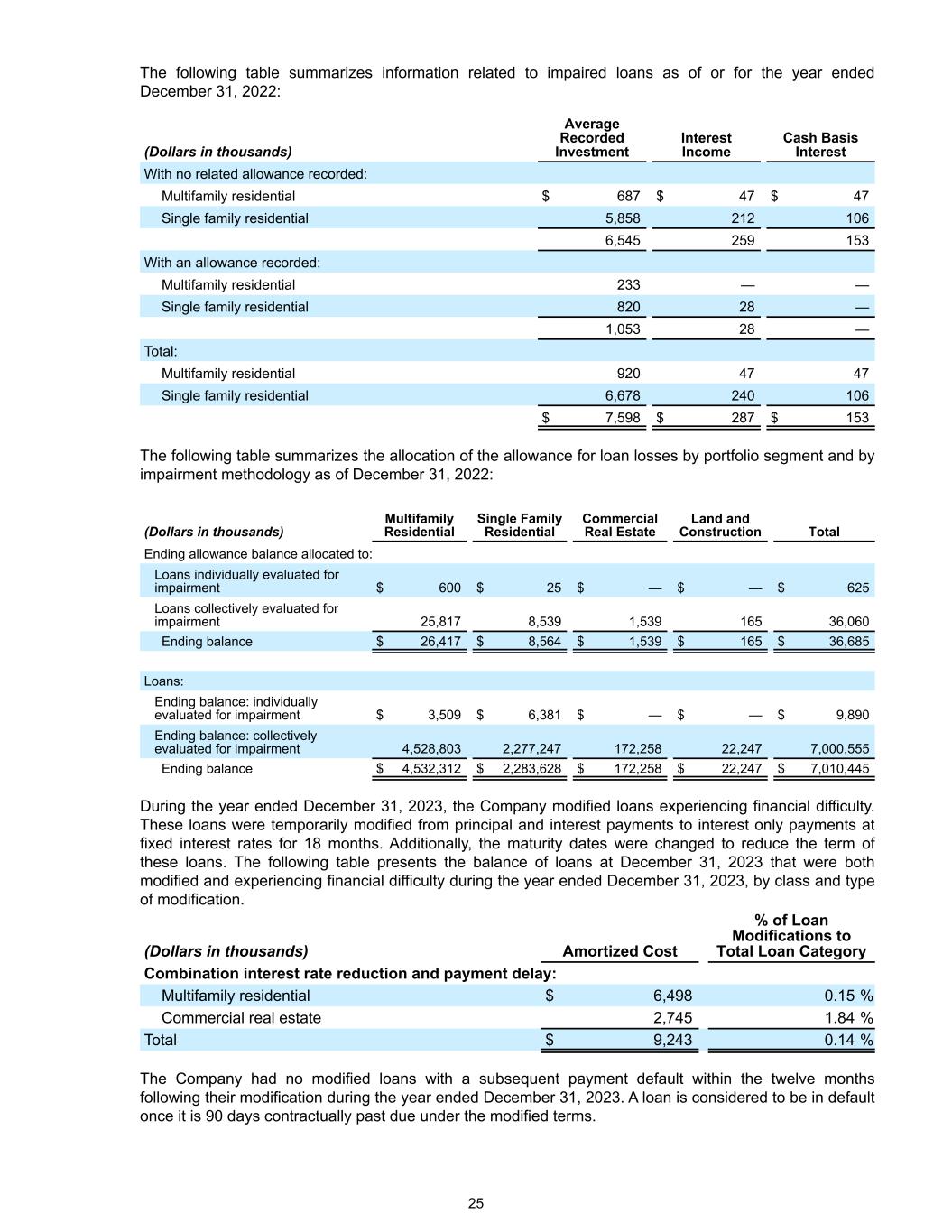
The following table summarizes information related to impaired loans as of or for the year ended December 31, 2022: (Dollars in thousands) Average Recorded Investment Interest Income Cash Basis Interest With no related allowance recorded: Multifamily residential $ 687 $ 47 $ 47 Single family residential 5,858 212 106 6,545 259 153 With an allowance recorded: Multifamily residential 233 — — Single family residential 820 28 — 1,053 28 — Total: Multifamily residential 920 47 47 Single family residential 6,678 240 106 $ 7,598 $ 287 $ 153 The following table summarizes the allocation of the allowance for loan losses by portfolio segment and by impairment methodology as of December 31, 2022: (Dollars in thousands) Multifamily Residential Single Family Residential Commercial Real Estate Land and Construction Total Ending allowance balance allocated to: Loans individually evaluated for impairment $ 600 $ 25 $ — $ — $ 625 Loans collectively evaluated for impairment 25,817 8,539 1,539 165 36,060 Ending balance $ 26,417 $ 8,564 $ 1,539 $ 165 $ 36,685 Loans: Ending balance: individually evaluated for impairment $ 3,509 $ 6,381 $ — $ — $ 9,890 Ending balance: collectively evaluated for impairment 4,528,803 2,277,247 172,258 22,247 7,000,555 Ending balance $ 4,532,312 $ 2,283,628 $ 172,258 $ 22,247 $ 7,010,445 During the year ended December 31, 2023, the Company modified loans experiencing financial difficulty. These loans were temporarily modified from principal and interest payments to interest only payments at fixed interest rates for 18 months. Additionally, the maturity dates were changed to reduce the term of these loans. The following table presents the balance of loans at December 31, 2023 that were both modified and experiencing financial difficulty during the year ended December 31, 2023, by class and type of modification. (Dollars in thousands) Amortized Cost % of Loan Modifications to Total Loan Category Combination interest rate reduction and payment delay: Multifamily residential $ 6,498 0.15 % Commercial real estate 2,745 1.84 % Total $ 9,243 0.14 % The Company had no modified loans with a subsequent payment default within the twelve months following their modification during the year ended December 31, 2023. A loan is considered to be in default once it is 90 days contractually past due under the modified terms. 25
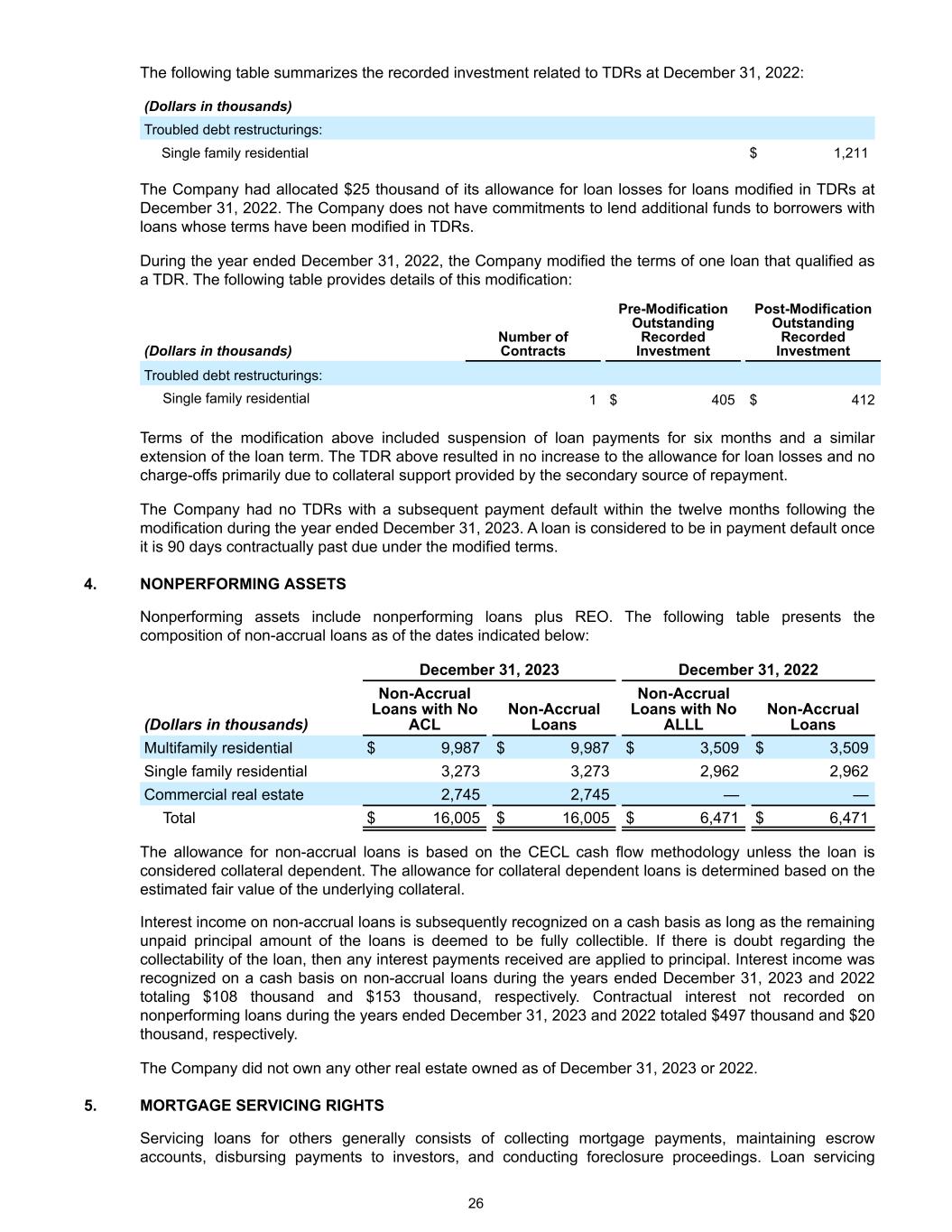
The following table summarizes the recorded investment related to TDRs at December 31, 2022: (Dollars in thousands) Troubled debt restructurings: Single family residential $ 1,211 The Company had allocated $25 thousand of its allowance for loan losses for loans modified in TDRs at December 31, 2022. The Company does not have commitments to lend additional funds to borrowers with loans whose terms have been modified in TDRs. During the year ended December 31, 2022, the Company modified the terms of one loan that qualified as a TDR. The following table provides details of this modification: (Dollars in thousands) Number of Contracts Pre-Modification Outstanding Recorded Investment Post-Modification Outstanding Recorded Investment Troubled debt restructurings: Single family residential 1 $ 405 $ 412 Terms of the modification above included suspension of loan payments for six months and a similar extension of the loan term. The TDR above resulted in no increase to the allowance for loan losses and no charge-offs primarily due to collateral support provided by the secondary source of repayment. The Company had no TDRs with a subsequent payment default within the twelve months following the modification during the year ended December 31, 2023. A loan is considered to be in payment default once it is 90 days contractually past due under the modified terms. 4. NONPERFORMING ASSETS Nonperforming assets include nonperforming loans plus REO. The following table presents the composition of non-accrual loans as of the dates indicated below: December 31, 2023 December 31, 2022 (Dollars in thousands) Non-Accrual Loans with No ACL Non-Accrual Loans Non-Accrual Loans with No ALLL Non-Accrual Loans Multifamily residential $ 9,987 $ 9,987 $ 3,509 $ 3,509 Single family residential 3,273 3,273 2,962 2,962 Commercial real estate 2,745 2,745 — — Total $ 16,005 $ 16,005 $ 6,471 $ 6,471 The allowance for non-accrual loans is based on the CECL cash flow methodology unless the loan is considered collateral dependent. The allowance for collateral dependent loans is determined based on the estimated fair value of the underlying collateral. Interest income on non-accrual loans is subsequently recognized on a cash basis as long as the remaining unpaid principal amount of the loans is deemed to be fully collectible. If there is doubt regarding the collectability of the loan, then any interest payments received are applied to principal. Interest income was recognized on a cash basis on non-accrual loans during the years ended December 31, 2023 and 2022 totaling $108 thousand and $153 thousand, respectively. Contractual interest not recorded on nonperforming loans during the years ended December 31, 2023 and 2022 totaled $497 thousand and $20 thousand, respectively. The Company did not own any other real estate owned as of December 31, 2023 or 2022. 5. MORTGAGE SERVICING RIGHTS Servicing loans for others generally consists of collecting mortgage payments, maintaining escrow accounts, disbursing payments to investors, and conducting foreclosure proceedings. Loan servicing 26
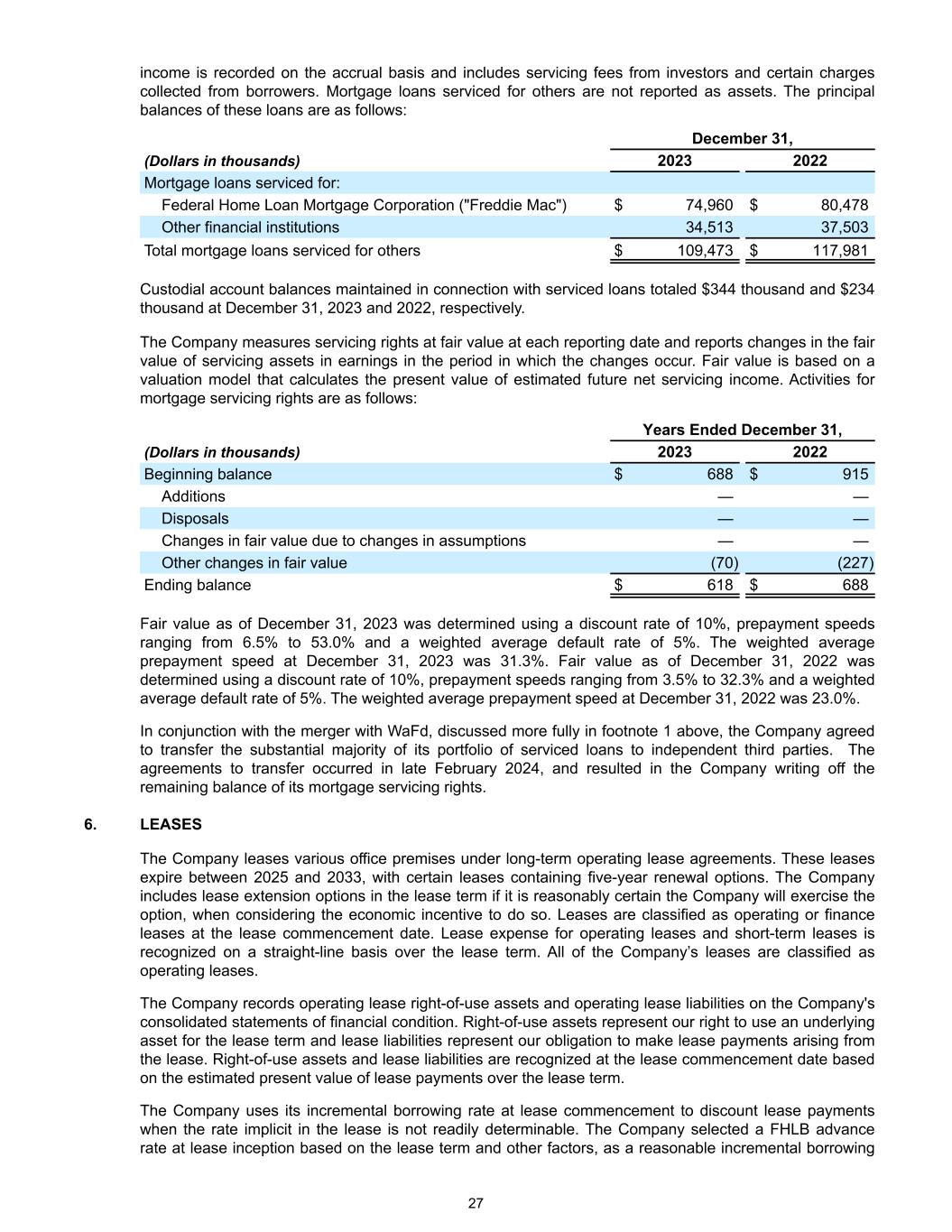
income is recorded on the accrual basis and includes servicing fees from investors and certain charges collected from borrowers. Mortgage loans serviced for others are not reported as assets. The principal balances of these loans are as follows: December 31, (Dollars in thousands) 2023 2022 Mortgage loans serviced for: Federal Home Loan Mortgage Corporation ("Freddie Mac") $ 74,960 $ 80,478 Other financial institutions 34,513 37,503 Total mortgage loans serviced for others $ 109,473 $ 117,981 Custodial account balances maintained in connection with serviced loans totaled $344 thousand and $234 thousand at December 31, 2023 and 2022, respectively. The Company measures servicing rights at fair value at each reporting date and reports changes in the fair value of servicing assets in earnings in the period in which the changes occur. Fair value is based on a valuation model that calculates the present value of estimated future net servicing income. Activities for mortgage servicing rights are as follows: Years Ended December 31, (Dollars in thousands) 2023 2022 Beginning balance $ 688 $ 915 Additions — — Disposals — — Changes in fair value due to changes in assumptions — — Other changes in fair value (70) (227) Ending balance $ 618 $ 688 Fair value as of December 31, 2023 was determined using a discount rate of 10%, prepayment speeds ranging from 6.5% to 53.0% and a weighted average default rate of 5%. The weighted average prepayment speed at December 31, 2023 was 31.3%. Fair value as of December 31, 2022 was determined using a discount rate of 10%, prepayment speeds ranging from 3.5% to 32.3% and a weighted average default rate of 5%. The weighted average prepayment speed at December 31, 2022 was 23.0%. In conjunction with the merger with WaFd, discussed more fully in footnote 1 above, the Company agreed to transfer the substantial majority of its portfolio of serviced loans to independent third parties. The agreements to transfer occurred in late February 2024, and resulted in the Company writing off the remaining balance of its mortgage servicing rights. 6. LEASES The Company leases various office premises under long-term operating lease agreements. These leases expire between 2025 and 2033, with certain leases containing five-year renewal options. The Company includes lease extension options in the lease term if it is reasonably certain the Company will exercise the option, when considering the economic incentive to do so. Leases are classified as operating or finance leases at the lease commencement date. Lease expense for operating leases and short-term leases is recognized on a straight-line basis over the lease term. All of the Company’s leases are classified as operating leases. The Company records operating lease right-of-use assets and operating lease liabilities on the Company's consolidated statements of financial condition. Right-of-use assets represent our right to use an underlying asset for the lease term and lease liabilities represent our obligation to make lease payments arising from the lease. Right-of-use assets and lease liabilities are recognized at the lease commencement date based on the estimated present value of lease payments over the lease term. The Company uses its incremental borrowing rate at lease commencement to discount lease payments when the rate implicit in the lease is not readily determinable. The Company selected a FHLB advance rate at lease inception based on the lease term and other factors, as a reasonable incremental borrowing 27
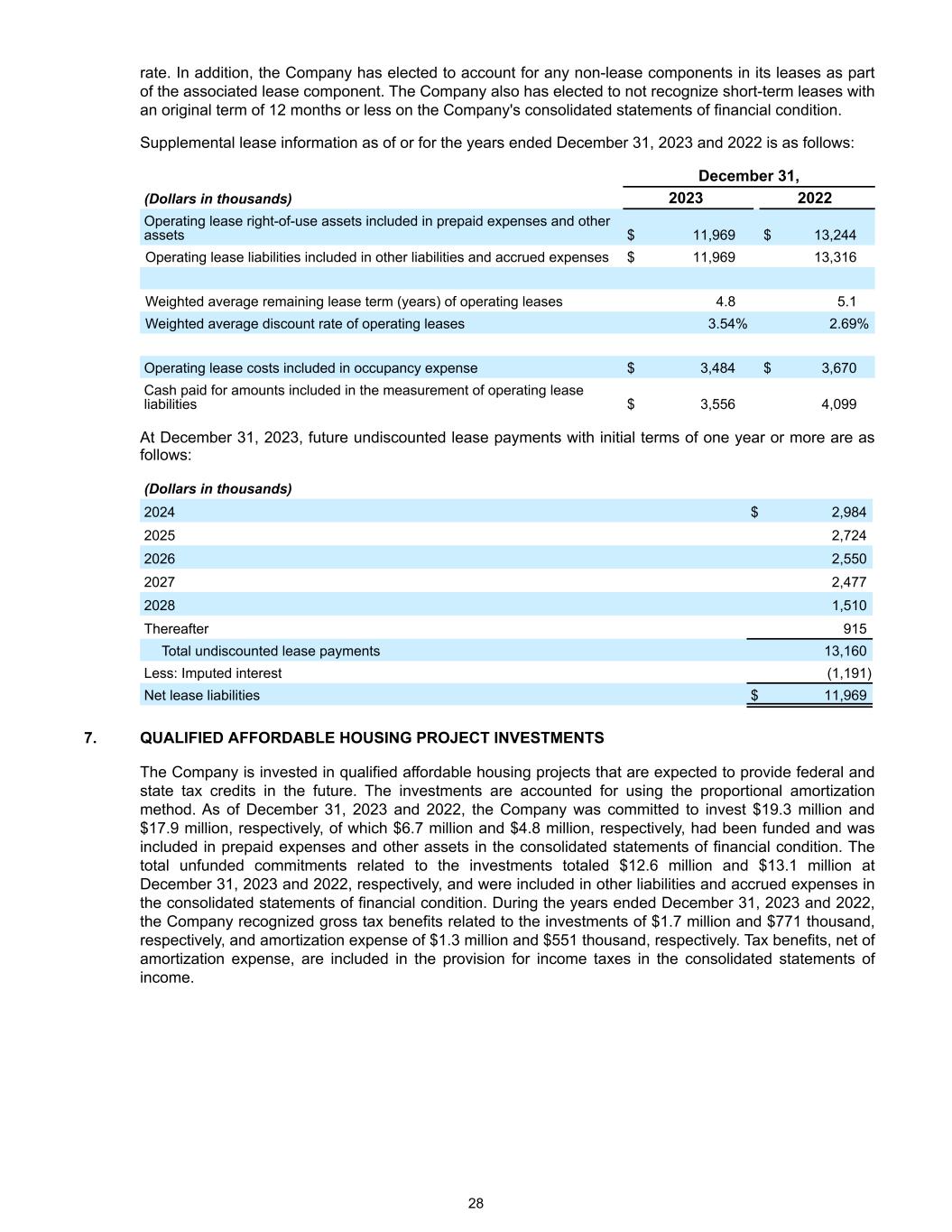
rate. In addition, the Company has elected to account for any non-lease components in its leases as part of the associated lease component. The Company also has elected to not recognize short-term leases with an original term of 12 months or less on the Company's consolidated statements of financial condition. Supplemental lease information as of or for the years ended December 31, 2023 and 2022 is as follows: December 31, (Dollars in thousands) 2023 2022 Operating lease right-of-use assets included in prepaid expenses and other assets $ 11,969 $ 13,244 Operating lease liabilities included in other liabilities and accrued expenses $ 11,969 13,316 Weighted average remaining lease term (years) of operating leases 4.8 5.1 Weighted average discount rate of operating leases 3.54% 2.69% Operating lease costs included in occupancy expense $ 3,484 $ 3,670 Cash paid for amounts included in the measurement of operating lease liabilities $ 3,556 4,099 At December 31, 2023, future undiscounted lease payments with initial terms of one year or more are as follows: (Dollars in thousands) 2024 $ 2,984 2025 2,724 2026 2,550 2027 2,477 2028 1,510 Thereafter 915 Total undiscounted lease payments 13,160 Less: Imputed interest (1,191) Net lease liabilities $ 11,969 7. QUALIFIED AFFORDABLE HOUSING PROJECT INVESTMENTS The Company is invested in qualified affordable housing projects that are expected to provide federal and state tax credits in the future. The investments are accounted for using the proportional amortization method. As of December 31, 2023 and 2022, the Company was committed to invest $19.3 million and $17.9 million, respectively, of which $6.7 million and $4.8 million, respectively, had been funded and was included in prepaid expenses and other assets in the consolidated statements of financial condition. The total unfunded commitments related to the investments totaled $12.6 million and $13.1 million at December 31, 2023 and 2022, respectively, and were included in other liabilities and accrued expenses in the consolidated statements of financial condition. During the years ended December 31, 2023 and 2022, the Company recognized gross tax benefits related to the investments of $1.7 million and $771 thousand, respectively, and amortization expense of $1.3 million and $551 thousand, respectively. Tax benefits, net of amortization expense, are included in the provision for income taxes in the consolidated statements of income. 28
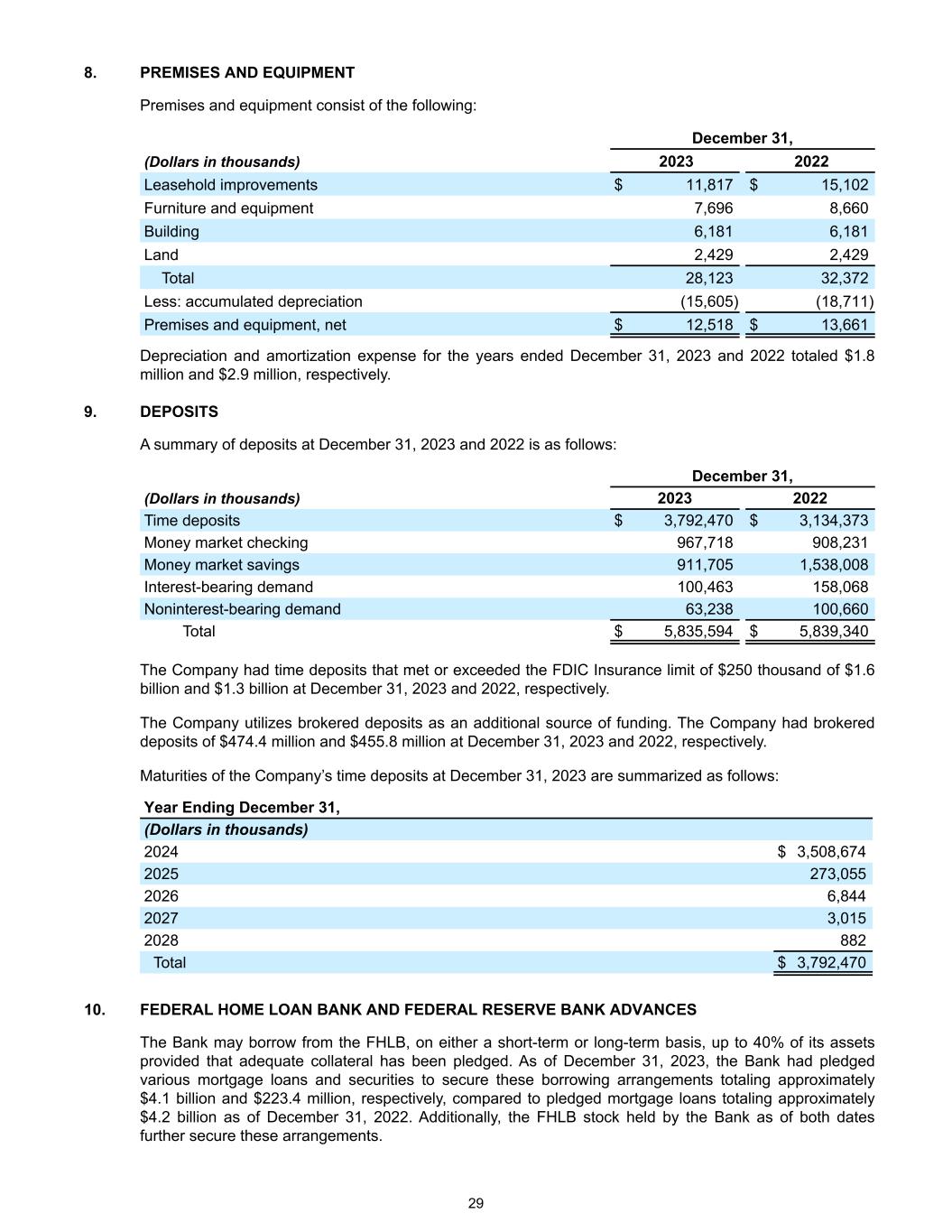
8. PREMISES AND EQUIPMENT Premises and equipment consist of the following: December 31, (Dollars in thousands) 2023 2022 Leasehold improvements $ 11,817 $ 15,102 Furniture and equipment 7,696 8,660 Building 6,181 6,181 Land 2,429 2,429 Total 28,123 32,372 Less: accumulated depreciation (15,605) (18,711) Premises and equipment, net $ 12,518 $ 13,661 Depreciation and amortization expense for the years ended December 31, 2023 and 2022 totaled $1.8 million and $2.9 million, respectively. 9. DEPOSITS A summary of deposits at December 31, 2023 and 2022 is as follows: December 31, (Dollars in thousands) 2023 2022 Time deposits $ 3,792,470 $ 3,134,373 Money market checking 967,718 908,231 Money market savings 911,705 1,538,008 Interest-bearing demand 100,463 158,068 Noninterest-bearing demand 63,238 100,660 Total $ 5,835,594 $ 5,839,340 The Company had time deposits that met or exceeded the FDIC Insurance limit of $250 thousand of $1.6 billion and $1.3 billion at December 31, 2023 and 2022, respectively. The Company utilizes brokered deposits as an additional source of funding. The Company had brokered deposits of $474.4 million and $455.8 million at December 31, 2023 and 2022, respectively. Maturities of the Company’s time deposits at December 31, 2023 are summarized as follows: Year Ending December 31, (Dollars in thousands) 2024 $ 3,508,674 2025 273,055 2026 6,844 2027 3,015 2028 882 Total $ 3,792,470 10. FEDERAL HOME LOAN BANK AND FEDERAL RESERVE BANK ADVANCES The Bank may borrow from the FHLB, on either a short-term or long-term basis, up to 40% of its assets provided that adequate collateral has been pledged. As of December 31, 2023, the Bank had pledged various mortgage loans and securities to secure these borrowing arrangements totaling approximately $4.1 billion and $223.4 million, respectively, compared to pledged mortgage loans totaling approximately $4.2 billion as of December 31, 2022. Additionally, the FHLB stock held by the Bank as of both dates further secure these arrangements. 29
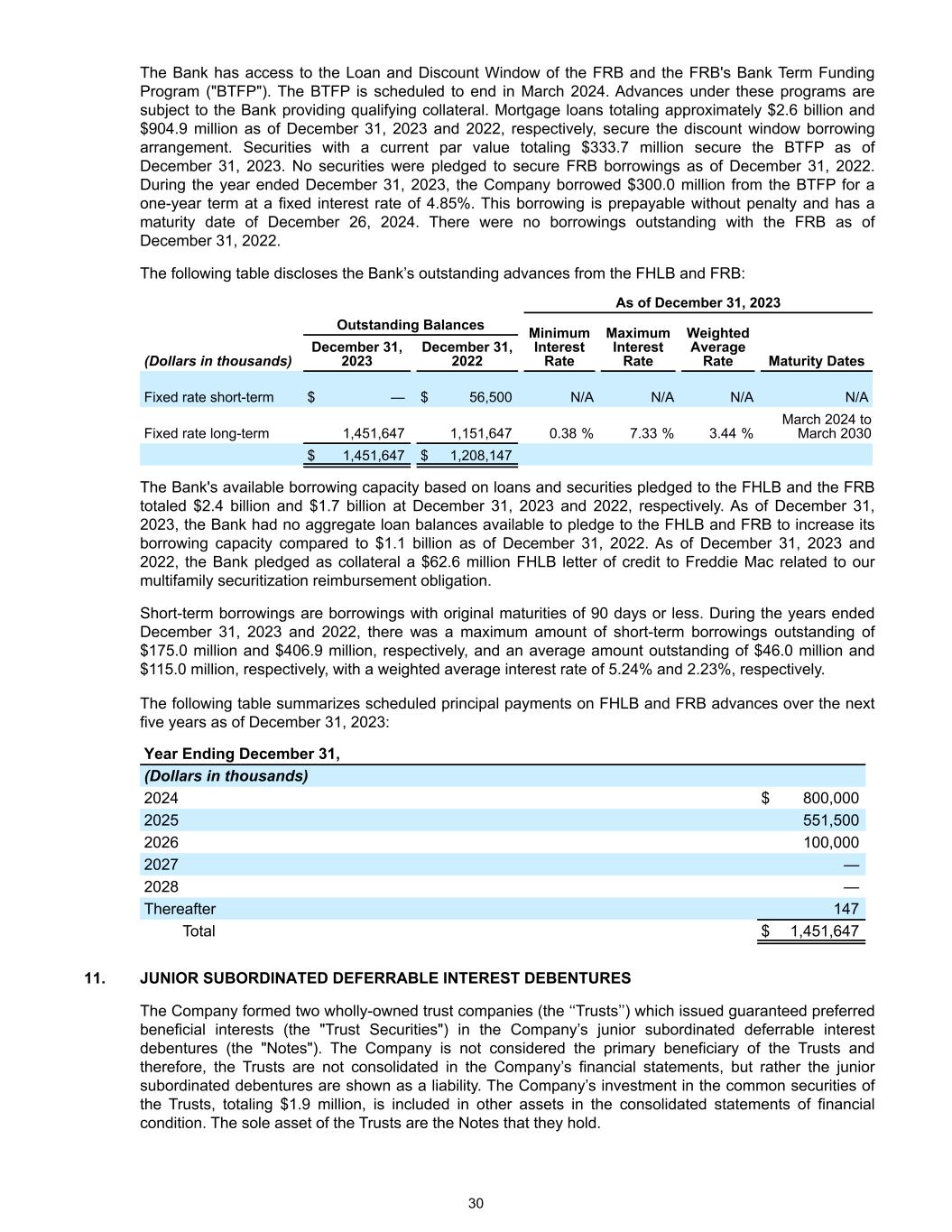
The Bank has access to the Loan and Discount Window of the FRB and the FRB's Bank Term Funding Program ("BTFP"). The BTFP is scheduled to end in March 2024. Advances under these programs are subject to the Bank providing qualifying collateral. Mortgage loans totaling approximately $2.6 billion and $904.9 million as of December 31, 2023 and 2022, respectively, secure the discount window borrowing arrangement. Securities with a current par value totaling $333.7 million secure the BTFP as of December 31, 2023. No securities were pledged to secure FRB borrowings as of December 31, 2022. During the year ended December 31, 2023, the Company borrowed $300.0 million from the BTFP for a one-year term at a fixed interest rate of 4.85%. This borrowing is prepayable without penalty and has a maturity date of December 26, 2024. There were no borrowings outstanding with the FRB as of December 31, 2022. The following table discloses the Bank’s outstanding advances from the FHLB and FRB: As of December 31, 2023 Outstanding Balances Minimum Interest Rate Maximum Interest Rate Weighted Average Rate(Dollars in thousands) December 31, 2023 December 31, 2022 Maturity Dates Fixed rate short-term $ — $ 56,500 N/A N/A N/A N/A Fixed rate long-term 1,451,647 1,151,647 0.38 % 7.33 % 3.44 % March 2024 to March 2030 $ 1,451,647 $ 1,208,147 The Bank's available borrowing capacity based on loans and securities pledged to the FHLB and the FRB totaled $2.4 billion and $1.7 billion at December 31, 2023 and 2022, respectively. As of December 31, 2023, the Bank had no aggregate loan balances available to pledge to the FHLB and FRB to increase its borrowing capacity compared to $1.1 billion as of December 31, 2022. As of December 31, 2023 and 2022, the Bank pledged as collateral a $62.6 million FHLB letter of credit to Freddie Mac related to our multifamily securitization reimbursement obligation. Short-term borrowings are borrowings with original maturities of 90 days or less. During the years ended December 31, 2023 and 2022, there was a maximum amount of short-term borrowings outstanding of $175.0 million and $406.9 million, respectively, and an average amount outstanding of $46.0 million and $115.0 million, respectively, with a weighted average interest rate of 5.24% and 2.23%, respectively. The following table summarizes scheduled principal payments on FHLB and FRB advances over the next five years as of December 31, 2023: Year Ending December 31, (Dollars in thousands) 2024 $ 800,000 2025 551,500 2026 100,000 2027 — 2028 — Thereafter 147 Total $ 1,451,647 11. JUNIOR SUBORDINATED DEFERRABLE INTEREST DEBENTURES The Company formed two wholly-owned trust companies (the ‘‘Trusts’’) which issued guaranteed preferred beneficial interests (the "Trust Securities") in the Company’s junior subordinated deferrable interest debentures (the "Notes"). The Company is not considered the primary beneficiary of the Trusts and therefore, the Trusts are not consolidated in the Company’s financial statements, but rather the junior subordinated debentures are shown as a liability. The Company’s investment in the common securities of the Trusts, totaling $1.9 million, is included in other assets in the consolidated statements of financial condition. The sole asset of the Trusts are the Notes that they hold. 30
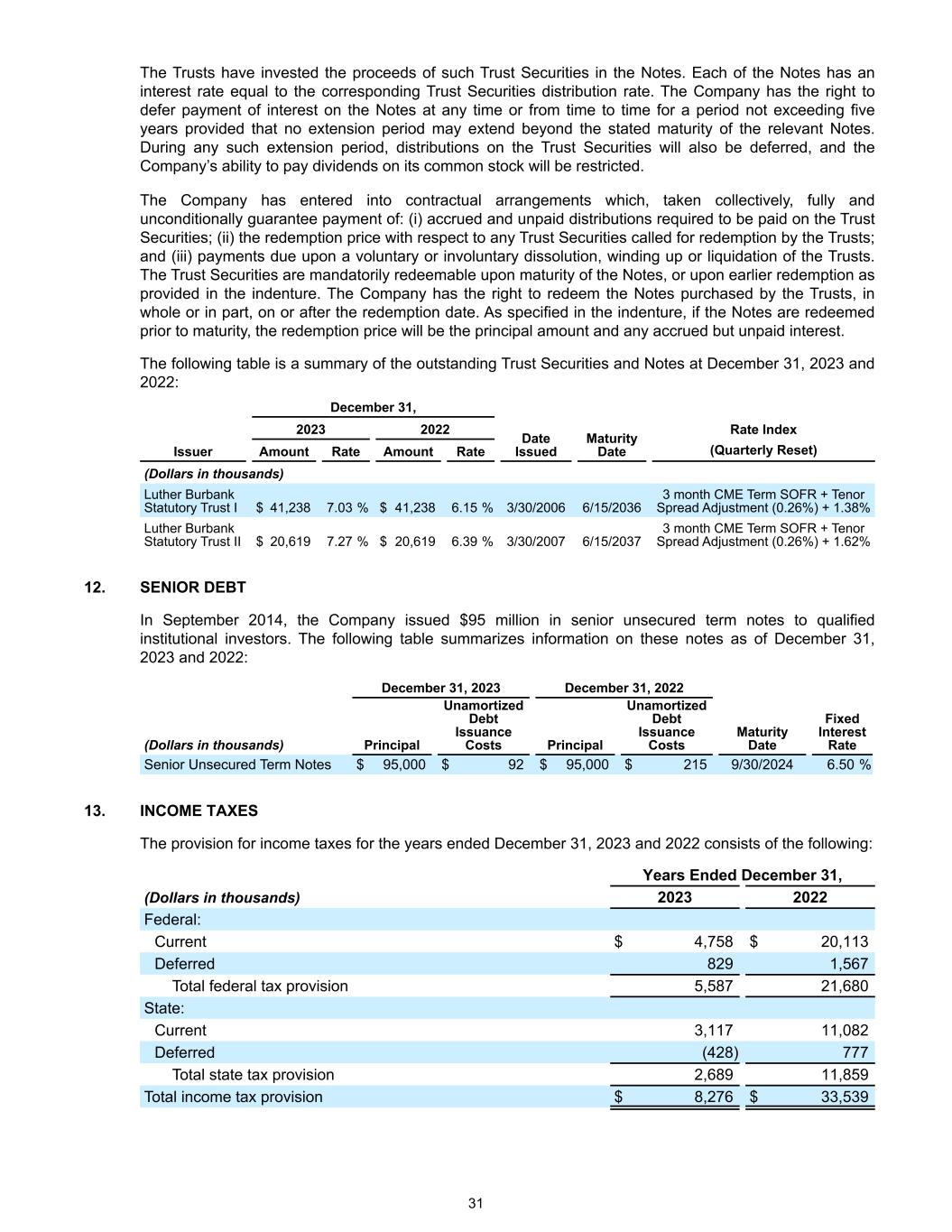
The Trusts have invested the proceeds of such Trust Securities in the Notes. Each of the Notes has an interest rate equal to the corresponding Trust Securities distribution rate. The Company has the right to defer payment of interest on the Notes at any time or from time to time for a period not exceeding five years provided that no extension period may extend beyond the stated maturity of the relevant Notes. During any such extension period, distributions on the Trust Securities will also be deferred, and the Company’s ability to pay dividends on its common stock will be restricted. The Company has entered into contractual arrangements which, taken collectively, fully and unconditionally guarantee payment of: (i) accrued and unpaid distributions required to be paid on the Trust Securities; (ii) the redemption price with respect to any Trust Securities called for redemption by the Trusts; and (iii) payments due upon a voluntary or involuntary dissolution, winding up or liquidation of the Trusts. The Trust Securities are mandatorily redeemable upon maturity of the Notes, or upon earlier redemption as provided in the indenture. The Company has the right to redeem the Notes purchased by the Trusts, in whole or in part, on or after the redemption date. As specified in the indenture, if the Notes are redeemed prior to maturity, the redemption price will be the principal amount and any accrued but unpaid interest. The following table is a summary of the outstanding Trust Securities and Notes at December 31, 2023 and 2022: December 31, 2023 2022 Date Issued Maturity Date Rate Index Issuer Amount Rate Amount Rate (Quarterly Reset) (Dollars in thousands) Luther Burbank Statutory Trust I $ 41,238 7.03 % $ 41,238 6.15 % 3/30/2006 6/15/2036 3 month CME Term SOFR + Tenor Spread Adjustment (0.26%) + 1.38% Luther Burbank Statutory Trust II $ 20,619 7.27 % $ 20,619 6.39 % 3/30/2007 6/15/2037 3 month CME Term SOFR + Tenor Spread Adjustment (0.26%) + 1.62% 12. SENIOR DEBT In September 2014, the Company issued $95 million in senior unsecured term notes to qualified institutional investors. The following table summarizes information on these notes as of December 31, 2023 and 2022: December 31, 2023 December 31, 2022 (Dollars in thousands) Principal Unamortized Debt Issuance Costs Principal Unamortized Debt Issuance Costs Maturity Date Fixed Interest Rate Senior Unsecured Term Notes $ 95,000 $ 92 $ 95,000 $ 215 9/30/2024 6.50 % 13. INCOME TAXES The provision for income taxes for the years ended December 31, 2023 and 2022 consists of the following: Years Ended December 31, (Dollars in thousands) 2023 2022 Federal: Current $ 4,758 $ 20,113 Deferred 829 1,567 Total federal tax provision 5,587 21,680 State: Current 3,117 11,082 Deferred (428) 777 Total state tax provision 2,689 11,859 Total income tax provision $ 8,276 $ 33,539 31
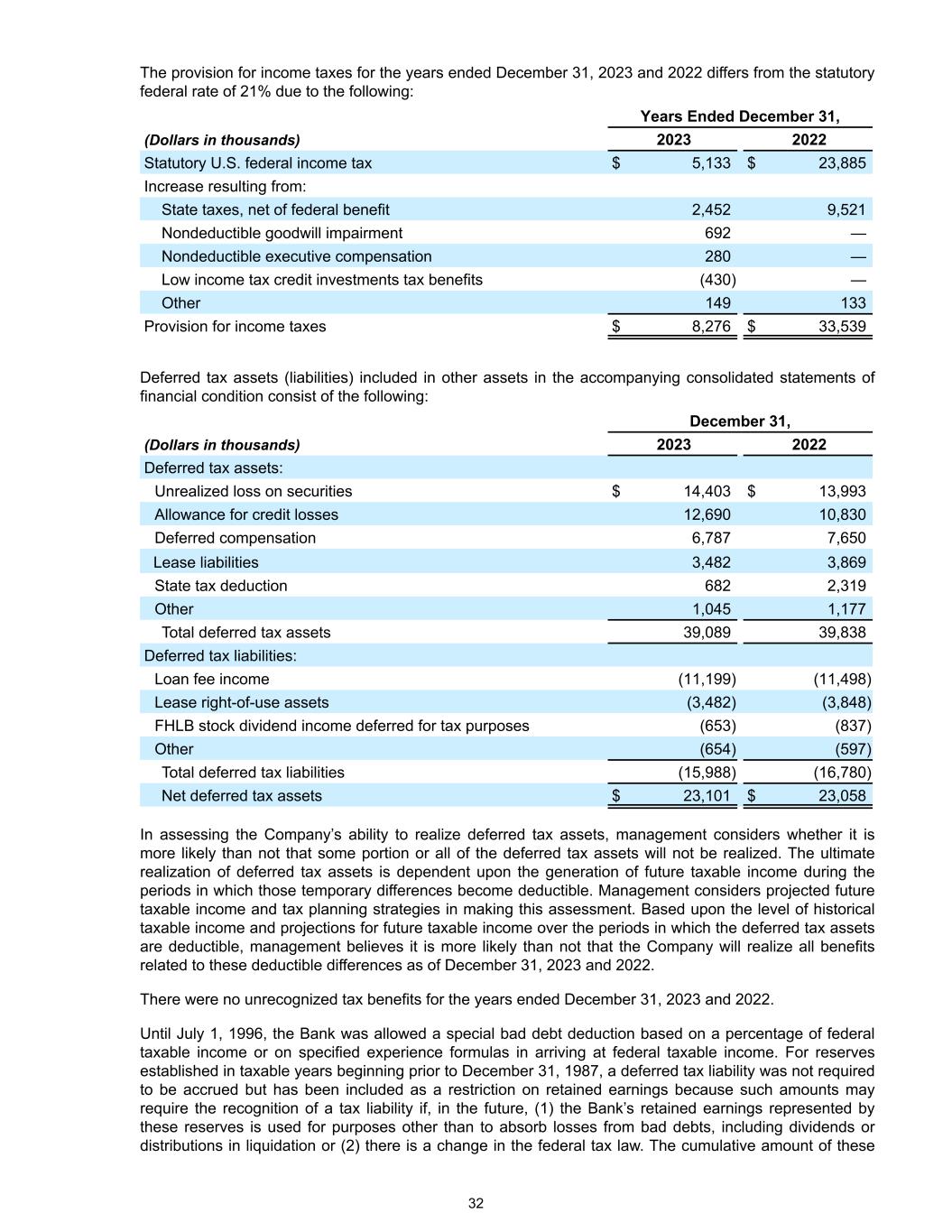
The provision for income taxes for the years ended December 31, 2023 and 2022 differs from the statutory federal rate of 21% due to the following: Years Ended December 31, (Dollars in thousands) 2023 2022 Statutory U.S. federal income tax $ 5,133 $ 23,885 Increase resulting from: State taxes, net of federal benefit 2,452 9,521 Nondeductible goodwill impairment 692 — Nondeductible executive compensation 280 — Low income tax credit investments tax benefits (430) — Other 149 133 Provision for income taxes $ 8,276 $ 33,539 Deferred tax assets (liabilities) included in other assets in the accompanying consolidated statements of financial condition consist of the following: December 31, (Dollars in thousands) 2023 2022 Deferred tax assets: Unrealized loss on securities $ 14,403 $ 13,993 Allowance for credit losses 12,690 10,830 Deferred compensation 6,787 7,650 Lease liabilities 3,482 3,869 State tax deduction 682 2,319 Other 1,045 1,177 Total deferred tax assets 39,089 39,838 Deferred tax liabilities: Loan fee income (11,199) (11,498) Lease right-of-use assets (3,482) (3,848) FHLB stock dividend income deferred for tax purposes (653) (837) Other (654) (597) Total deferred tax liabilities (15,988) (16,780) Net deferred tax assets $ 23,101 $ 23,058 In assessing the Company’s ability to realize deferred tax assets, management considers whether it is more likely than not that some portion or all of the deferred tax assets will not be realized. The ultimate realization of deferred tax assets is dependent upon the generation of future taxable income during the periods in which those temporary differences become deductible. Management considers projected future taxable income and tax planning strategies in making this assessment. Based upon the level of historical taxable income and projections for future taxable income over the periods in which the deferred tax assets are deductible, management believes it is more likely than not that the Company will realize all benefits related to these deductible differences as of December 31, 2023 and 2022. There were no unrecognized tax benefits for the years ended December 31, 2023 and 2022. Until July 1, 1996, the Bank was allowed a special bad debt deduction based on a percentage of federal taxable income or on specified experience formulas in arriving at federal taxable income. For reserves established in taxable years beginning prior to December 31, 1987, a deferred tax liability was not required to be accrued but has been included as a restriction on retained earnings because such amounts may require the recognition of a tax liability if, in the future, (1) the Bank’s retained earnings represented by these reserves is used for purposes other than to absorb losses from bad debts, including dividends or distributions in liquidation or (2) there is a change in the federal tax law. The cumulative amount of these 32
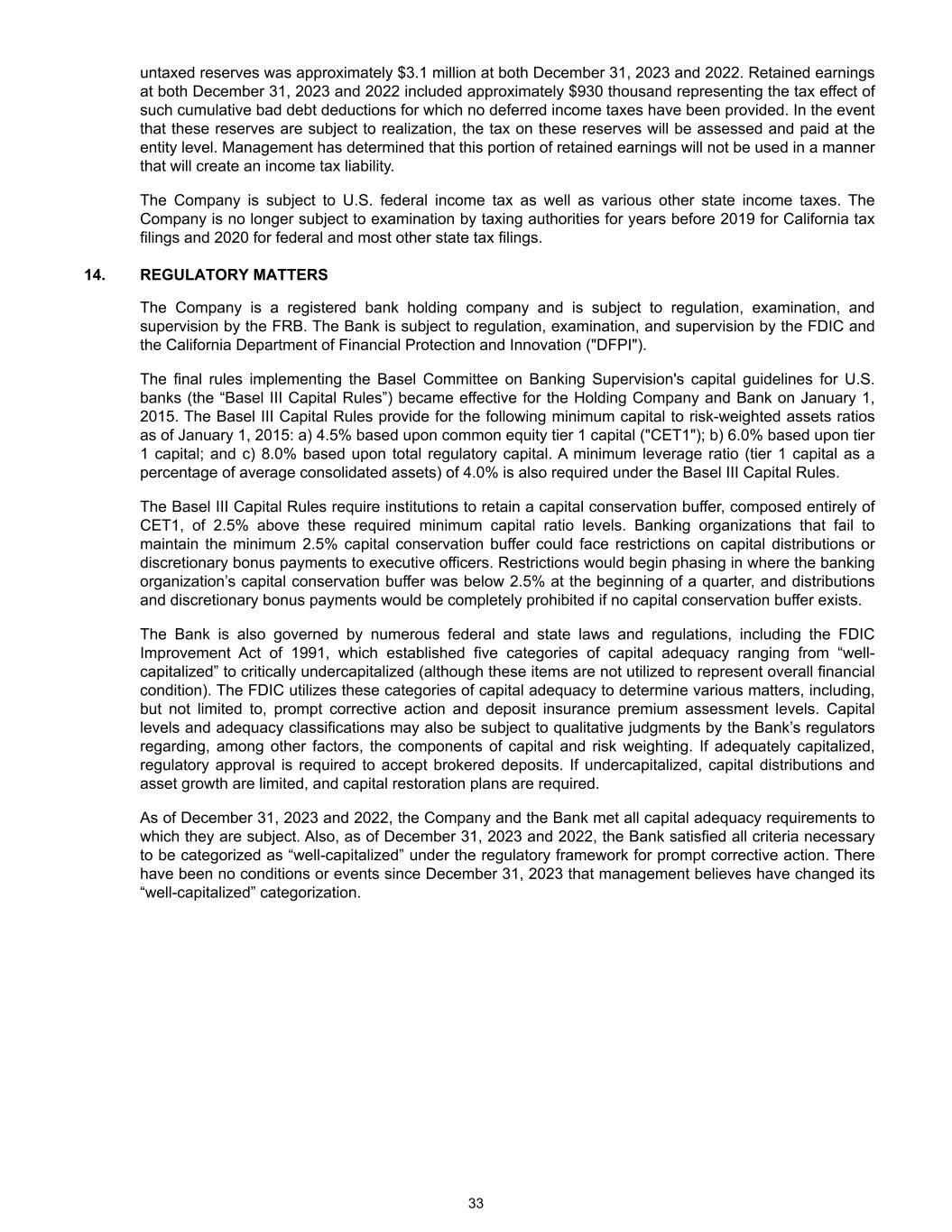
untaxed reserves was approximately $3.1 million at both December 31, 2023 and 2022. Retained earnings at both December 31, 2023 and 2022 included approximately $930 thousand representing the tax effect of such cumulative bad debt deductions for which no deferred income taxes have been provided. In the event that these reserves are subject to realization, the tax on these reserves will be assessed and paid at the entity level. Management has determined that this portion of retained earnings will not be used in a manner that will create an income tax liability. The Company is subject to U.S. federal income tax as well as various other state income taxes. The Company is no longer subject to examination by taxing authorities for years before 2019 for California tax filings and 2020 for federal and most other state tax filings. 14. REGULATORY MATTERS The Company is a registered bank holding company and is subject to regulation, examination, and supervision by the FRB. The Bank is subject to regulation, examination, and supervision by the FDIC and the California Department of Financial Protection and Innovation ("DFPI"). The final rules implementing the Basel Committee on Banking Supervision's capital guidelines for U.S. banks (the “Basel III Capital Rules”) became effective for the Holding Company and Bank on January 1, 2015. The Basel III Capital Rules provide for the following minimum capital to risk-weighted assets ratios as of January 1, 2015: a) 4.5% based upon common equity tier 1 capital ("CET1"); b) 6.0% based upon tier 1 capital; and c) 8.0% based upon total regulatory capital. A minimum leverage ratio (tier 1 capital as a percentage of average consolidated assets) of 4.0% is also required under the Basel III Capital Rules. The Basel III Capital Rules require institutions to retain a capital conservation buffer, composed entirely of CET1, of 2.5% above these required minimum capital ratio levels. Banking organizations that fail to maintain the minimum 2.5% capital conservation buffer could face restrictions on capital distributions or discretionary bonus payments to executive officers. Restrictions would begin phasing in where the banking organization’s capital conservation buffer was below 2.5% at the beginning of a quarter, and distributions and discretionary bonus payments would be completely prohibited if no capital conservation buffer exists. The Bank is also governed by numerous federal and state laws and regulations, including the FDIC Improvement Act of 1991, which established five categories of capital adequacy ranging from “well- capitalized” to critically undercapitalized (although these items are not utilized to represent overall financial condition). The FDIC utilizes these categories of capital adequacy to determine various matters, including, but not limited to, prompt corrective action and deposit insurance premium assessment levels. Capital levels and adequacy classifications may also be subject to qualitative judgments by the Bank’s regulators regarding, among other factors, the components of capital and risk weighting. If adequately capitalized, regulatory approval is required to accept brokered deposits. If undercapitalized, capital distributions and asset growth are limited, and capital restoration plans are required. As of December 31, 2023 and 2022, the Company and the Bank met all capital adequacy requirements to which they are subject. Also, as of December 31, 2023 and 2022, the Bank satisfied all criteria necessary to be categorized as “well-capitalized” under the regulatory framework for prompt corrective action. There have been no conditions or events since December 31, 2023 that management believes have changed its “well-capitalized” categorization. 33
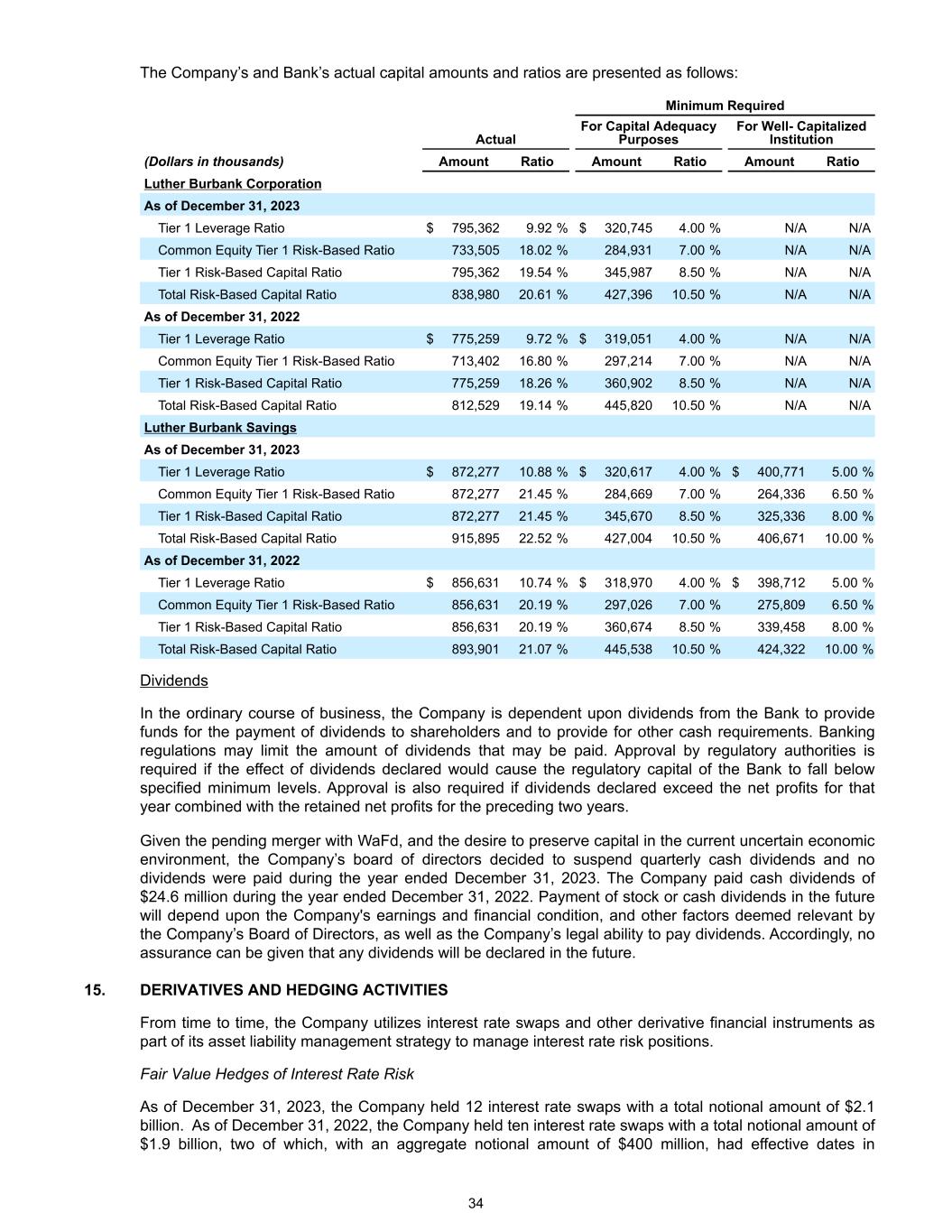
The Company’s and Bank’s actual capital amounts and ratios are presented as follows: Minimum Required Actual For Capital Adequacy Purposes For Well- Capitalized Institution (Dollars in thousands) Amount Ratio Amount Ratio Amount Ratio Luther Burbank Corporation As of December 31, 2023 Tier 1 Leverage Ratio $ 795,362 9.92 % $ 320,745 4.00 % N/A N/A Common Equity Tier 1 Risk-Based Ratio 733,505 18.02 % 284,931 7.00 % N/A N/A Tier 1 Risk-Based Capital Ratio 795,362 19.54 % 345,987 8.50 % N/A N/A Total Risk-Based Capital Ratio 838,980 20.61 % 427,396 10.50 % N/A N/A As of December 31, 2022 Tier 1 Leverage Ratio $ 775,259 9.72 % $ 319,051 4.00 % N/A N/A Common Equity Tier 1 Risk-Based Ratio 713,402 16.80 % 297,214 7.00 % N/A N/A Tier 1 Risk-Based Capital Ratio 775,259 18.26 % 360,902 8.50 % N/A N/A Total Risk-Based Capital Ratio 812,529 19.14 % 445,820 10.50 % N/A N/A Luther Burbank Savings As of December 31, 2023 Tier 1 Leverage Ratio $ 872,277 10.88 % $ 320,617 4.00 % $ 400,771 5.00 % Common Equity Tier 1 Risk-Based Ratio 872,277 21.45 % 284,669 7.00 % 264,336 6.50 % Tier 1 Risk-Based Capital Ratio 872,277 21.45 % 345,670 8.50 % 325,336 8.00 % Total Risk-Based Capital Ratio 915,895 22.52 % 427,004 10.50 % 406,671 10.00 % As of December 31, 2022 Tier 1 Leverage Ratio $ 856,631 10.74 % $ 318,970 4.00 % $ 398,712 5.00 % Common Equity Tier 1 Risk-Based Ratio 856,631 20.19 % 297,026 7.00 % 275,809 6.50 % Tier 1 Risk-Based Capital Ratio 856,631 20.19 % 360,674 8.50 % 339,458 8.00 % Total Risk-Based Capital Ratio 893,901 21.07 % 445,538 10.50 % 424,322 10.00 % Dividends In the ordinary course of business, the Company is dependent upon dividends from the Bank to provide funds for the payment of dividends to shareholders and to provide for other cash requirements. Banking regulations may limit the amount of dividends that may be paid. Approval by regulatory authorities is required if the effect of dividends declared would cause the regulatory capital of the Bank to fall below specified minimum levels. Approval is also required if dividends declared exceed the net profits for that year combined with the retained net profits for the preceding two years. Given the pending merger with WaFd, and the desire to preserve capital in the current uncertain economic environment, the Company’s board of directors decided to suspend quarterly cash dividends and no dividends were paid during the year ended December 31, 2023. The Company paid cash dividends of $24.6 million during the year ended December 31, 2022. Payment of stock or cash dividends in the future will depend upon the Company's earnings and financial condition, and other factors deemed relevant by the Company’s Board of Directors, as well as the Company’s legal ability to pay dividends. Accordingly, no assurance can be given that any dividends will be declared in the future. 15. DERIVATIVES AND HEDGING ACTIVITIES From time to time, the Company utilizes interest rate swaps and other derivative financial instruments as part of its asset liability management strategy to manage interest rate risk positions. Fair Value Hedges of Interest Rate Risk As of December 31, 2023, the Company held 12 interest rate swaps with a total notional amount of $2.1 billion. As of December 31, 2022, the Company held ten interest rate swaps with a total notional amount of $1.9 billion, two of which, with an aggregate notional amount of $400 million, had effective dates in 34
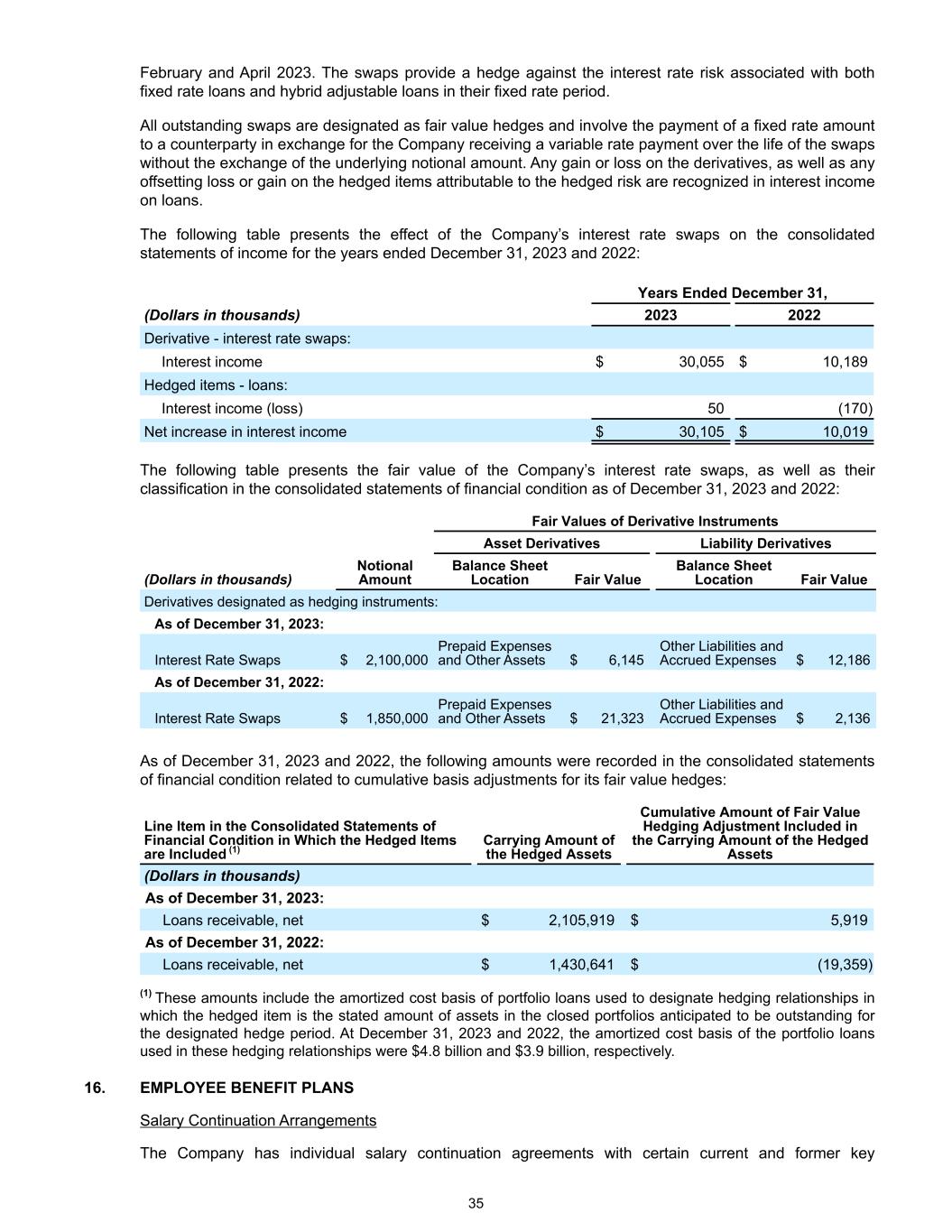
February and April 2023. The swaps provide a hedge against the interest rate risk associated with both fixed rate loans and hybrid adjustable loans in their fixed rate period. All outstanding swaps are designated as fair value hedges and involve the payment of a fixed rate amount to a counterparty in exchange for the Company receiving a variable rate payment over the life of the swaps without the exchange of the underlying notional amount. Any gain or loss on the derivatives, as well as any offsetting loss or gain on the hedged items attributable to the hedged risk are recognized in interest income on loans. The following table presents the effect of the Company’s interest rate swaps on the consolidated statements of income for the years ended December 31, 2023 and 2022: Years Ended December 31, (Dollars in thousands) 2023 2022 Derivative - interest rate swaps: Interest income $ 30,055 $ 10,189 Hedged items - loans: Interest income (loss) 50 (170) Net increase in interest income $ 30,105 $ 10,019 The following table presents the fair value of the Company’s interest rate swaps, as well as their classification in the consolidated statements of financial condition as of December 31, 2023 and 2022: Fair Values of Derivative Instruments Asset Derivatives Liability Derivatives (Dollars in thousands) Notional Amount Balance Sheet Location Fair Value Balance Sheet Location Fair Value Derivatives designated as hedging instruments: As of December 31, 2023: Interest Rate Swaps $ 2,100,000 Prepaid Expenses and Other Assets $ 6,145 Other Liabilities and Accrued Expenses $ 12,186 As of December 31, 2022: Interest Rate Swaps $ 1,850,000 Prepaid Expenses and Other Assets $ 21,323 Other Liabilities and Accrued Expenses $ 2,136 As of December 31, 2023 and 2022, the following amounts were recorded in the consolidated statements of financial condition related to cumulative basis adjustments for its fair value hedges: Line Item in the Consolidated Statements of Financial Condition in Which the Hedged Items are Included (1) Carrying Amount of the Hedged Assets Cumulative Amount of Fair Value Hedging Adjustment Included in the Carrying Amount of the Hedged Assets (Dollars in thousands) As of December 31, 2023: Loans receivable, net $ 2,105,919 $ 5,919 As of December 31, 2022: Loans receivable, net $ 1,430,641 $ (19,359) (1) These amounts include the amortized cost basis of portfolio loans used to designate hedging relationships in which the hedged item is the stated amount of assets in the closed portfolios anticipated to be outstanding for the designated hedge period. At December 31, 2023 and 2022, the amortized cost basis of the portfolio loans used in these hedging relationships were $4.8 billion and $3.9 billion, respectively. 16. EMPLOYEE BENEFIT PLANS Salary Continuation Arrangements The Company has individual salary continuation agreements with certain current and former key 35
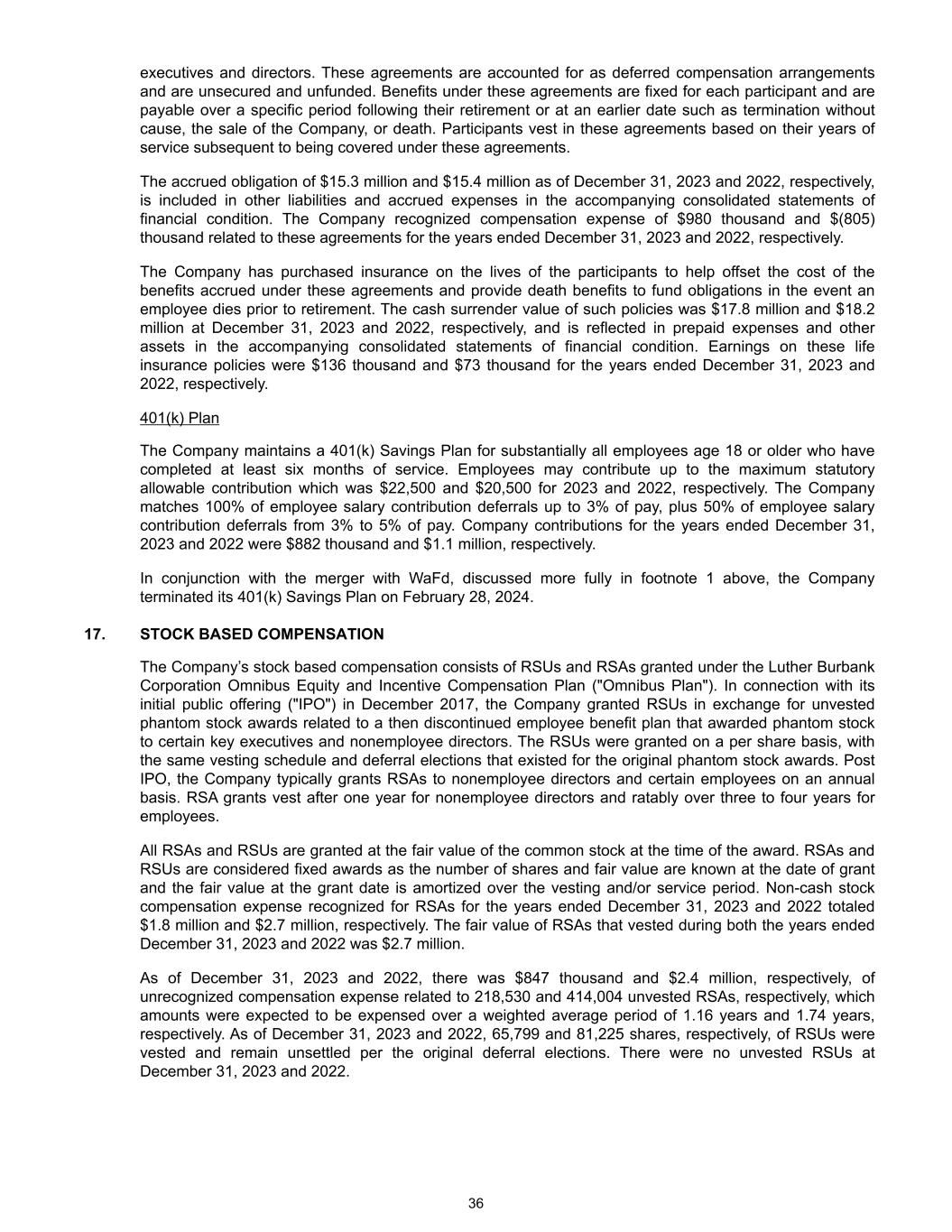
executives and directors. These agreements are accounted for as deferred compensation arrangements and are unsecured and unfunded. Benefits under these agreements are fixed for each participant and are payable over a specific period following their retirement or at an earlier date such as termination without cause, the sale of the Company, or death. Participants vest in these agreements based on their years of service subsequent to being covered under these agreements. The accrued obligation of $15.3 million and $15.4 million as of December 31, 2023 and 2022, respectively, is included in other liabilities and accrued expenses in the accompanying consolidated statements of financial condition. The Company recognized compensation expense of $980 thousand and $(805) thousand related to these agreements for the years ended December 31, 2023 and 2022, respectively. The Company has purchased insurance on the lives of the participants to help offset the cost of the benefits accrued under these agreements and provide death benefits to fund obligations in the event an employee dies prior to retirement. The cash surrender value of such policies was $17.8 million and $18.2 million at December 31, 2023 and 2022, respectively, and is reflected in prepaid expenses and other assets in the accompanying consolidated statements of financial condition. Earnings on these life insurance policies were $136 thousand and $73 thousand for the years ended December 31, 2023 and 2022, respectively. 401(k) Plan The Company maintains a 401(k) Savings Plan for substantially all employees age 18 or older who have completed at least six months of service. Employees may contribute up to the maximum statutory allowable contribution which was $22,500 and $20,500 for 2023 and 2022, respectively. The Company matches 100% of employee salary contribution deferrals up to 3% of pay, plus 50% of employee salary contribution deferrals from 3% to 5% of pay. Company contributions for the years ended December 31, 2023 and 2022 were $882 thousand and $1.1 million, respectively. In conjunction with the merger with WaFd, discussed more fully in footnote 1 above, the Company terminated its 401(k) Savings Plan on February 28, 2024. 17. STOCK BASED COMPENSATION The Company’s stock based compensation consists of RSUs and RSAs granted under the Luther Burbank Corporation Omnibus Equity and Incentive Compensation Plan ("Omnibus Plan"). In connection with its initial public offering ("IPO") in December 2017, the Company granted RSUs in exchange for unvested phantom stock awards related to a then discontinued employee benefit plan that awarded phantom stock to certain key executives and nonemployee directors. The RSUs were granted on a per share basis, with the same vesting schedule and deferral elections that existed for the original phantom stock awards. Post IPO, the Company typically grants RSAs to nonemployee directors and certain employees on an annual basis. RSA grants vest after one year for nonemployee directors and ratably over three to four years for employees. All RSAs and RSUs are granted at the fair value of the common stock at the time of the award. RSAs and RSUs are considered fixed awards as the number of shares and fair value are known at the date of grant and the fair value at the grant date is amortized over the vesting and/or service period. Non-cash stock compensation expense recognized for RSAs for the years ended December 31, 2023 and 2022 totaled $1.8 million and $2.7 million, respectively. The fair value of RSAs that vested during both the years ended December 31, 2023 and 2022 was $2.7 million. As of December 31, 2023 and 2022, there was $847 thousand and $2.4 million, respectively, of unrecognized compensation expense related to 218,530 and 414,004 unvested RSAs, respectively, which amounts were expected to be expensed over a weighted average period of 1.16 years and 1.74 years, respectively. As of December 31, 2023 and 2022, 65,799 and 81,225 shares, respectively, of RSUs were vested and remain unsettled per the original deferral elections. There were no unvested RSUs at December 31, 2023 and 2022. 36
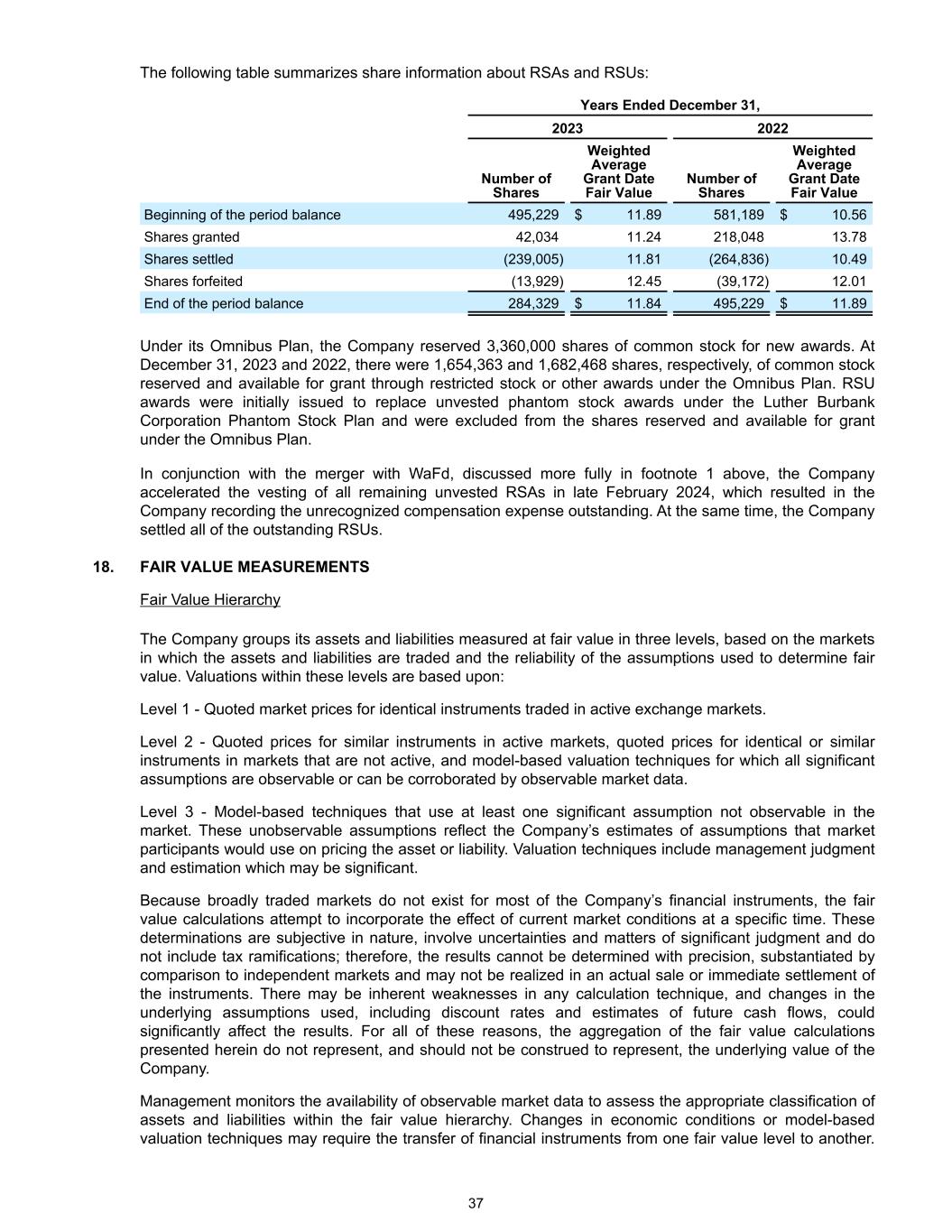
The following table summarizes share information about RSAs and RSUs: Years Ended December 31, 2023 2022 Number of Shares Weighted Average Grant Date Fair Value Number of Shares Weighted Average Grant Date Fair Value Beginning of the period balance 495,229 $ 11.89 581,189 $ 10.56 Shares granted 42,034 11.24 218,048 13.78 Shares settled (239,005) 11.81 (264,836) 10.49 Shares forfeited (13,929) 12.45 (39,172) 12.01 End of the period balance 284,329 $ 11.84 495,229 $ 11.89 Under its Omnibus Plan, the Company reserved 3,360,000 shares of common stock for new awards. At December 31, 2023 and 2022, there were 1,654,363 and 1,682,468 shares, respectively, of common stock reserved and available for grant through restricted stock or other awards under the Omnibus Plan. RSU awards were initially issued to replace unvested phantom stock awards under the Luther Burbank Corporation Phantom Stock Plan and were excluded from the shares reserved and available for grant under the Omnibus Plan. In conjunction with the merger with WaFd, discussed more fully in footnote 1 above, the Company accelerated the vesting of all remaining unvested RSAs in late February 2024, which resulted in the Company recording the unrecognized compensation expense outstanding. At the same time, the Company settled all of the outstanding RSUs. 18. FAIR VALUE MEASUREMENTS Fair Value Hierarchy The Company groups its assets and liabilities measured at fair value in three levels, based on the markets in which the assets and liabilities are traded and the reliability of the assumptions used to determine fair value. Valuations within these levels are based upon: Level 1 - Quoted market prices for identical instruments traded in active exchange markets. Level 2 - Quoted prices for similar instruments in active markets, quoted prices for identical or similar instruments in markets that are not active, and model-based valuation techniques for which all significant assumptions are observable or can be corroborated by observable market data. Level 3 - Model-based techniques that use at least one significant assumption not observable in the market. These unobservable assumptions reflect the Company’s estimates of assumptions that market participants would use on pricing the asset or liability. Valuation techniques include management judgment and estimation which may be significant. Because broadly traded markets do not exist for most of the Company’s financial instruments, the fair value calculations attempt to incorporate the effect of current market conditions at a specific time. These determinations are subjective in nature, involve uncertainties and matters of significant judgment and do not include tax ramifications; therefore, the results cannot be determined with precision, substantiated by comparison to independent markets and may not be realized in an actual sale or immediate settlement of the instruments. There may be inherent weaknesses in any calculation technique, and changes in the underlying assumptions used, including discount rates and estimates of future cash flows, could significantly affect the results. For all of these reasons, the aggregation of the fair value calculations presented herein do not represent, and should not be construed to represent, the underlying value of the Company. Management monitors the availability of observable market data to assess the appropriate classification of assets and liabilities within the fair value hierarchy. Changes in economic conditions or model-based valuation techniques may require the transfer of financial instruments from one fair value level to another. 37
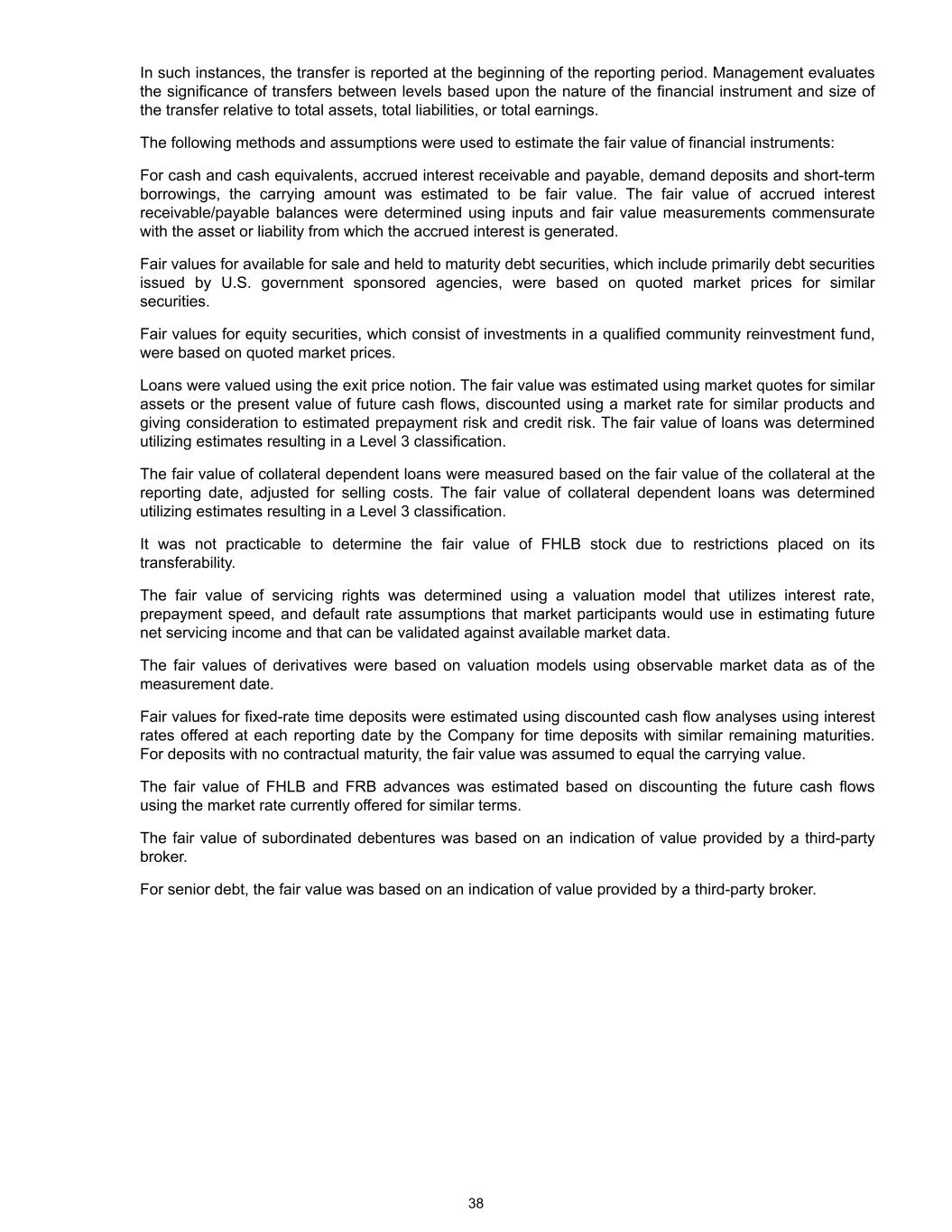
In such instances, the transfer is reported at the beginning of the reporting period. Management evaluates the significance of transfers between levels based upon the nature of the financial instrument and size of the transfer relative to total assets, total liabilities, or total earnings. The following methods and assumptions were used to estimate the fair value of financial instruments: For cash and cash equivalents, accrued interest receivable and payable, demand deposits and short-term borrowings, the carrying amount was estimated to be fair value. The fair value of accrued interest receivable/payable balances were determined using inputs and fair value measurements commensurate with the asset or liability from which the accrued interest is generated. Fair values for available for sale and held to maturity debt securities, which include primarily debt securities issued by U.S. government sponsored agencies, were based on quoted market prices for similar securities. Fair values for equity securities, which consist of investments in a qualified community reinvestment fund, were based on quoted market prices. Loans were valued using the exit price notion. The fair value was estimated using market quotes for similar assets or the present value of future cash flows, discounted using a market rate for similar products and giving consideration to estimated prepayment risk and credit risk. The fair value of loans was determined utilizing estimates resulting in a Level 3 classification. The fair value of collateral dependent loans were measured based on the fair value of the collateral at the reporting date, adjusted for selling costs. The fair value of collateral dependent loans was determined utilizing estimates resulting in a Level 3 classification. It was not practicable to determine the fair value of FHLB stock due to restrictions placed on its transferability. The fair value of servicing rights was determined using a valuation model that utilizes interest rate, prepayment speed, and default rate assumptions that market participants would use in estimating future net servicing income and that can be validated against available market data. The fair values of derivatives were based on valuation models using observable market data as of the measurement date. Fair values for fixed-rate time deposits were estimated using discounted cash flow analyses using interest rates offered at each reporting date by the Company for time deposits with similar remaining maturities. For deposits with no contractual maturity, the fair value was assumed to equal the carrying value. The fair value of FHLB and FRB advances was estimated based on discounting the future cash flows using the market rate currently offered for similar terms. The fair value of subordinated debentures was based on an indication of value provided by a third-party broker. For senior debt, the fair value was based on an indication of value provided by a third-party broker. 38
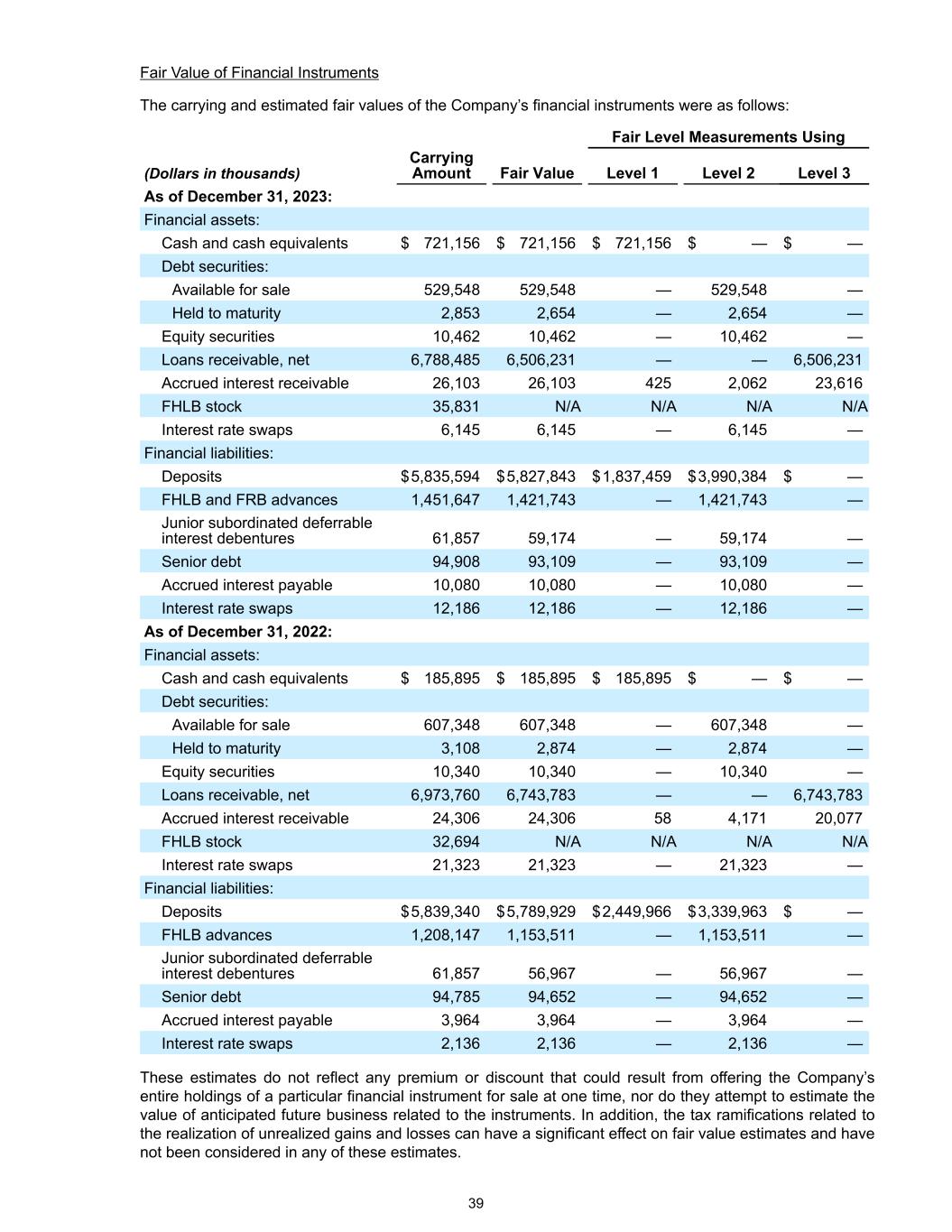
Fair Value of Financial Instruments The carrying and estimated fair values of the Company’s financial instruments were as follows: Fair Level Measurements Using (Dollars in thousands) Carrying Amount Fair Value Level 1 Level 2 Level 3 As of December 31, 2023: Financial assets: Cash and cash equivalents $ 721,156 $ 721,156 $ 721,156 $ — $ — Debt securities: Available for sale 529,548 529,548 — 529,548 — Held to maturity 2,853 2,654 — 2,654 — Equity securities 10,462 10,462 — 10,462 — Loans receivable, net 6,788,485 6,506,231 — — 6,506,231 Accrued interest receivable 26,103 26,103 425 2,062 23,616 FHLB stock 35,831 N/A N/A N/A N/A Interest rate swaps 6,145 6,145 — 6,145 — Financial liabilities: Deposits $ 5,835,594 $ 5,827,843 $ 1,837,459 $ 3,990,384 $ — FHLB and FRB advances 1,451,647 1,421,743 — 1,421,743 — Junior subordinated deferrable interest debentures 61,857 59,174 — 59,174 — Senior debt 94,908 93,109 — 93,109 — Accrued interest payable 10,080 10,080 — 10,080 — Interest rate swaps 12,186 12,186 — 12,186 — As of December 31, 2022: Financial assets: Cash and cash equivalents $ 185,895 $ 185,895 $ 185,895 $ — $ — Debt securities: Available for sale 607,348 607,348 — 607,348 — Held to maturity 3,108 2,874 — 2,874 — Equity securities 10,340 10,340 — 10,340 — Loans receivable, net 6,973,760 6,743,783 — — 6,743,783 Accrued interest receivable 24,306 24,306 58 4,171 20,077 FHLB stock 32,694 N/A N/A N/A N/A Interest rate swaps 21,323 21,323 — 21,323 — Financial liabilities: Deposits $ 5,839,340 $ 5,789,929 $ 2,449,966 $ 3,339,963 $ — FHLB advances 1,208,147 1,153,511 — 1,153,511 — Junior subordinated deferrable interest debentures 61,857 56,967 — 56,967 — Senior debt 94,785 94,652 — 94,652 — Accrued interest payable 3,964 3,964 — 3,964 — Interest rate swaps 2,136 2,136 — 2,136 — These estimates do not reflect any premium or discount that could result from offering the Company’s entire holdings of a particular financial instrument for sale at one time, nor do they attempt to estimate the value of anticipated future business related to the instruments. In addition, the tax ramifications related to the realization of unrealized gains and losses can have a significant effect on fair value estimates and have not been considered in any of these estimates. 39
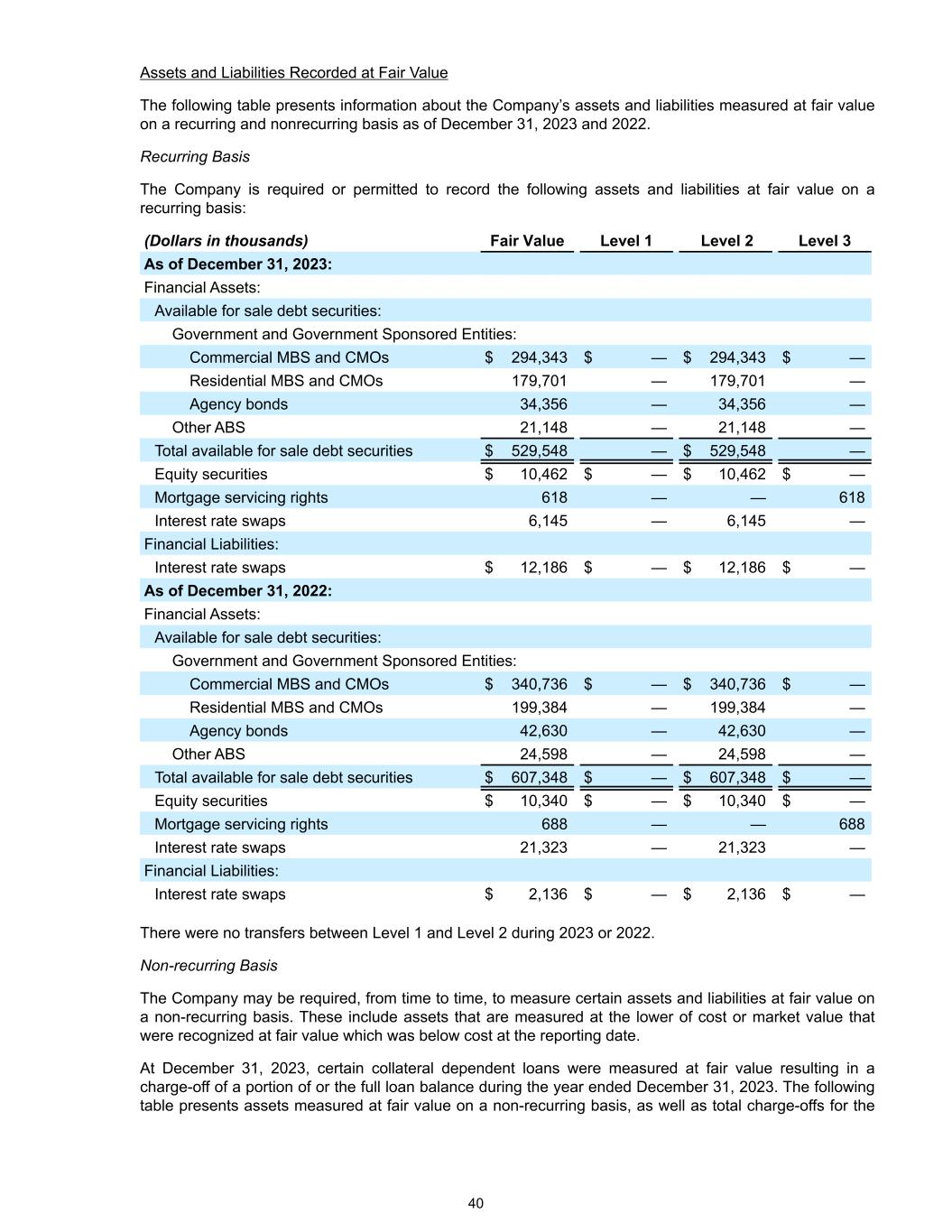
Assets and Liabilities Recorded at Fair Value The following table presents information about the Company’s assets and liabilities measured at fair value on a recurring and nonrecurring basis as of December 31, 2023 and 2022. Recurring Basis The Company is required or permitted to record the following assets and liabilities at fair value on a recurring basis: (Dollars in thousands) Fair Value Level 1 Level 2 Level 3 As of December 31, 2023: Financial Assets: Available for sale debt securities: Government and Government Sponsored Entities: Commercial MBS and CMOs $ 294,343 $ — $ 294,343 $ — Residential MBS and CMOs 179,701 — 179,701 — Agency bonds 34,356 — 34,356 — Other ABS 21,148 — 21,148 — Total available for sale debt securities $ 529,548 — $ 529,548 — Equity securities $ 10,462 $ — $ 10,462 $ — Mortgage servicing rights 618 — — 618 Interest rate swaps 6,145 — 6,145 — Financial Liabilities: Interest rate swaps $ 12,186 $ — $ 12,186 $ — As of December 31, 2022: Financial Assets: Available for sale debt securities: Government and Government Sponsored Entities: Commercial MBS and CMOs $ 340,736 $ — $ 340,736 $ — Residential MBS and CMOs 199,384 — 199,384 — Agency bonds 42,630 — 42,630 — Other ABS 24,598 — 24,598 — Total available for sale debt securities $ 607,348 $ — $ 607,348 $ — Equity securities $ 10,340 $ — $ 10,340 $ — Mortgage servicing rights 688 — — 688 Interest rate swaps 21,323 — 21,323 — Financial Liabilities: Interest rate swaps $ 2,136 $ — $ 2,136 $ — There were no transfers between Level 1 and Level 2 during 2023 or 2022. Non-recurring Basis The Company may be required, from time to time, to measure certain assets and liabilities at fair value on a non-recurring basis. These include assets that are measured at the lower of cost or market value that were recognized at fair value which was below cost at the reporting date. At December 31, 2023, certain collateral dependent loans were measured at fair value resulting in a charge-off of a portion of or the full loan balance during the year ended December 31, 2023. The following table presents assets measured at fair value on a non-recurring basis, as well as total charge-offs for the 40
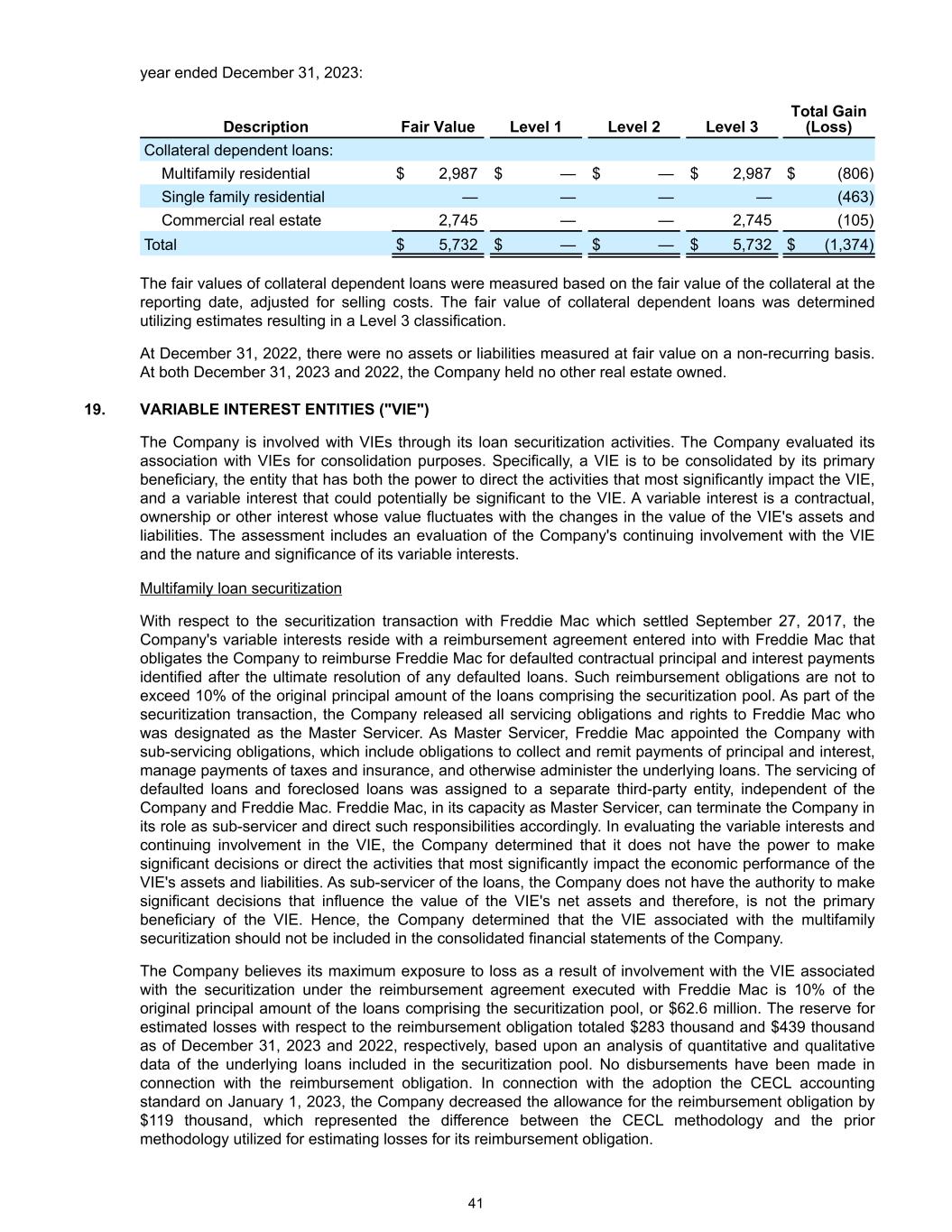
year ended December 31, 2023: Description Fair Value Level 1 Level 2 Level 3 Total Gain (Loss) Collateral dependent loans: Multifamily residential $ 2,987 $ — $ — $ 2,987 $ (806) Single family residential — — — — (463) Commercial real estate 2,745 — — 2,745 (105) Total $ 5,732 $ — $ — $ 5,732 $ (1,374) The fair values of collateral dependent loans were measured based on the fair value of the collateral at the reporting date, adjusted for selling costs. The fair value of collateral dependent loans was determined utilizing estimates resulting in a Level 3 classification. At December 31, 2022, there were no assets or liabilities measured at fair value on a non-recurring basis. At both December 31, 2023 and 2022, the Company held no other real estate owned. 19. VARIABLE INTEREST ENTITIES ("VIE") The Company is involved with VIEs through its loan securitization activities. The Company evaluated its association with VIEs for consolidation purposes. Specifically, a VIE is to be consolidated by its primary beneficiary, the entity that has both the power to direct the activities that most significantly impact the VIE, and a variable interest that could potentially be significant to the VIE. A variable interest is a contractual, ownership or other interest whose value fluctuates with the changes in the value of the VIE's assets and liabilities. The assessment includes an evaluation of the Company's continuing involvement with the VIE and the nature and significance of its variable interests. Multifamily loan securitization With respect to the securitization transaction with Freddie Mac which settled September 27, 2017, the Company's variable interests reside with a reimbursement agreement entered into with Freddie Mac that obligates the Company to reimburse Freddie Mac for defaulted contractual principal and interest payments identified after the ultimate resolution of any defaulted loans. Such reimbursement obligations are not to exceed 10% of the original principal amount of the loans comprising the securitization pool. As part of the securitization transaction, the Company released all servicing obligations and rights to Freddie Mac who was designated as the Master Servicer. As Master Servicer, Freddie Mac appointed the Company with sub-servicing obligations, which include obligations to collect and remit payments of principal and interest, manage payments of taxes and insurance, and otherwise administer the underlying loans. The servicing of defaulted loans and foreclosed loans was assigned to a separate third-party entity, independent of the Company and Freddie Mac. Freddie Mac, in its capacity as Master Servicer, can terminate the Company in its role as sub-servicer and direct such responsibilities accordingly. In evaluating the variable interests and continuing involvement in the VIE, the Company determined that it does not have the power to make significant decisions or direct the activities that most significantly impact the economic performance of the VIE's assets and liabilities. As sub-servicer of the loans, the Company does not have the authority to make significant decisions that influence the value of the VIE's net assets and therefore, is not the primary beneficiary of the VIE. Hence, the Company determined that the VIE associated with the multifamily securitization should not be included in the consolidated financial statements of the Company. The Company believes its maximum exposure to loss as a result of involvement with the VIE associated with the securitization under the reimbursement agreement executed with Freddie Mac is 10% of the original principal amount of the loans comprising the securitization pool, or $62.6 million. The reserve for estimated losses with respect to the reimbursement obligation totaled $283 thousand and $439 thousand as of December 31, 2023 and 2022, respectively, based upon an analysis of quantitative and qualitative data of the underlying loans included in the securitization pool. No disbursements have been made in connection with the reimbursement obligation. In connection with the adoption the CECL accounting standard on January 1, 2023, the Company decreased the allowance for the reimbursement obligation by $119 thousand, which represented the difference between the CECL methodology and the prior methodology utilized for estimating losses for its reimbursement obligation. 41
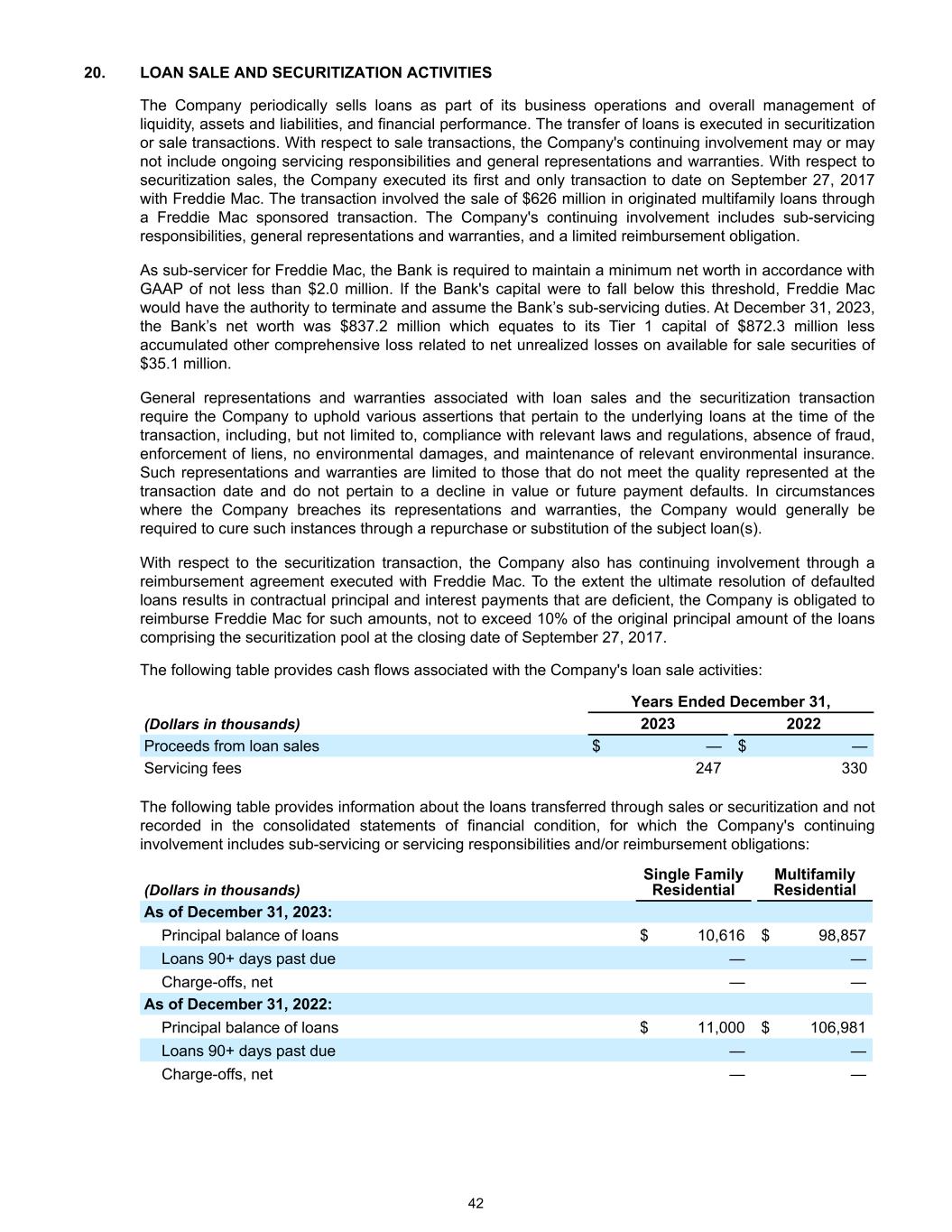
20. LOAN SALE AND SECURITIZATION ACTIVITIES The Company periodically sells loans as part of its business operations and overall management of liquidity, assets and liabilities, and financial performance. The transfer of loans is executed in securitization or sale transactions. With respect to sale transactions, the Company's continuing involvement may or may not include ongoing servicing responsibilities and general representations and warranties. With respect to securitization sales, the Company executed its first and only transaction to date on September 27, 2017 with Freddie Mac. The transaction involved the sale of $626 million in originated multifamily loans through a Freddie Mac sponsored transaction. The Company's continuing involvement includes sub-servicing responsibilities, general representations and warranties, and a limited reimbursement obligation. As sub-servicer for Freddie Mac, the Bank is required to maintain a minimum net worth in accordance with GAAP of not less than $2.0 million. If the Bank's capital were to fall below this threshold, Freddie Mac would have the authority to terminate and assume the Bank’s sub-servicing duties. At December 31, 2023, the Bank’s net worth was $837.2 million which equates to its Tier 1 capital of $872.3 million less accumulated other comprehensive loss related to net unrealized losses on available for sale securities of $35.1 million. General representations and warranties associated with loan sales and the securitization transaction require the Company to uphold various assertions that pertain to the underlying loans at the time of the transaction, including, but not limited to, compliance with relevant laws and regulations, absence of fraud, enforcement of liens, no environmental damages, and maintenance of relevant environmental insurance. Such representations and warranties are limited to those that do not meet the quality represented at the transaction date and do not pertain to a decline in value or future payment defaults. In circumstances where the Company breaches its representations and warranties, the Company would generally be required to cure such instances through a repurchase or substitution of the subject loan(s). With respect to the securitization transaction, the Company also has continuing involvement through a reimbursement agreement executed with Freddie Mac. To the extent the ultimate resolution of defaulted loans results in contractual principal and interest payments that are deficient, the Company is obligated to reimburse Freddie Mac for such amounts, not to exceed 10% of the original principal amount of the loans comprising the securitization pool at the closing date of September 27, 2017. The following table provides cash flows associated with the Company's loan sale activities: Years Ended December 31, (Dollars in thousands) 2023 2022 Proceeds from loan sales $ — $ — Servicing fees 247 330 The following table provides information about the loans transferred through sales or securitization and not recorded in the consolidated statements of financial condition, for which the Company's continuing involvement includes sub-servicing or servicing responsibilities and/or reimbursement obligations: (Dollars in thousands) Single Family Residential Multifamily Residential As of December 31, 2023: Principal balance of loans $ 10,616 $ 98,857 Loans 90+ days past due — — Charge-offs, net — — As of December 31, 2022: Principal balance of loans $ 11,000 $ 106,981 Loans 90+ days past due — — Charge-offs, net — — 42
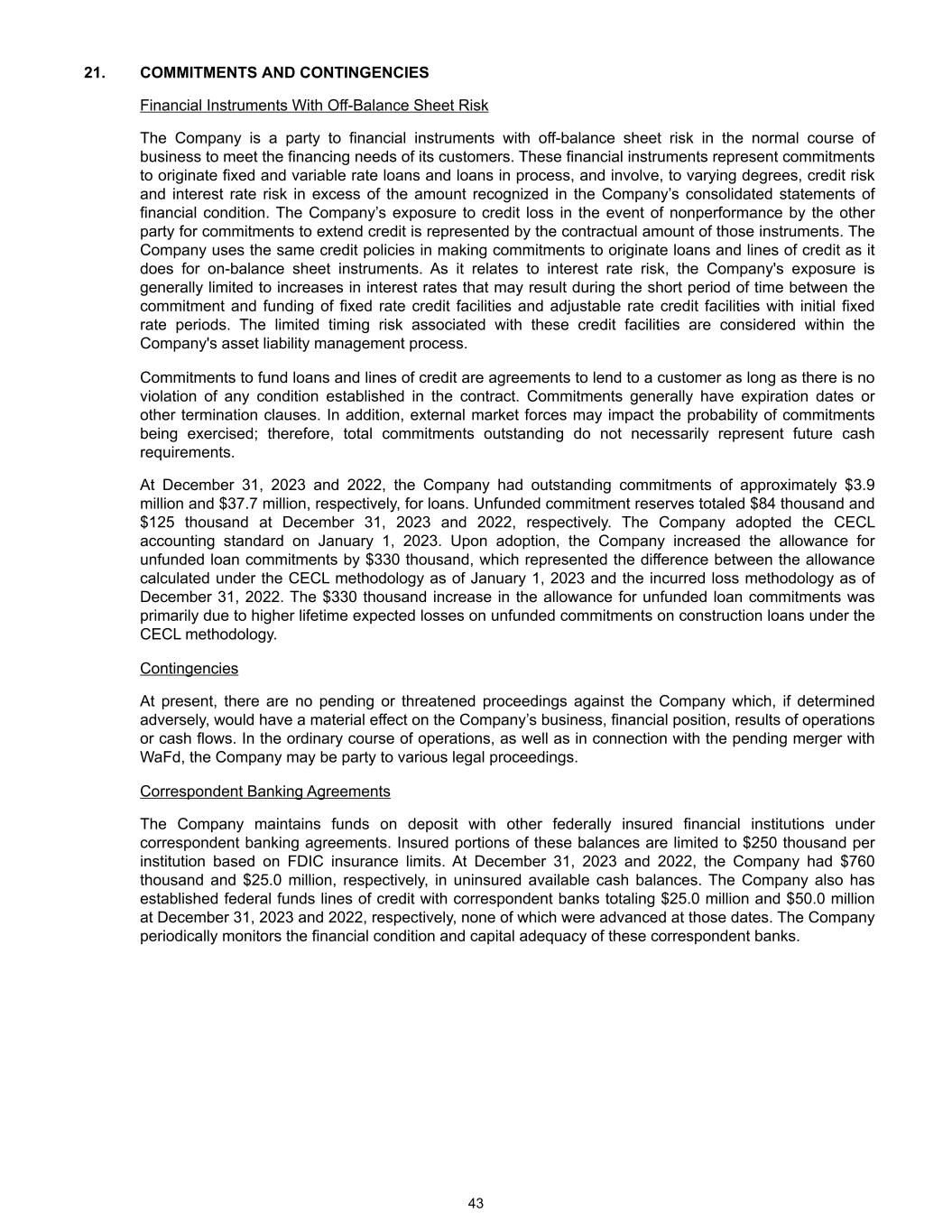
21. COMMITMENTS AND CONTINGENCIES Financial Instruments With Off-Balance Sheet Risk The Company is a party to financial instruments with off-balance sheet risk in the normal course of business to meet the financing needs of its customers. These financial instruments represent commitments to originate fixed and variable rate loans and loans in process, and involve, to varying degrees, credit risk and interest rate risk in excess of the amount recognized in the Company’s consolidated statements of financial condition. The Company’s exposure to credit loss in the event of nonperformance by the other party for commitments to extend credit is represented by the contractual amount of those instruments. The Company uses the same credit policies in making commitments to originate loans and lines of credit as it does for on-balance sheet instruments. As it relates to interest rate risk, the Company's exposure is generally limited to increases in interest rates that may result during the short period of time between the commitment and funding of fixed rate credit facilities and adjustable rate credit facilities with initial fixed rate periods. The limited timing risk associated with these credit facilities are considered within the Company's asset liability management process. Commitments to fund loans and lines of credit are agreements to lend to a customer as long as there is no violation of any condition established in the contract. Commitments generally have expiration dates or other termination clauses. In addition, external market forces may impact the probability of commitments being exercised; therefore, total commitments outstanding do not necessarily represent future cash requirements. At December 31, 2023 and 2022, the Company had outstanding commitments of approximately $3.9 million and $37.7 million, respectively, for loans. Unfunded commitment reserves totaled $84 thousand and $125 thousand at December 31, 2023 and 2022, respectively. The Company adopted the CECL accounting standard on January 1, 2023. Upon adoption, the Company increased the allowance for unfunded loan commitments by $330 thousand, which represented the difference between the allowance calculated under the CECL methodology as of January 1, 2023 and the incurred loss methodology as of December 31, 2022. The $330 thousand increase in the allowance for unfunded loan commitments was primarily due to higher lifetime expected losses on unfunded commitments on construction loans under the CECL methodology. Contingencies At present, there are no pending or threatened proceedings against the Company which, if determined adversely, would have a material effect on the Company’s business, financial position, results of operations or cash flows. In the ordinary course of operations, as well as in connection with the pending merger with WaFd, the Company may be party to various legal proceedings. Correspondent Banking Agreements The Company maintains funds on deposit with other federally insured financial institutions under correspondent banking agreements. Insured portions of these balances are limited to $250 thousand per institution based on FDIC insurance limits. At December 31, 2023 and 2022, the Company had $760 thousand and $25.0 million, respectively, in uninsured available cash balances. The Company also has established federal funds lines of credit with correspondent banks totaling $25.0 million and $50.0 million at December 31, 2023 and 2022, respectively, none of which were advanced at those dates. The Company periodically monitors the financial condition and capital adequacy of these correspondent banks. 43
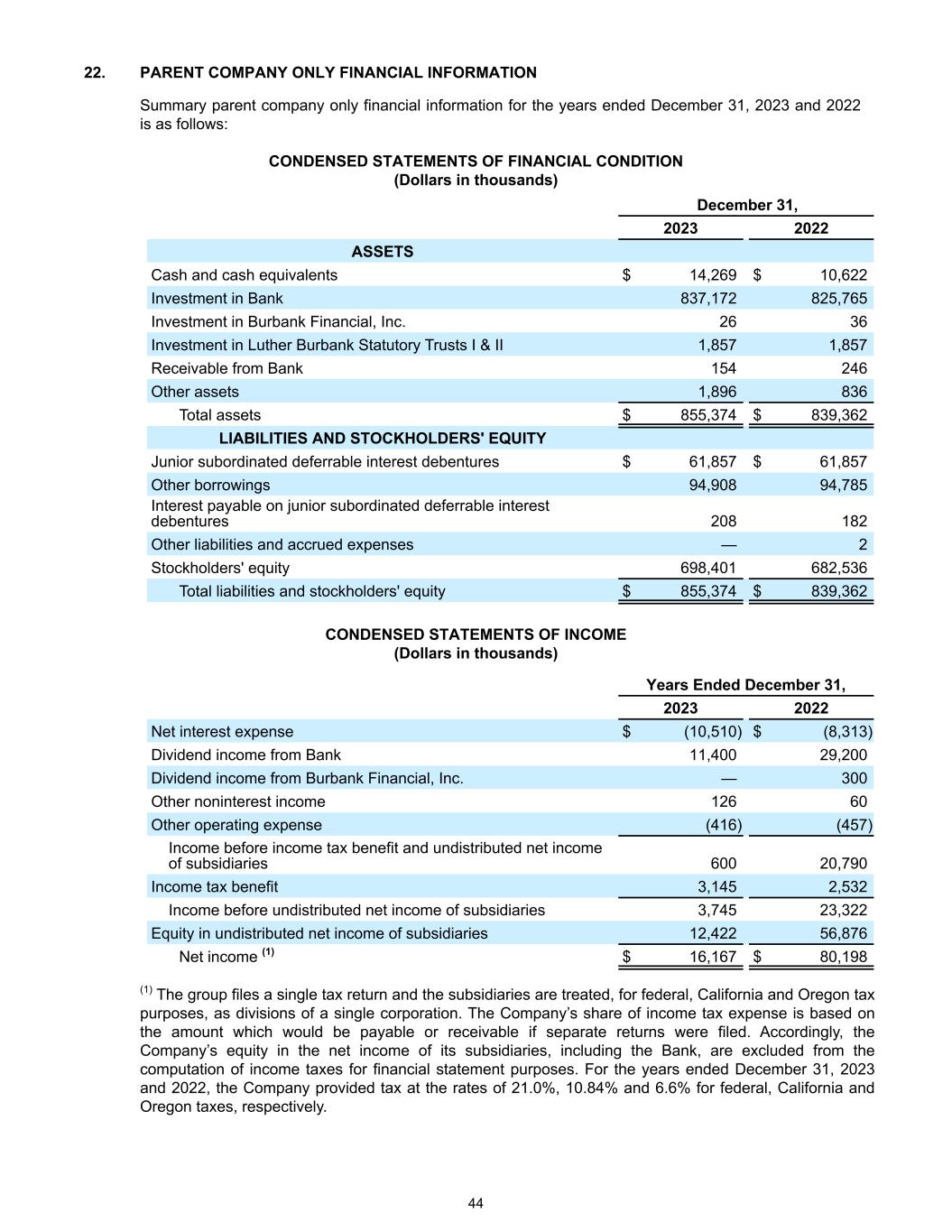
22. PARENT COMPANY ONLY FINANCIAL INFORMATION Summary parent company only financial information for the years ended December 31, 2023 and 2022 is as follows: CONDENSED STATEMENTS OF FINANCIAL CONDITION (Dollars in thousands) December 31, 2023 2022 ASSETS Cash and cash equivalents $ 14,269 $ 10,622 Investment in Bank 837,172 825,765 Investment in Burbank Financial, Inc. 26 36 Investment in Luther Burbank Statutory Trusts I & II 1,857 1,857 Receivable from Bank 154 246 Other assets 1,896 836 Total assets $ 855,374 $ 839,362 LIABILITIES AND STOCKHOLDERS' EQUITY Junior subordinated deferrable interest debentures $ 61,857 $ 61,857 Other borrowings 94,908 94,785 Interest payable on junior subordinated deferrable interest debentures 208 182 Other liabilities and accrued expenses — 2 Stockholders' equity 698,401 682,536 Total liabilities and stockholders' equity $ 855,374 $ 839,362 CONDENSED STATEMENTS OF INCOME (Dollars in thousands) Years Ended December 31, 2023 2022 Net interest expense $ (10,510) $ (8,313) Dividend income from Bank 11,400 29,200 Dividend income from Burbank Financial, Inc. — 300 Other noninterest income 126 60 Other operating expense (416) (457) Income before income tax benefit and undistributed net income of subsidiaries 600 20,790 Income tax benefit 3,145 2,532 Income before undistributed net income of subsidiaries 3,745 23,322 Equity in undistributed net income of subsidiaries 12,422 56,876 Net income (1) $ 16,167 $ 80,198 (1) The group files a single tax return and the subsidiaries are treated, for federal, California and Oregon tax purposes, as divisions of a single corporation. The Company’s share of income tax expense is based on the amount which would be payable or receivable if separate returns were filed. Accordingly, the Company’s equity in the net income of its subsidiaries, including the Bank, are excluded from the computation of income taxes for financial statement purposes. For the years ended December 31, 2023 and 2022, the Company provided tax at the rates of 21.0%, 10.84% and 6.6% for federal, California and Oregon taxes, respectively. 44
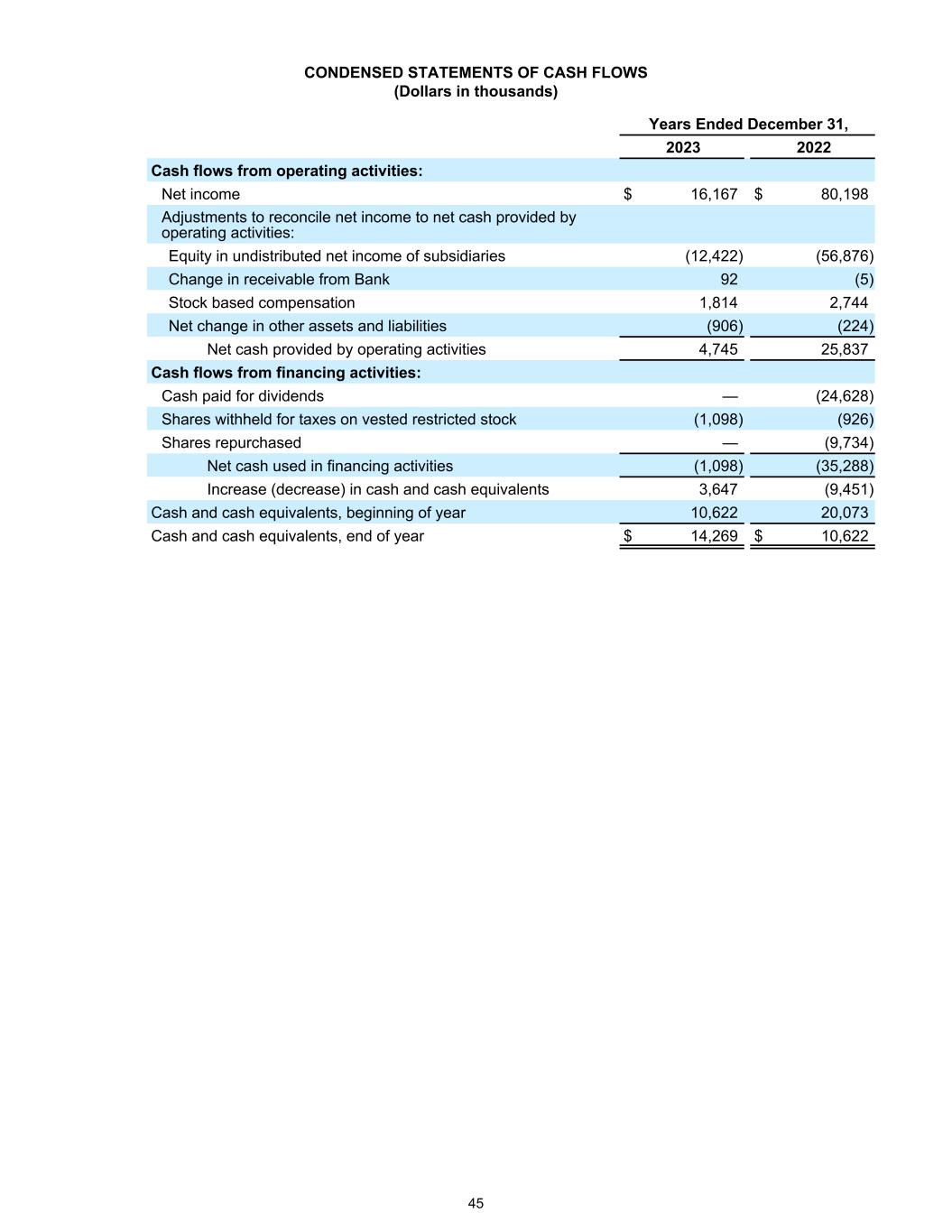
CONDENSED STATEMENTS OF CASH FLOWS (Dollars in thousands) Years Ended December 31, 2023 2022 Cash flows from operating activities: Net income $ 16,167 $ 80,198 Adjustments to reconcile net income to net cash provided by operating activities: Equity in undistributed net income of subsidiaries (12,422) (56,876) Change in receivable from Bank 92 (5) Stock based compensation 1,814 2,744 Net change in other assets and liabilities (906) (224) Net cash provided by operating activities 4,745 25,837 Cash flows from financing activities: Cash paid for dividends — (24,628) Shares withheld for taxes on vested restricted stock (1,098) (926) Shares repurchased — (9,734) Net cash used in financing activities (1,098) (35,288) Increase (decrease) in cash and cash equivalents 3,647 (9,451) Cash and cash equivalents, beginning of year 10,622 20,073 Cash and cash equivalents, end of year $ 14,269 $ 10,622 45